











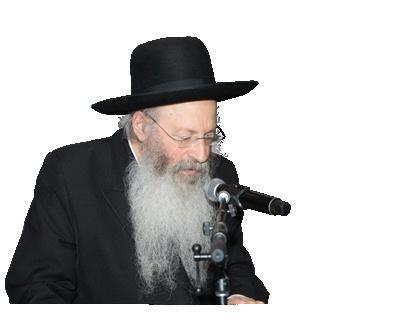
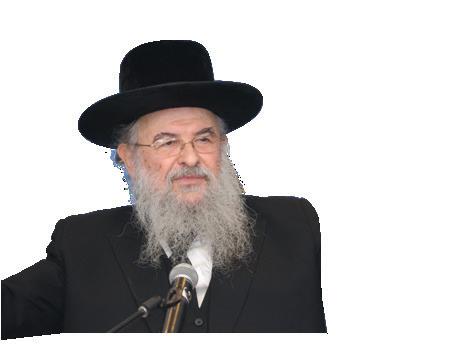
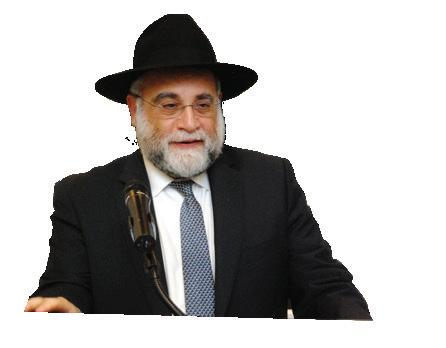












































Have you ever worn a sweater that’s just a bit tight? Maybe it was a shirt that fit you just-so before yom tov and then felt a bit too constrictive after so many days of meals? You go through your day, do your thing – work, carpools, shopping, davening – but everything feels a bit too snug. All day, with everything you do, you just can’t wait to get home and get out of this sweater that’s been holding you too tight.
The Jewish nation has been in galus for far too long. For hundreds of years, we’ve been wanderers, strangers in strange lands. Sometimes, those lands and people with whom we’ve sojourned have welcomed us with open arms. They’ve allowed us to settle comfortably and worship our G-d without restriction. We’ve felt relief, undisturbed, and perhaps even forgot that we were supposed to be longing for another, higher reality.
But then, as the ways of the world ebb and flow, after a few generations, the people welcoming us become not so welcoming. They remind us that we’re “the other.” They begin to blame us for their problems. Maybe there are slurs and spittings, swastikas and smears. We’re shunned at universities, demoted in our jobs, demoralized in the newspapers. Life becomes less peaceful, less comfortable, and
we’re reminded – once again – that our truest desire is to be One with our Creator, to be able to live on a higher realm, to be united with all our brothers and sisters in the Holy Land.
I think of galus a bit like that sweater we’ve been wearing. There are times when it’s loose and easy. We barely feel like we have it on. It provides warmth, and it’s cozy. But then, there are times when Hashem needs to send us a little reminder of who we are and where we should be heading. And slowly, that sweater becomes a bit tight. It’s like it shrunk in the wash. Same sweater, but now, as we go throughout our day, we’re reminded that we’re not in the optimal place in our nation’s history. Galus becomes a more conscious reality; we’re more aware of who we are as a people.
When we begin to feel that constriction, it may cause us to fear our surroundings and our situation. But if we keep in mind that this is Hashem’s way of giving us a heightened sense of the significance of pursuing our real goals in life, then we would understand that G-d is pushing us into the next stage of history, when His majesty will be revealed to all, may it come soon in our days.
Wishing you a wonderful week, Shoshana

Yitzy Halpern, PUBLISHER publisher@fivetownsjewishhome.com
Yosef Feinerman, MANAGING EDITOR ads@fivetownsjewishhome.com
Shoshana Soroka, EDITOR editor@fivetownsjewishhome.com
Nate Davis
Editorial Assistant
Nechama Wein
Copy Editor
Rachel Bergida
Shana Brecher
Lani White
Design & Production
Gabe Solomon
Distribution & Logistics
P.O. BOX 266
Lawrence, NY 11559
Phone | 516-734-0858
Fax | 516-734-0857
Classified Deadline: Monday 5:00PM classifieds@fivetownsjewishhome.com text 443-929-4003
PAYMENT VIA CREDIT CARD MUST BE SUBMITTED ALONG WITH CLASSIFIED ADS
The Jewish Home is an independent weekly magazine. Opinions expressed by writers are not necessarily the opinions of the publisher or editor. The Jewish Home is not responsible for typographical errors, or for the kashrus of any product or business advertised within. The Jewish Home contains words of Torah. Please treat accordingly.











Dear Editor,
I heard a fascinating insight from a rav that enables one to love his neighbor even if one doesn’t naturally feel it or doesn’t mesh with that person. He offers a new reading of the words (Vayikra 19:18), “Ve’ahavta lere’acha kamocha — Love your neighbor as yourself.”
He notes that a comma should be inserted after the first two words: “Ve’ahavta lere’acha, Love your friend.” Then comes the word kamocha, which he explains refers to Him, G-d, not to yourself. In other words, you must love your friend as G-d does. It might be said that this is bolstered by the next two words in the verse, “Ani Hashem.” Loving your friend is based on G-d’s love for him, not your own subjective love.
Based on this standard, one need not break barriers where personality differences exist but merely love someone because G-d created them. This understanding opens the door to building love for any fellow human being.
Steven Genack
Dear Editor,
Although I appreciate Nate Davis’s effort to spin the Mamdani victory, I think that it’s cheap to lean on “Hashem’s got this” after the fact. Why does everyone make us crazy to go vote (“don’t show up at school if you didn’t vote”) and then say it’s all up to Hashem anyway? Why don’t they have emunah before the elections? Why all of the pressure? Don’t they trust in Hashem before the elections, too? And, if Momdani lost, would everyone run around saying, “Hashem got this”? No, they would talk about how we are a voting bloc to be reckoned with…we are
powerful…we call the shots! I’m not minimizing bitachon – I’m just saying that selective bitachon should not be a strategy. Either have bitachon all the way and leave it to Hashem (that’s my recommendation) or think that it’s in your control and you will be reminded over and over that it’s not.
Yissachar Isaacs
Dear Editor,
Mamdani’s shocking victory is about to take a ruinous bite out of the Big Apple, a bite that portends disaster for a once fruitful and thriving metropolis. The core of the apple is about to be exposed, revealing the newly inserted seeds of hatred and antisemitism that the incoming mayor is so eager to plant. The five boroughs of New York City and adjoining areas are in for a rude awakening. Mamdani’s upcoming harvest will most assuredly add sustenance to the ever-increasing antisemitism that we encounter nearly every day.
Shmuel Herschkovitz Lawrence, NY
Dear Editor,
The 10th of Teves this year is two days before Zoran Mandami takes office, although we do not fast regarding troubles that occur generally. (Shulchan Aruch, Orach Chayim 288:8) Perhaps we should think about an exception, and if not, we can have our current troubles in mind during the 10th of Teves.
“And the people of Nineveh believed in G-d, and they proclaimed a fast and donned sackcloth, from their greatest to their smallest.” (Yona:3) This concept isn’t just for a unique time but for all Continued on page 14



















































times: “Go, gather all the Jews who are found in Shushan, and fast for me; neither eat nor drink for three days, night or day. I also and my maidens will fast in like manner, and so will I go in to the king, which is not according to the law; and if I perish, I perish.” (Esther 4:16)
This new political chapter we find ourselves in feels like a siege. The new mayor wants to lower the number of people in the police force. How should one think that would affect us if the mayor believed in “globalize the intifada,” AKA free-forall violence and murder on the non-believers.
The BDS movement that our new mayor wants to push is not simply an economic embargo against people from the land of Israel as it is not against nonJews from Eretz Yisrael but only against Bnei Yisrael. Do we really think a New Yorker with the German name of “Teitelbaum” would not lose a government contract and not be audited just for that last name? (We know the IRS on the federal level audited corporations with “conservative” sounding names.)
“And I set my face unto the L-rd G-d, to seek by prayer and supplications, with fasting, and sackcloth, and ashes.” (Daniel 9:3)
Abe Cohen
Dear Editor,
It is very disheartening to see how many mispallelim rush out of shul at the end of davening as Tehillim are recited for the welfare of the Jewish people around the world.
The Gaza war may be officially over but sporadic terrorist attacks against Jews still continue globally.
A few seconds of additional prayer
is the least we should do for our endan
gered brothers and sisters.
Henry Moscovic
Flushing, NY
Dear Editor,
On Tuesday, November 4, 2025, New York City elected Zohran Mamdani as its 111th Mayor. As a self-proclaimed Democratic Socialist, many even label him a Communist. His radical agenda includes free buses, government-run grocery stores, universal childcare, and the closure of city jails. These policies would bring smiles to the faces of figures like Joseph Stalin and Karl Marx. He has also pledged to arrest Israeli Prime Minister Benjamin Netanyahu if he ever visits the city and has vowed to end all financial ties between New York City and Israel, irrespective of the legality of such actions.
Honestly, for someone with as little background experience as him, including a legislative record of passing only three bills in the Assembly, his agenda and belief that money grows on trees is not surprising. As the exodus from Gotham City begins, with an estimated 1 to 2 million people expected to leave, the city’s landscape is poised for significant transformation, as history has shown, communist ideologies tend to deter people – some examples include Cuba, which from Castros takeover in 1959 to the end of the Cold War 32 years later, 800,000 Cubans exiled to the US (Most settling in Miami), and even since 1991 roughly 2.2 million Cubans exiled to the states – and with these trends continuing, New York City is poised to become the next Cuba, unless we take action to counter the radicalization and Islamization of our great nation.
Aryeh Schiff






as well as large crowds.
The states of Haryana and Uttar Pradesh, which surround Delhi, were also been put on high alert, according to police.
The Red Fort stands as one of India’s most significant historical landmarks.

On Monday, a car explosion ripped through Delhi, India, killing at least ten people and injuring many others.
The blast took place near the city’s iconic Red Fort, also known as the Lal Qila, a 17th century monument and a symbol of India’s independence, where India’s prime ministers generally give their Independence Day speeches. The area is a major tourist hub known for its crowded bazaars and street vendors.
Delhi police are investigating the case under various sections of India’s anti-terror law, North Delhi deputy commissioner of police, Raja Banthia, said.
More than 30 other people were “badly injured” in the blast, said Dr. Manish Kumar Jha, a physician at the local Lok Nayak Hospital. “Many are not in a position of recovering,” he noted.
India’s Prime Minister Narendra Modi offered his condolences to the relatives of those killed. “May the injured recover at the earliest,” he said in a post on X
According to police, a “slow-moving” vehicle “came to a “stop” near a red light in the evening.
Delhi Police Commissioner Satish Golcha noted, “An explosion occurred in that vehicle. The passengers in the vehicle and people in surrounding vehicles were impacted.”
At least six vehicles and three autorickshaws were set on fire. Emergency crews managed to get the blaze under control.
After the explosion, authorities around India scrambled to ensure safety across the country. Airports, railway stations, government buildings and heritage sites were put on high alert, according to the Central Industrial Security Force. The U.S. embassy in New Delhi advised Americans to avoid the surrounding area
Originally built by Emperor Shah Jahan as the palace-fort of his capital, it served as the main residence of Mughal emperors for nearly 200 years. Located in the heart of Old Delhi, the fort is located just a few kilometers from the Parliament of India.
Today, it attracts thousands of daily visitors and holds immense symbolic value for the nation; its ramparts are where Indian prime ministers deliver their annual Independence Day speeches.

Three weeks into his five-year prison term, former French president Nicolas Sarkozy was released from jail. He will be subject to strict judicial supervision and barred from leaving France ahead of an appeal trial due to be held next year.
On October 21, Sarkozy, 70, was sentenced to five years in prison for conspiring to fund his 2007 election campaign with money from late Libyan dictator Muammar Gaddafi.
His legal team immediately filed a request seeking his release.
Writing on social media after the release, Sarkozy said his “energy is focused solely on the single goal of proving my innocence.”
He added, “The truth will prevail... The end of the story is yet to be written.”
Christophe Ingrain, one of Sarkozy’s lawyers, hailed his client’s release as “a step forward” and said they would now be preparing for the appeal trial expected in March.
Sarkozy is not allowed to contact any other witnesses in the so-called “Libyan dossier” or any justice ministry employees.
During his incarceration, he was visited by Justice Minister Gérald Darmanin. The visit prompted 30 French lawyers to

file a complaint against Darmanin, highlighting what they said was a conflict of interest as Darmanin was a former colleague and friend of Sarkozy’s.
Speaking to a court in Paris via video link on Monday morning, Sarkozy described his time in solitary confinement as “grueling” and “a nightmare.” He said he had never had the “mad idea” of asking Gaddafi for money and stated he would “never admit to something I haven’t done.”
Sarkozy is the first French ex-leader placed behind bars since World War II Nazi collaborationist leader Philippe Pétain was jailed for treason in 1945. Sarkozy was president of France from 2007 to 2012.
A 17-year-old boy has been fingered as the person behind the attack on a mosque at a high school during Friday prayers in Jakarta, Indonesia. At least 55 people were injured in the attack, most of them students.
Police are saying that they don’t believe that the attack was terror related.
According to police, the suspect –who was undergoing surgery after the attack and was a student at the school – had assembled a toy submachine gun with words inscribed on it including “14 words. For Agartha,” and “Brenton Tarrant: Welcome to [gehenom].”

“14 words” is generally a reference to a white supremacist slogan. Brenton Tarrant is the perpetrator of a 2019 mass shooting at a mosque and Islamic center in Christchurch, New Zealand, that killed 51 and injured dozens of others.
“We discovered the weapon was a toy gun with specific markings, which we are also investigating to understand the motive, including how he assembled it and carried out the attack,” National Police Chief Listyo Sigit said.
Indonesia is the world’s most populous Muslim-majority country. It has had its share of terror attacks. In 2002, al-Qaeda

staged bombings on the resort island of Bali in which 202 people were killed. In 2011, a Muslim militant blew himself up in a mosque at a police compound in Cirebon packed with officers during Friday prayers, injuring 30 people.
Since 2023, the Southeast Asia nation has experienced what authorities call a “zero attack phenomenon,” crediting the government for the stable security situation.

On Saturday morning, a fire at a perfume depot in northwestern Turkey left six people dead and one person injured.
For now, authorities don’t know what caused the blaze in Kocaeli province, which broke out around 9 a.m. Several explosions preceded the fire. It took emergency teams and firefighters one hour to bring the fire under control.
Turkish President Recep Tayyip Erdogan offered his “deepest condolences to the families” in a statement, noting that the government’s labor ministry has opened an investigation.
The factory is located in the Mimar Sinon neighborhood of Dilovasi, about 43 miles outside Istanbul. The town, which has a population of around 50,000 people, is known for being industrial and is home to numerous depots and factories.

Three astronauts who flew to space in April are now trying to get home.
Wang Jie, Chen Zhongrui and Chen Dong, who were part of the Shenzhou-20 space mission, flew to the Tiangong space station a few months ago. Last week, they
were expected to return home after a sixmonth mission. The Shenzhou-21 crew, who were sent to replace them, had already arrived over the weekend.
According to the China Manned Space Agency, “The Shenzhou-20 crewed spacecraft is suspected to have been struck by a small piece of orbital debris, and assessment of the impact and associated risks is currently underway.
“To ensure the health and safety of the astronauts and the successful completion of the mission, it has been decided that the originally planned return of Shenzhou-20 on November 5 will be postponed.”
Both crews are now onboard Tiangong, a permanently crewed space station operated by the China Manned Space Agency. It is China’s first long-term space station and has spent 1,652 days in orbit.
Tiangong has capacity for six crew –and is currently occupied by astronauts from the Shenzhou-20 and Shenzhou-21 missions.
On Tuesday, the Shenzhou-20 and Shenzhou-21 crews conducted a handover ceremony.
Yu Jun, a science communicator known online as Steed’s Scarf, said a backup plan may be activated if the spacecraft is deemed unsafe to return.
China has continued to expand its space program. It has so far completed 37 flights and six crewed missions and has plans to land astronauts on the moon by the end of the decade.
Chen Dong, the commander of Shenzhou-20, holds the country’s record for the longest time in space –380 days cumulatively.

Hannibal Gadhafi, son of infamous Libyan leader Moammar Gadhafi, was released on Monday after he paid a $900,000 bail, ending his 10-year detention for allegedly withholding information about a missing Lebanese cleric. His lawyer, Charbel Milad al-Khoury, said, “Hannibal is officially free and has the full right to choose the destination that he wants.”



The release came days after Lebanese authorities lifted a travel ban and reduced the bail for Hannibal Gadhafi, paving the way for his release.
Thursday’s decision by the country’s judicial authorities to lift the travel ban and reduce the bail from $11 million came days after a Libyan delegation visited Lebanon and made progress in talks for the release of Gadhafi.
Last month, a Lebanese judge ordered Gadhafi’s release on $11 million bail but banned him from traveling outside Lebanon. His lawyers said at the time that he didn’t have enough money to pay that amount and sought permission for him to leave the country.
On Thursday, his bail was reduced to 80 billion Lebanese pounds (about $900,000) and the travel ban was lifted, allowing him to leave the country once he pays the bail.
Detained in Lebanon in 2015, Gadhafi was accused of withholding information about the fate of Lebanese Shiite cleric Moussa al-Sadr who disappeared during a trip to Libya in 1978. Hannibal Gadhafi was less than 3 years old at the time.
Gadhafi had been living in exile in Syria with his Lebanese wife, Aline Skaf, and children until he was abducted in 2015 and brought to Lebanon by Lebanese mil-
itants who were demanding information about al-Sadr.
The case has been a long-standing sore point in Lebanon. The cleric’s family believes he may still be alive in a Libyan prison, though most Lebanese presume he is dead. He would be 96 years old. Al-Sadr, who went missing with companions Abbas Badreddine and Mohammed Yacoub, was the founder of a Shiite political and military group that took part in the long Lebanese Civil War that began in 1975, largely pitting Muslims against Christians.
Moammar Gadhafi was killed in 2011 during Libya’s civil war. He had ruled Libya for four decades. After Moammar was killed, Hannibal fled to Algeria. He later moved to Syria where he was given political asylum and stayed there until he was taken to Lebanon.
Moammar Gadhafi had eight children from two marriages. Most of them had significant roles in his government. His son Muatassim was killed at the same time as the leader was captured and slain. Two other sons, Saif al-Arab and Khamis, were killed in the uprising.
Saif al-Islam, the one-time heir apparent to his father, has been in Libya since his release from detention there in 2017. Gadhafi’s son Mohammed and daughter
Aisha live in Oman. Al-Saadi, a former soccer player, was released from prison in Libya in 2021 after being jailed following repatriation from Niger in 2014 and is believed to be living in Turkey.

At least six people died after a super typhoon barreled through the Philippines. The storm slammed through just days after an earlier storm left more than 200 people dead.
Super typhoon Fung-wong brought floods and landslides, which caused most of the deaths. It also cut power across entire provinces. It later weakened into a typhoon.
More than 1.4 million people were evacuated ahead of it making landfall
in the Philippines. It is now heading for Taiwan, where more than 30,000 people have been evacuated.
Fung-wong was the 21st typhoon to hit the South East Asian nation this year, at a time when many residents are still struggling to recover from back-to-back natural disasters. Fung-wong, known locally as Uwan, slammed into Aurora province on Luzon Sunday night with sustained winds of around 185 km/h (115 mph) and gusts of 230 km/h.
Although its wind speeds did not come up to par with some of the strongest storms in the Philippines’ history, Fungwong dumped large amounts of rain on the country, leaving some 4,100 houses either totally destroyed or partially damaged.
Fung-wong came just days after typhoon Kalmaegi ripped through the same region, leaving tens of thousands of people reeling and more than 200 people dead. In September, a magnitude 6.9 earthquake hit the province of Cebu.
While the Philippines is prone to natural disasters, this series of catastrophes is “not routine,” the International Federation of Red Cross and Red Crescent Societies said in a statement on Sunday.



This week, Indonesia declared former dictator Suharto a national hero, provoking outrage from rights group who said the move was an attempt to whitewash decades of human rights abuses and corruption that took place during his 32 years in power.
Suharto was a U.S. ally during the Cold War. He presided over decades of authoritarian rule, during which up to a million political opponents were killed. He was toppled by protests in 1998.
Suharto was one of 10 people recognized by President Prabowo Subianto in a televised ceremony held at the presidential palace in Jakarta to mark National Hero Day.
Minister of Culture Fadli Zon said
that Suharto played a key role during the struggle for independence against its Dutch colonial rulers and later served as commander of a military operation that helped take control of what is now West Papua from the Dutch. Zon also said that Suharto was behind alleviating poverty and taming inflation in the country. He also noted that Suharto defeated a communist uprising. He said that allegations of corruption and serious human rights abuses were unproven.
Prabowo was married to Suharto’s daughter from 1983 to 1998. Prabowo also had close ties to Suharto, under whom he rose through the ranks of an Indonesian special forces unit accused of extensive human rights abuses. He and other members of the unit were banned from traveling to the U.S. until 2020, when it was effectively lifted while he was serving Indonesia’s defense minister.
Former President Abdurrahman Wahid, who revoked many of Suharto’s repressive laws, and Marsinah, a prominent labor activist who was killed during the dictatorship, were also among 10 figures recognized as heroes on Monday.
Under Suharto’s rule, soldiers were stationed in every village. He killed hundreds of thousands of political opponents during his time in office. He did not face

trial due to poor health. He died in 2008.
The bulk of killings occurred in 1965-1966 when between 300,000 and 800,000 alleged communists were rounded up and killed during his rise to power. Over the next three decades, a further 300,000 people were killed, disappeared or starved in the independence-minded regions of East Timor, Aceh and Papua, according to human rights groups and the United Nations.
Understandably, survivors of state violence under Suharto voiced outrage about the honor.
“I was shocked, disappointed and angry with this government’s absurd decision,” said Bedjo Untung, who was imprisoned without trial after being accused of involvement with the Indonesian Communist Party and now chairs the 1965 Murder Victim’s Research Foundation.
Untung, who was tortured during his 1970-79 imprisonment, said his family suffered years of discrimination and hardship due to his alleged ties to Communism.

Japan has a bear problem.
Since April 2025, the Japanese government has recorded 13 deaths that came as a result of bear attacks. Just last month, bears attacked a supermarket, a cub scratched a Spanish tourist at a heritage site, and another bear attacked a runner in the woods. Though the number of bear attacks in Japan has been rising over the past years, 2025 has seen record numbers.
In the region of Akita, troops from Japan’s Self-Defense Forces arrived last Thursday to help handle the crisis. However, due to the country’s laws, the soldiers are not permitted to kill the bears. Rather, their role is purely logistical and will include setting up traps and moving bear carcasses. Only licensed hunters and hunting associations are allowed to kill the bears, which is problematic, as there are likely too few licensed hunters to deal with the situation.
“Local governments and hunting associations, who work together as wildlife control teams, are now severely exhausted,” Defense Minister Shinjiro Koizumi said last month at a press conference. “I
believe it is only natural to consider what can be done in response to requests from local governors.”
On Thursday, the National Police Agency said it would allow riot police to shoot bears in residential areas of Akita and Iwate if hunters aren’t able to.
According to Akita Gov. Kenta Suzuki, officials are thinking about using technology, including AI cameras and drones, to fight the bears. To scare off bears in the central Gifu prefecture, local authorities have deployed drones that make dog barking and fireworks sounds.
Many locals now live in fear due to the surge in bear attacks.
The Ministry of Environment attributed the recent uptick of the wild animals to a poor acorn harvest. Demographic shifts may also be partly responsible, as fewer people live in rural areas, leaving farmland abandoned. Additionally, the bear population today is much higher now, due to less hunting. Over the past 30 years, the brown bear population has doubled to 12,000, while the Asiatic black bear population is now over 42,000, having risen by 1.4 times from 2003 to 2018.
Despite the concerning numbers, some animal rights groups are protesting bear killings, instead urging the government to repair the animals’ ruined habitats, allowing the bears to leave urban areas and go back to the mountains.

On Sunday, nearly 400 people, including activists, students, journalists, and opposition leaders, took part in a protest in Delhi in India to demand that the government addresses the capital’s air pollution crisis.
During the protest, police briefly detained around 80 demonstrators for gathering near the India Gate landmark without permission. A number of protesters wore gas masks to symbolically object to the government’s failure to fully implement its Graded Response Action Plan (GRAP) to handle the air pollution issue.
On Sunday, Manjinder Singh Sirsa, the environment minister of Delhi, asserted that the government was doing

everything it could to fight air pollution.
“We have installed anti-smog guns in all high-rise buildings, dust mitigation is being done across the city through water sprinklers, all construction sites are being monitored, and we have increased electric vehicles in Delhi’s fleet of public buses,” he noted.
Delhi’s air quality problem is caused by vehicular emissions, dust, and industrial pollutants. However, the city’s air quality deteriorates even further during the winter because of low wind speeds that trap pollutants close to the ground and crop stubble burned by farmers in neighboring states.
The Indian capital’s Air Quality Index has, for about a month, been recorded at levels between 300 and 400, which the World Health Organization considers “very poor.”
Moderate AQI levels range from 101 to 200. Levels between 201 and 300 are considered “poor.”
According to Safar, a federally-run app, Delhi’s AQI reached 330 on Monday morning. However, other sources recorded much higher levels. IQAir’s Air Visual app recorded Delhi’s AQI at hazardous levels between 414 and 507.

On Tuesday, a suicide bomber struck outside the gates of a district court in Islamabad, Pakistan. Twelve people were killed when he detonated his explosives near a police car. At least 27 other people were wounded.
The blast was heard for miles away and came at a busy time of day when the area outside the court is typically crowded with hundreds of visitors attending court hearings.
The Jamaat-ul-Ahrar group, a breakaway faction of the Pakistani Taliban, claimed responsibility for the attack. This is not the first time the group has staged an attack in recent years. This time, though, it demonstrated its power to strike the capital of Pakistan.
The attacker tried to “enter the court premises but, failing to do so, targeted a police vehicle,” Interior Minister Mohsin
Naqvi explained. Earlier reports by Pakistani state-run media and two security officials said a car bomb had caused the explosion.
Naqvi alleged that the attack was “carried out by Indian-backed elements and Afghan Taliban proxies” linked to the Pakistani Taliban. Still, he said authorities are “looking into all aspects” of the explosion.
Meanwhile, Pakistani security forces said they foiled an attempt by militants to take cadets hostage at an army-run college overnight, when a suicide car bomber and five other attackers targeted the facility in a northwestern province.
The authorities blamed the Pakistani Taliban, or TTP — a separate militant group allied with the Afghan Taliban. The TTP denied involvement in Monday’s attack, and on Tuesday, its spokesman Mohammad Khurasani also denied involvement in Tuesday’s attack.
The attack on Monday evening started when a bomber tried to storm the school in Wana, a city in Khyber Pakhtunkhwa province near the Afghan border. The area had until recent years served as a base for the Pakistani Taliban, al-Qaeda and other foreign militants. Two of the terrorists were killed by troops. Three others were able to enter the compound before being cornered.
Pakistani Prime Minister Shehbaz Sharif denounced both the attack in Islamabad and in Wana. “We will ensure the perpetrators are apprehended and held accountable,” he assured.
Sharif described attacks on unarmed civilians as “reprehensible” and added, “We will not allow the blood of innocent Pakistanis to go to waste.”
Pakistan’s Defense Minister Khawaja Mohammad Asif said on X that the country is in a state of war and laid the blame with the Taliban government in Afghanistan, which Islamabad accuses of sheltering the TTP.
Afghanistan “can act to stop terrorism in Pakistan, but bringing this war to Islamabad is a message from Kabul,” Asif said and warned that Pakistan “has the strength to respond fully.”
Pakistan has outlawed the TTP, also known as Tehrik-e-Taliban Pakistan, and the United States and the United Nations have designated the group a terrorist organization. The Afghan Taliban takeover in Kabul in 2021 emboldened the TTP, and many of its leaders and fighters are believed to have taken refuge in Afghanistan. Kabul denies that it’s protecting the TTP.
Tensions between Pakistan and Afghanistan have risen in recent months. Kabul has blamed Islamabad for drone strikes on Oct. 9 that killed several
people in the Afghan capital and vowed retaliation. Cross-border fighting broke out after that incident. A ceasefire was brokered by Qatar on October 19.
Since then, two rounds of peace talks have been held in Istanbul — the latest on Thursday — but ended without agreement after Kabul refused to provide a written assurance that the TTP and other militant groups would not use Afghan territory against Pakistan.
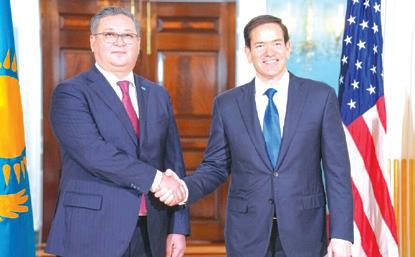
On Thursday, President Donald Trump announced that Kazakhstan would join the Abraham Accords, becoming the first country to do so in the president’s second term.
Kazakhstan, a Central Asian former Soviet state with a predominantly Muslim population, already has diplomatic relations with Israel, unlike the other Arab and Muslim-majority countries that joined the accords during Trump’s first term. Still, the Trump administration has praised the mostly symbolic move, noting that it would encourage other countries to join.
“This is a major step forward in building bridges across the world. Today, more nations are lining up to embrace peace and prosperity through my Abraham Accords,” the president said following a phone call with Israeli Prime Minister Benjamin Netanyahu and Kazakhstan President Kassym-Jomart Tokayev.
Trump met with Tokayev and four other Kazakhstani leaders at the White House on Thursday evening.
“We will soon announce a signing ceremony to make it official, and there are many more countries trying to join this club of STRENGTH,” he added. “So much more to come in uniting countries for stability and growth — real progress, real results. BLESSED ARE THE PEACEMAKERS!”
The government of Kazakhstan later said that the country’s accession to the
Abraham Accords was “a natural and logical continuation of Kazakhstan’s foreign policy course — grounded in dialogue, mutual respect, and regional stability.”
When asked by reporters about the deal’s significance, Vice President JD Vance replied, “What the president has done is signal that the momentum of the Abraham Accords is alive and well in the second administration. It’s not just going to be Kazakhstan but also a number of other countries that join in the months to come.”
Secretary of State Marco Rubio added that the Abraham Accords isn’t only about normalizing ties between Israel and Muslim countries.
“You’re now creating a partnership that brings special and unique economic development on all sorts of issues… The strength of it is to have majority Muslim countries and the Jewish state able to partner on things to show the world that it is possible,” Rubio said.
The Trump administration hopes to bring other Arab and Muslims countries, including Saudi Arabia and Syria, into the Abraham Accords. When asked whether he would speak with Syrian President Ahmed al-Sharaa about the Abraham Accords, Trump simply stated that he believed Sharaa is doing a “very good job” in a “tough neighborhood.”
Reuters reported in August that the Trump administration hoped to bring Azerbaijan, another country that already has ties with Israel, into the agreement, as well.
During Trump’s first administration, the United Arab Emirates, Bahrain, Morocco, and Sudan joined the Abraham Accords, normalizing relations with the Jewish state. No nations joined the accords during former President Joe Biden’s administration.

After over 11 years in Gaza, the body of Lt. Hadar Goldin — whom Hamas murdered and kidnapped during the 2014 Gaza War — has been returned to Israel. On Saturday, the Hamas terror group

32 confirmed that it had Goldin’s body in a tunnel in Rafah. A day later, the Red Cross handed the fallen soldier’s remains to the Israel Defense Forces. The body was then brought to the Abu Kabir institute in Tel Aviv and identified.
According to a senior Turkish official, Turkey was heavily involved in recovering Goldin’s body.
“We are pleased to confirm that Turkey has successfully facilitated the return of Hadar Goldin’s remains to Israel after 11 years. This achievement is the outcome of intensive efforts and reflects Hamas’s clear commitment to the ceasefire,” the official told Channel 12 news, adding that Turkey is also trying to help 100 to 200 trapped Hamas terrorists escape tunnels in parts of southern Gaza that are now under IDF control.
Goldin was murdered and abducted on August 1, 2014, right as the 2014 Gaza War’s 72-hour humanitarian ceasefire began. He and two other soldiers from the Givati Brigade’s reconnaissance unit were killed after being ambushed by terrorists in Rafah.
Goldin’s family, who have been waiting over 11 years for his return, remembered their beloved son and brother and expressed their gratitude to the army.
“How do I feel? I don’t know yet,” his
sister Ayelet wrote on social media. “But I do know that what strengthens me is that we remained true to our truth — to our Israeli values. My Hadar — you are my inspiration. And you live in my heart always, and I love you very much. And finally, you’ve come home.”
Goldin’s parents, Leah and Simcha, thanked the IDF for recovering their son’s remains. Simcha credited his son’s return to “the IDF, and no one else,” implying that Prime Minister Benjamin Netanyahu wasn’t responsible for the recovery of Goldin’s body. For years, Goldin’s family has accused Netanyahu of failing to adequately pressure Hamas to release the fallen soldier’s remains.
“It took us 11 years to get him back, with the help of the IDF and the security services,” Goldin’s mother said.
“We went around the world to do the impossible, to demonstrate that we have shared values, no matter the religion or race, that all have the responsibility to bring home a soldier’s body from the battlefield for proper burial,” says Leah Goldin. “These are the values we fought for. We went through so many disappointments.
“October 7 was a call and an alarm clock for everyone in Israel,” she said. “So look at us, and come have a coffee with

us, and we’ll explain to you that we must fight for our kids because without our kids, we have no continuity.”
Goldin’s father said that his son would be a symbol of idealism and moral conviction. “We brought back the symbol, and now we have to protect it and fight for it.”
Following the return of Goldin’s body, Netanyahu delivered a video statement in which he said he “always had two pictures in [his] office: of Oron Shaul and Hadar Goldin, of blessed memory.” He added, while holding a picture of Goldin, that he had “vowed that we would bring them home” and “never gave up on that for a moment.”
“We took many actions, but naturally, once we entered Gaza, we were able to do much more,” he said. “And with G-d’s help, thanks to the heroism of IDF soldiers and the decisions we made, they came home. Today, Hadar Goldin is coming home.”
President Isaac Herzog praised Herzog as a “hero of Israel,” and noted his family’s “tireless and persistent struggle.” Herzog added that he also had Goldin’s picture on his desk.
Now, the bodies of four hostages remain in Gaza: Meny Godard, Master Sgt. Ran Gvili, Dror Or, and Sudthisak Rinthalak, a Thai national. The Prime Minister’s Office pledged to continue fighting for the remaining hostages’ release and said the Jewish state “shares in the deep sorrow of the Goldin family and of all the families of the fallen hostages.”
Goldin’s return “provides some measure of comfort to a family that has lived with agonizing uncertainty and doubt for over 11 years,” the Hostages and Missing Families Forum said, adding, “We will not rest until the last hostage is brought home.”
Goldin was 23 years old when he was killed. He is survived by his parents, Leah and Simcha, his older siblings Ayelet and Chemi, and his twin brother Tzur, with whom he was very close. Shortly before his tragic death, Goldin and his fiancée, Edna Sarussi, got engaged and had started planning their wedding.
On Sunday, Defense Minister Israel Katz ratified Itai Ofir’s appointment as military advocate general. On November 24, Ofir will replace Maj. Gen. Yifat Tomer-Yerushalmi, who stepped down and confessed to initiating the leaking of a video that allegedly shows IDF soldiers mistreating a Palestinian prisoner.
Katz’s office announced Ofir’s promotion on Monday. Ofir, an attorney who previously worked in Israel and the United States, was the Defense Ministry legal adviser from 2017 to 2024. Before becoming legal chief, he will be promoted from captain to major general. When he was in the army, he was a Givati Brigade combat officer, and in the reserves, he fought in the Negev Brigade. Five-rank promotions of this sort are rare, though others have occasionally seen similar promotions.
According to reports, Prime Minister Benjamin Netanyahu, whose son Yair opposed the appointee’s candidacy, was unhappy and surprised by Katz’s decision to confirm Ofir.

An investigation by Attorney General Gali Baharav-Miara found no evidence of wrongdoing on Tomer-Yerushalmi’s part. Around a week ago, after Tomer-Yerushalmi confessed, Justice Minister Yariv Levin appointed Asher Kula, the state ombudsman for judges, to investigate, noting that Baharav-Miara is no longer unbiased. Kula has requested investigation materials from the police, but Israel Police chief Danny Levy has refused to cooperate until the High Court selects the case’s investigator on Tuesday morning. Coalition lawmakers have criticized Levy for his refusal.
On Friday, after Tomer-Yerushalmi posted bail, she was released to house arrest. However, she was promptly taken to Ichilov Hospital in Tel Aviv on Sunday morning after she apparently attempted suicide by digesting a large number of sleeping pills at home.
Authorities have indicted five soldiers who allegedly took part in the mistreatment shown in the videos on charges of causing severe injury and aggravated assault. Officials have condemned the video as a “blood libel.”
On October 13, the last living hostages finally made it back to Israeli soil. But of the 28 deceased hostages whose bodies were still held by Hamas when the Gaza ceasefire took effect, four families still wait for closure as their loved ones’ bodies remain in the Gaza Strip, leaving

them unable to bury their fathers, sons and siblings.
The families of these final four remain in limbo, as Hamas claims it is currently unable to reach some and does not know where others are. Israeli officials have said they do not believe all the terror group’s claims on the matter.

Meny Godard, 73, was murdered in Kibbutz Be’eri by Palestinian Islamic Jihad terrorists alongside his wife, Ayelet, on October 7, 2023. His body was then taken into Gaza.
A joint funeral was held for the couple a few weeks later, but only Ayelet was buried.
Godard was described as a man who loved sports, the ocean and people. He was also a dedicated member of the kibbutz, holding a variety of positions within it.
Master Sgt. Ran Gvili, 24, was killed
battling Hamas terrorists in Kibbutz Alumim on October 7. His body was taken into Gaza.
Gvili had been at the hospital that morning awaiting surgery but decided to go help when he heard of the Hamas onslaught on southern communities.
In January 2024, the family was notified that he had been killed in the attack.
Dror Or, 48, was murdered by Hamas terrorists and abducted from his home in Kibbutz Be’eri on October 7. His wife, Yonat, was also murdered, and his kids, Noam and Alma, were abducted alive and released a month later as part of a hostage deal.
Dror was believed to be alive until his family was notified the following May that he had been murdered on October 7.
Sudthisak Rinthalak, 43, was murdered by Hamas terrorists in Kibbutz Be’eri on October 7. His body was then taken into Gaza.
Rinthalak was an agricultural worker from Thailand who sent money home to help his struggling family. On the morning of the attack, he was working on the kibbutz when he was murdered.
His family was notified in May 2024 that he had been murdered.
Rinthalak’s father said he is the “missing pillar of the family.”


This week, lawmakers voted in favor of the first reading of a bill to impose the death penalty on terrorists who have killed Israelis.
The bill was sponsored by Otzma Yehudit MK Limor Son Har-Melech. The vote was 39-16 in favor of the bill.
Two other death penalty bills, sponsored by Likud MK Nissim Vaturi and Yisrael Beytenu MK Oded Forer, also passed their first readings 36-15 and 3714.
Son Har-Melech’s bill states that Israeli courts must impose the death penalty on those who have committed a nationalistically motivated murder of a citizen of Israel, while allowing judges serving on military courts in the West Bank to sentence offenders to death with a simple majority, rather than unanimous decision. The bill would also remove the possibility of regional military commanders commuting such sentences.
The bill states that it applies to those who kill Israelis due to “racism” and “with the aim of harming the State of Israel and the revival of the Jewish people in its land,” leading to criticism that it would apply only to Arabs who kill Jews.
Although the death penalty formally exists in Israeli law, it has only ever been used once: in 1962, in the case of Nazi officer Adolf Eichmann, one of the architects of the Holocaust.
The death penalty is technically allowed in cases of high treason, as well as in certain circumstances under martial law that applies within the IDF and in the West Bank, but currently requires a unanimous decision from a panel of three judges and has never been implemented.
“Today, we took a historic step towards true justice and strengthening deterrence against terrorism. The death penalty law for terrorists, which passed its first reading, is a moral and national expression of a people that refuses to accept a reality in which murderers of Jews live in prison and expect deals,” said Son Har-Melech.
The bill will now be referred to com-
mittee to be prepared for the final two readings it needs to pass to become law. Except for Avigdor Liberman’s Yisrael Beytenu party, which voted in favor, the votes were largely boycotted by the opposition, with all of Blue and White and all but one of Opposition Leader Yair Lapid’s Yesh Atid party’s MKs staying away. Lapid had said earlier on Monday that he would not cooperate with Otzma Yehudit’s “political stunts.”
United Torah Judaism’s Degel HaTorah faction had earlier pledged to oppose the bill while all but two of the coalition Shas party’s lawmakers missed the latenight vote. Degel HaTorah spiritual leader Harav Dov Landau warned that the bill “could lead to bloodshed.”
Son Har-Melech told lawmakers on Monday evening that standing with her “are thousands of murder victims, but they cannot stand on their feet to point an accusing finger at the loathsome murderers and to cry out against the Palestinian terrorists — I accuse them.”
She said she came to speak on behalf of “all the victims of Palestinian terror,” describing how she was moved to follow her current path following the murder of her husband in a terror attack in 2003.
The terrorist who led the cell that murdered Son Har-Melech’s husband Shalom went on to take part in other attacks, including October 7 — although two others implicated in the attack were released as part of the latest ceasefire deal, she said, asking how many people would have been saved had they been executed.
“When the message is unequivocal, without loopholes and without equivocation, the death penalty for terrorists law changes perception. It changes the paradigm. No more prisons. No more deals. No more suspended sentences. But a death sentence. Because it’s very simple: when a terrorist dies, he does not return to the circle of terror and will not be released alive,” she maintained.
“No more mercy, no more hesitation. We choose life, and whoever chooses death will bear the consequences of his actions.”
James D. Watson, famous for co-discovering the twisted-ladder structure of DNA in 1953, died this week at the age of 97.

Watson made that famous discovery was he was just 24 years old. He shared a 1962 Nobel Prize with Francis Crick and Maurice Wilkins for discovering that deoxyribonucleic acid, or DNA, is a double helix, consisting of two strands that coil around each other to create what resembles a long, gently twisting ladder. What they discovered was a breakthrough in science. It instantly suggested how hereditary information is stored and how cells duplicate their DNA when they divide. The duplication begins with the two strands of DNA pulling apart like a zipper. They had used Tinker Toy-like models to work out the molecule’s structure.
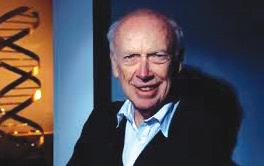
“Francis Crick and I made the discovery of the century, that was pretty clear,” Watson once said. He later wrote, “There was no way we could have foreseen the explosive impact of the double helix on science and society.”
Prior to the discovery, Watson’s son, Rufus, had been hospitalized with a possible diagnosis of schizophrenia, and Watson figured that knowing the complete makeup of DNA would be crucial for understanding that disease, hopefully to help his son.
Watson never felt the need to say things that were politically correct.
“A goodly number of scientists are not only narrow-minded and dull, but also just stupid,” he wrote in “The Double Helix,” his bestselling 1968 book about the DNA discovery.
For success in science, he wrote: “You have to avoid dumb people. ... Never do anything that bores you. ... If you can’t stand to be with your real peers (including scientific competitors) get out of science.
... To make a huge success, a scientist has to be prepared to get into deep trouble.”
He also was quoted in 2007 as saying that he was “inherently gloomy about the prospect of Africa” because “all our social policies are based on the fact that their intelligence is the same as ours — where all the testing says not really.” He said that while he hopes everyone is equal, “people who have to deal with Black employees find this is not true.”
He was forced to apologize after that comment and was suspended from his

job as chancellor of the prestigious Cold Spring Harbor Laboratory in New York. He retired a week later. He had served in various leadership jobs there for nearly 40 years.
In a television documentary that aired in early 2019, Watson was asked if his views had changed. “No, not at all,” he said.
Watson was born in Chicago in 1928 into “a family that believed in books, birds and the Democratic Party,” as he put it. He entered the University of Chicago on a scholarship at 15, graduated at 19 and earned his doctorate in zoology at Indiana University three years later.
He got interested in genetics at age 17 when he read a book that said genes were the essence of life.
“I thought, ‘Well, if the gene is the essence of life, I want to know more about it,’” he later recalled. “And that was fateful because, otherwise, I would have spent my life studying birds and no one would have heard of me.”

On Monday, President Trump met with Syrian President Ahmed al-Sharaa at the White House. It was the first such meeting with a Syrian president.
The closed-door talks were unusually muted, without much fanfare. Sharaa, a former al Qaeda commander, arrived in Washington just days after the U.S. said he was no longer a “Specially Designated Global Terrorist.”
Speaking after the meeting, Trump vowed to do everything he can to make Syria successful.
Sharaa aimed to push for full removal of U.S. sanctions. After the meeting, the U.S. Treasury Department announced a 180-day extension of its suspension of enforcement of the so-called Caesar sanctions, but only the U.S. Congress can lift them entirely.
Syria also announced it recently signed a political cooperation declaration with the International Coalition to Defeat ISIS. There are no military components to the agreement. ISIS is an offshoot of al Qaeda and has carried out terror at-
tacks around the world. At the height of its power in 2014-2017, the Islamic State controlled a large area of Syria and Iraq, imposing hardline Islamist rule over millions of people and killing or torturing its opponents. Syria is the 90th member of the International Coalition to Defeat ISIS group.
Just hours before the talks, word emerged of two separate Islamic State plots to assassinate Sharaa that had been foiled over the last few months, according to a senior Syrian security official and a senior Middle Eastern official.
Sharaa’s visit capped a whirlwind year for the rebel-turned-ruler who toppled longtime autocratic leader Bashar al-Assad and has travelled the world trying to depict himself as a moderate leader battling corruption.
Trump seemed to give a nod to Sharaa’s years leading an Islamist rebel group that was formerly Al-Qaeda’s affiliate in Syria. “We’ve all had rough pasts, but he has had a rough past. And I think, frankly, if he didn’t have a rough past, he wouldn’t have a chance,” the U.S. president said.
He added that the U.S. is working with Israel on Syria relations. “We’re working also with Israel on, you know, getting along with Syria, getting along with everybody,” he said.
Trump added, “We’ll do everything we can to make Syria successful because that’s part of the Middle East. We have peace now in the Middle East... Syria is a very big, a very big part of the Middle East, very important part here. If you look back at Syria for years, they had the doctors, the lawyers, they had so many of the great intellects.”
The U.S. president also said he has confidence that Sharaa will be able to “do the job.”

Former House Speaker Nancy Pelosi, the 85-year-old long-time House representative and Democratic Party leader, announced her retirement from Congress in a video posted on Thursday.
“I will not be seeking reelection to Congress,” Pelosi, who has served in the House


since 1987, said in the video. “With a grateful heart, I look forward to my final year of service as your proud representative.”
“As we go forward, my message to the city I love is this: San Francisco, know your power,” she added. “We have made history. We have made progress. We have always led the way. And now we must continue to do so by remaining full participants in our democracy and fighting for the American ideals we hold dear.”
In her video, which is almost six min-
utes long, she praised San Francisco, quoted from a Catholic saint, and touted her Roman Catholic faith.
Pelosi became the first and only female House speaker in 2007. She served as speaker until 2011 and then again from 2019 to 2023. During her tenure, she spearheaded major Democratic legislation and held great power over her party.
Former presidents Joe Biden and Barack Obama praised Pelosi, following her retirement announcement.
served the American people and worked to make our country better.”
Hillary Clinton, the former secretary of state, first lady, and presidential candidate, also praised Pelosi.
“There will be so many things to say about the legendary Nancy Pelosi’s transformational tenure in Congress—but for now, let’s start with ‘Thank you, Madam Speaker,’” Clinton said.
Meanwhile, President Donald Trump, at a White House event on Thursday, called Pelosi “an evil woman” and said he’s “glad she’s retiring.”

To ensure air safety during the government shutdown, Transportation Secretary Sean Duffy announced an up to 10% traffic reduction at 40 major airports, forcing flight cancellations.
As per an emergency order implemented Friday by the Federal Aviation Administration and Transportation Department, air traffic was supposed to be reduced 4% on Friday, 6% on Tuesday, 8% by November 13, and 10% by November 14.
Additionally, the order restricts commercial space launches to nonpeak hours and limits parachute operations. Though Duffy has said the United States’s air-travel system is safe, flight reductions were necessary, as the shutdown — the longest in U.S. history — took a toll on airport workers, who weren’t getting paid and were overstaffed.
The FAA’s order applies to 40 major airports, including ones in Atlanta, New York, and Chicago.
“When I was President, we worked together to grow our economy, create millions of jobs, and make historic investments in our nation’s future,” Biden stated. “She has devoted much of her life to this country, and America will always be grateful.”
“No one was more skilled at bringing people together and getting legislation passed – and I will always be grateful for her support of the Affordable Care Act,” Obama said, adding that Pelosi “has
According to an internal memo by Southwest Airlines, “a 4% reduction in key markets represents approximately 100 flights, a level we routinely manage during standard weather or irregular operational events.”
These cancellations are in line with what airports expect during a winter storm.
By Thursday night, over 520 flights for Friday were canceled by airlines, according to aviation-analytics company Cirium. Around 170 flights, including from regional

carriers SkyWest, Republic, and Endeavor Air, were canceled by Delta, a company spokesperson confirmed. On Sunday, over 10,000 flights were delayed or canceled due to the shutdown and bad weather.
On Sunday, the shutdown’s 40th day, the Senate voted to end the shutdown. The bill, which now awaits a House vote, was passed Monday night by the Senate after a group of Democrats sided with Republicans.

The fate of U.S. soybean farmers hangs in the balance, following fallout from the United States’s trade wars with China. A week ago, President Donald Trump and his Chinese counterpart Xi
Jinping moved to relax trade tensions following their meeting in South Korea.
After the meeting, Trump said the U.S. would lower tariffs on Chinese goods if China imposes restrictions on exports of ingredients used to make fentanyl.
Treasury Secretary Scott Bessent also announced that China vowed to purchase 12 million metric tons worth of American soybeans this harvest season and another 25 million metric tons a year during the next three years. Bessent added that our “great soybean farmers … should prosper in the years to come.”
But that agreement was recently put into question after China purchased billions of dollars’ worth of soybeans from Argentina. The purchase, which outraged U.S. soybean farmers, came shortly after the Trump administration said it would give Argentina a $20 billion loan to support its economy.
The U.S.-China deal’s exact details are unclear, though it seems that China agreed to purchase fewer U.S. soybeans than it has in years past.
In 1982, the U.S. Soybean Export Council established an office in Beijing. In the 1990s, soybean consumption exploded in China, as middle class locals developed a liking for pork and poultry, which are raised on soybeans. The U.S.’s
soybean industry has long relied on Chinese imports. However, U.S. soybean exports took a hit during Trump’s first administration, when tariffs against China escalated into a trade war and prompted the Asian country to reduce its reliance on U.S. goods.
Another country involved in the U.S.’s soybean struggle is Brazil, which passed the United States more than a decade ago as the top soybean exporter in the world. Over the past 15 years, the percentage of Chinese soy imports that come from Brazil has doubled to 70%.

On Monday, the 41st day of the government shutdown, the Senate finally voted to fund the government. The bill was then sent to the House, which was scheduled to
vote on the funding package on Wednesday, putting the government on track to reopen this week.
For over a month, Democratic lawmakers refused to vote to reopen the government until the Republicans agreed to renew Obamacare subsidies, which are supposed to expire by the end of the year. The Democrats, however, failed to achieve that objective, as eight Senate Democrats conceded and sided with Republicans to end the shutdown. As a compromise, Republican Senate Majority Leader John Thune has promised that Congress would vote on the subsidies issue by the second week of December.
“We have senators, both Democrat and Republican, who are eager to get to work to address that crisis in a bipartisan way,” Thune said. “These senators are not interested in political games; they’re interested in finding real ways to address healthcare costs for American families. We also have a president who is willing to sit down and get to work on this issue.” Democrats did achieve one of their objectives: the bill reverses the Trump administration’s firing of furloughed federal workers and grants them back pay and future shutdown protections. The package would fund the government until January 30.


Among those who broke with the Democratic Party to vote for the deal were Senate Minority Leader Chuck Schumer, Sen. Jeanne Shaheen, D-N.H., and Sen. Tim Kaine, D-Va.
“This was the only deal on the table,” Shaheen explained. “It was our best chance to reopen the government and immediately begin negotiations to extend the [Obamacare] tax credits that tens of millions of Americans rely on to keep costs down.”
“If you wait another week, they’re going to get hurt more, another month or even more,” Kaine said. “So what got me over the line was the pledge that they were able to give the federal employees.”
Speaker Mike Johnson said the House would hopefully vote on the bill on Wednesday.
Congress’ 40-day stalemate ended after the shutdown caused major air traffic delays and cancellations.
President Donald Trump issued pardons for over 70 people who were involved in efforts to challenge the 2020
election. Most notably, Trump pardoned Rudy Giuliani, the former New York City mayor who served as the president’s personal lawyer.
The pardons were announced Sunday night by Ed Martin, the U.S. government’s pardon attorney.
“This proclamation ends a grave national injustice perpetrated upon the American people following the 2020 Presidential Election and continues the process of national reconciliation,” said Martin.

Among those pardoned were Mark Meadows, Sidney Powell, Kenneth Chesebro, Jeffrey Clark, John Eastman, Jenna Ellis, and Boris Epshteyn. The proclamation, which was signed November 7, specifies that the pardon “does not apply to the President of the United States, Donald J. Trump.” Trump’s federal indictment was dropped by special counsel Jack Smith after the president was elected to a second term.
The pardons were mostly symbolic, as they only apply federally and federal courts have never charged those who were pardoned.
Multiple state attorney generals and officials noted that the pardons do not apply to state charges. In Georgia, Arizona, Michigan, Wisconsin, and Nevada, prosecutors have been going after many of the people who Trump just pardoned.
“These great Americans were persecuted … by the Biden Administration for challenging an election, which is the cornerstone of democracy,” Karoline Leavitt, the White House press secretary, stated. “Getting prosecuted for challenging results is something that happens in communist Venezuela, not the United States of America, and President Trump is putting an end to the Biden Regime’s communist tactics once and for all.”
At least 27 campers and counselors at Camp Mystic in Texas died on July 4 when flash floods swept through the camp. Now, the families of those who lost their lives in the raging waters this sum-
mer are suing the camp and its owners and operators, accusing them of negligence and reckless disregard.
The camp was based along the Guadalupe River in the Hill Country of Central Texas.
As the floodwaters rose, the suit alleges, camp leaders instructed groundskeepers to spend more than an hour relocating camp equipment instead of people from the site.

“These young girls died because a for-profit camp put profit over safety,” the suit said, naming the camp and members of the Eastland family, the site’s longstanding owners, among the defendants.
The 32-page suit, filed in state court in Austin, accuses Camp Mystic of placing campers in cabins located in flood-prone areas and failing to develop necessary evacuation plans.
“The Camp chose to take no steps to protect its campers and counselors while



44 it knew a storm and ‘life threatening flash flooding’ were approaching,” it said. “Finally, when it was too late, the Camp made a hopeless ‘rescue’ effort from its self-created disaster in which 25 campers, two counselors and the Camp director died.”
Camp Mystic, in response, issued a one-sentence statement: “We continue to pray for the grieving families and ask for G-d’s healing and comfort.”
Jeff Ray, the camp’s legal counsel, said the defendants “disagree with several accusations and misinformation” in the suit “regarding the actions of Camp Mystic and Dick Eastland, who lost his life as well.”
“We empathize with the families of the campers and counselors and all families in the Hill Country who lost loved ones in the horrific and unprecedented flood of July 4,” Ray said. “We intend to demonstrate and prove that this sudden surge of floodwaters far exceeded any previous flood in the area by several magnitudes, that it was unexpected and that no adequate warning systems existed in the area.”
The lawsuit also charges the camp’s owners with deepening the families’ pain with their actions since the tragedy, including their recent declaration of plans to reopen for business even as one victim of the disaster remains missing.
“The Camp has caused further trauma to these distraught families,” it said. “And through it all, the Camp refuses to accept any responsibility for its actions and failures to act, defiantly blaming this tragedy on ‘an act of G-d’ that no responsible steps could have avoided.”
The plaintiffs are asking for damages of at least $1 million.
The July 4 flooding killed at least 135 people, 116 of them in Kerr County, after heavy rainfall caused the Guadalupe to overflow its banks. The river rose more than 20 feet in just a few hours as it headed downstream in a deadly torrent through Kerr County.
en seeking to recover from alcohol abuse. She said that the woman who stole the van was from the home.
Police tracked the vehicle down and then tried to stop the speeding car, which drove away at speeds up to 90 miles an hour. Police from different municipalities chased the car for more than 150 miles across four counties.

Video of the pursuit broadcast by local TV stations showed the minivan swerving around other vehicles and dodging spike strips thrown in its path.
The driver managed to drive across the border into Mexico, and police did not pursue the car further.
Walters called the events “super unfortunate” but said she was relieved that the driver was “safe and nobody got hurt.”
“The van is insured, and hopefully we’ll be able to get it back to the United States,” she added.
This minivan has special powers.

The Australian man has the world’s longest name. He had his name legally changed in March 1990 to include 2,251 middle names, with 2,253 unique words.
This week, he read out his whole name, which took more than an hour to get through.
guish Anleifr – and those aren’t even all of the names beginning with “A.”
“I was always fascinated by the quirky unusual records that some people went for, and I really wanted to be part of that scene,” he told Guinness World Records. “I read the Guinness World Records book from cover to cover to see if there was a record I could beat, and the only one I had a chance at beating was adding more names than the current holder.”
Watkins said the process involved a lot of paperwork and several trips to court. His successful name change was followed by the passing of new laws that prevented others from trying to take his record.
“My favorite name is AZ2000, meaning I have names from A-Z and I have 2000 names,” he said.
What’s the name of the game?

We know that wine should be aged –the longer it’s sitting in those barrels, the better the wine may be.
Now, a grapevine found in the mountains of Tibet has been certified by Guinness World Records as the oldest wild living vine in the world. The vintage? It has been proven to be 416 years old.
The vine, located in Zuoba Village, Zogang County, was first discovered during a survey of ancient and notable trees in Changdu city and was later analyzed by scientists from the Wood Science Research Laboratory at Southwest Forestry University in China.
The researchers used ring analysis and physical measurements to determine the vine’s age. Hey, grape minds think alike!
piece of history with it, too?
Watchmaker Co&MacArthur is commemorating the D-Day landings on the beaches of Normanday with a series of watches made from U.S. soldiers’ helmets and haversacks along with sand from the beaches themselves.
“People are not buying this watch because it tells the time,” explained company’s CEO Sébastien Colen. “It’s because it is bringing them back somewhere in the past.”
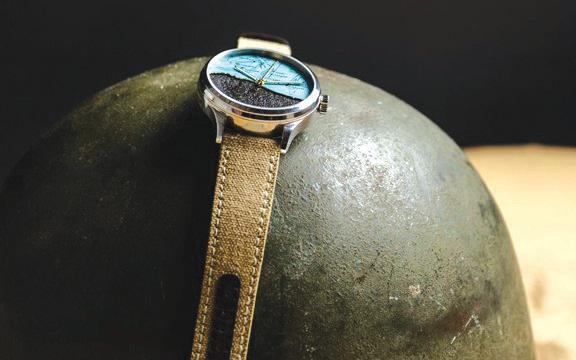
Colen had spent three years developing a prototype for his Normandie 1944, a luxury watch featuring metal from an M-1, the standard-issue helmet used by the U.S. Army during World War II. Sourced from a military memorabilia trader in Dallas, Texas, the helmet was flattened in a press, rather than with a hammer, to preserve its original markings and imperfections. The resulting metal sheet was then cut into circles that can be incorporated into dials and inserted in the watches’ 43-millimeter cases at the brand’s studio in Liège, Belgium. One helmet has enough metal to produce around 20 watches.
For now, the pieces are made to order and cost either $1,749 for the “Legacy” edition (only a symbolic 1,944 watches will be made) or the $699 standard version.
The design also features a small capsule of Normandy sand and a strap made from an M-1928 haversack, the backpacks widely used by the U.S. Army during World War II. The dial displays a historical map of Omaha Beach, a codename given to one of the five landing areas — alongside Utah, Gold, Juno and Sword Beaches — used by Allied troops on D-Day.
A woman in a stolen minivan led police on a chase for hours across Southern California before escaping across the border to Mexico.
The perpetrator had stolen the 2004 Toyota Sienna minivan from Nicolle Walters. Walters runs a home for wom-
Watkins said it took the officiant at his wedding about 20 minutes to read his full name, but he recently attempted the feat himself for a Guinness World Records video and it took more than an hour.
What to know what his name is? It’s going to take a while.
His name begins Laurence Alon Aloys
Aloysius Alphege Alun Alured Alwyn
Alysander Ambie Ambrose Ambrosius
Amias Amiot Amyas Anders Andre An-
drea Andreas Andrew Andy Aneirin An-
The vine, located at an altitude of nearly 7,900 feet, measures about 26 feet tall and has a diameter of more than 2 feet.
What did the grape do when someone stepped on it? Nothing, it just let out a little “whine!”
A watch is generally used to tell time. But what if the timepiece could carry a
“Every time we do a project, we really question ourselves, ‘Is it is it respectful?’” Colen said, before referencing Winston Churchill’s quote that those who “fail to learn from history are doomed to repeat it.”
“This is exactly what is happening today,” he noted. “So, instead of having a helmet sitting in a warehouse, it’s on a watch, it’s providing emotion and it’s reminding us, every single day, of events of the past.”
It’s about time.



Mesivta Ateres Yaakov was honored to welcome back alumnus
Sam (Shmuie) Berger (Class of 2016), who now serves as a New York State Assemblyman representing District 27 and is the youngest member ever elected to the State Assembly.
Mr. Berger spoke to the 12th grade
about his inspiring journey, beginning as a student at MAY, continuing through 3½ years of learning in yeshiva in Eretz Yisroel, and later pursuing law school and passing the bar exam, ultimately leading to his election to public office. He shared the unique challenges and opportunities he faces as an Orthodox

Jew in government, emphasizing the tremendous chessed and kiddush Hashem he strives to accomplish through his role.
Mr. Berger explained that his motivation has always been a simple desire to do chessed, and public service became a meaningful avenue to fulfill that mission.
A lifelong resident of the district, Mr.
Berger is an attorney, community advocate, and devoted father of three, committed to making Queens a safer, more affordable place to raise a family, and serving as a balanced, principled voice in Albany.

Rav Pinchus Daniel Weinberger addressed the talmidim of Yeshiva Darchei Torah’s middle school about zerizus, the middah they are currently focused on. Rav Weinberger, an alumnus of Yeshiva Darchei Torah, is the Rosh Yeshiva of Nishmas HaTorah and the rav of Bais Tefillah, both located in Inwood. Also seen is Rav Yitzchok Gerstel, a rebbi in the middle school.
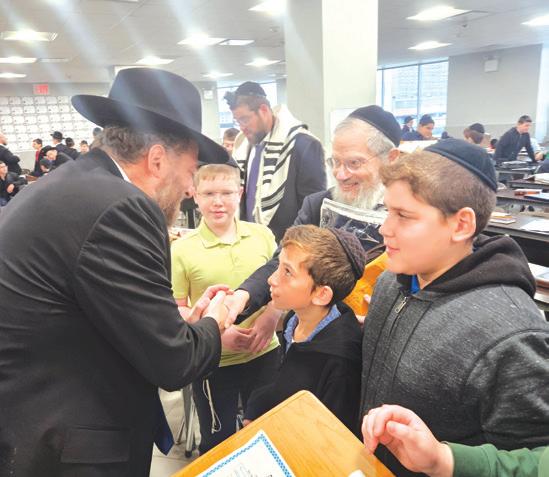
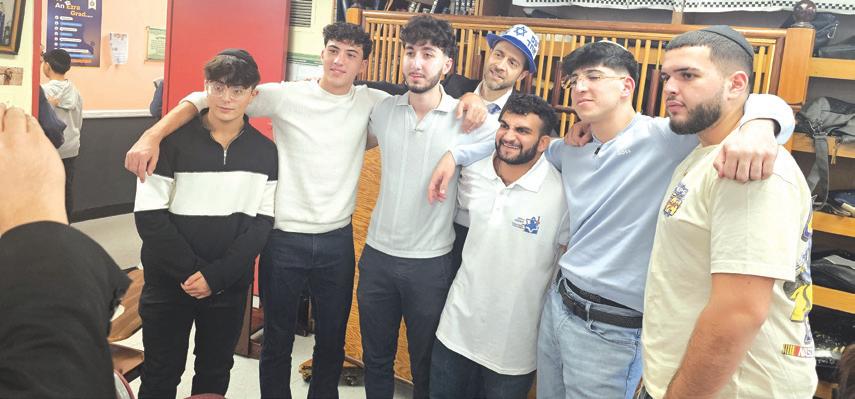
This week, Ezra Academy had the tremendous privilege of hosting representatives from El Ami, an organization dedicated to connecting Jewish communities with Israeli soldiers. Two wounded IDF veterans, Kayam Boccara and Matan Barr, visited our school and created a moment that will forever remain in the hearts of our students. Their arrival was met with warmth, pride, and deep respect.
As the soldiers entered the building, they were greeted by the Ezra girls, who stood together singing songs of unity and waving Israeli flags high with love and admiration. The atmosphere was powerful, filled with emotion and shared purpose. Kayam and Matan were then brought upstairs, where the Ezra boys were already gathered in a circle of dancing and celebration. Within seconds, the room erupted into spirited music, as the students lifted the soldiers on chairs and danced with them in joyous expression of gratitude and connection. It was a moment of pure Jewish pride, one that reflected the powerful bond Ezra Academy fosters with the State of Israel.
Following the celebration, the school
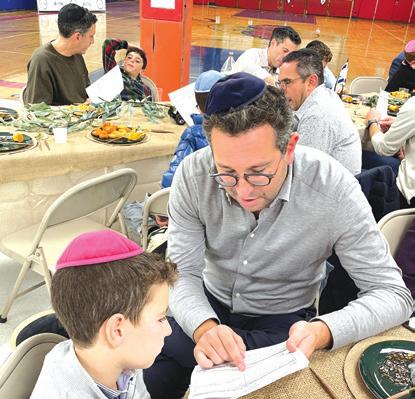
This past Motzei Shabbos, HAFTR’s 5th grade boys gathered for an inspiring and joy-filled Melava Malka that beautifully blended music, learning, and friendship. Led by Rabbi Klein, Mashgiach Ruchani, and Rabbi Weiss, their beloved rebbi, the evening began with a spirited Havdalah featuring special guest Benny Amar, whose soulful singing uplifted everyone’s hearts.
After enjoying delicious refreshments, the boys explored the halachot of Havdalah with a guest speaker and

tested their knowledge with a fun and engaging Kahoot review. They then crafted personalized dog tags engraved with meaningful messages.
The night concluded with a lively kumzitz and dance party, as voices joined together in song and celebration. It was a true HAFTR moment, where learning, ruach, and connection come together to create lifelong memories.
Thank you to everyone who made this special evening possible!
gathered for a 45-minute conversation with the soldiers. Kayam and Matan shared their firsthand experiences fighting in Gaza, speaking not only of the challenges and sacrifices, but of the values that carried them: selflessness, unity, courage, and commitment to something greater than oneself. The room was silent as students listened, captivated by the raw honesty and powerful message these heroes conveyed.
What made the moment even more meaningful was what happened after the program officially ended. Many students chose to give up their break to stay and continue speaking with Kayam and Matan, asking thoughtful and heartfelt questions. Their curiosity, compassion, and respect were evident.
Ezra Academy places profound importance on nurturing a deep love and appreciation for Israel, and this visit embodied that mission fully. The students didn’t just hear about sacrifice and duty—they felt it, witnessed it, and carried it with them. The day was more than an assembly; it was a lesson in identity, gratitude, and the strength of the Jewish people.
On Wednesday, November 5, the whole eighth grade at HANC began a project called Names Not Numbers®. In the program, students interview Holocaust survivors and edit the interviews which are then made into a documentary. The program began with powerful words from Rabbi Hecht, the Middle School principal, who spoke about the magnitude of a project like this. He explained that it is crucial for the students to participate and internalize the stories so that they can pass them on to future generations. Next, we heard from Mrs. Tova Rosenberg, the creator of Names, Not Numbers®. Mrs. Rosenberg gave an inspirational speech about how important this project is and how lucky we are to get the chance to participate in this program. After Mrs. Rosenberg, the students watched a 20-minute clip of an interview with Moshe Avital, a”h. The students sat spellbound watching his story. It is something which I am sure will stay in their memory for a very long time. Next, there was a presentation from Mrs. Shoshana Soroka, editor of The Jewish Home. Mrs. Soroka gave the class

tips on how to talk and interview Holocaust survivors. Mrs. Soroka did an amazing job of guiding the students. She was so engaging and listened intently as each student suggested certain types of questions. She went through the interview and explained how there would be questions about before the war, during the war, and after the war. Mrs. Soroka explained what types of questions would be best. She talked about what happens if the survivor cries or is silent for a bit.
The grade is looking forward to participating in this project.


The Reishis Chochma class at Siach Yitzchok acting out Avraham Avinu’s Hachnosas Orchim

The Technology Evening at BYAM last Wednesday night, Creating an Oasis, was nothing short of transformational and empowering. The incredible turnout of parents highlighted the strong partnership between school and home.
Rabbi Hoberman opened the evening by acknowledging the tremendous growth our community has experienced, along with the challenges that accompany the digital age. A powerful multimedia presentation followed, featuring firsthand accounts from parents about the impact of technology and the importance of protecting our daughters.
Mrs. Schneck, the keynote speaker, inspired the audience with the OASIS acronym—reminding us that our girls crave genuine connection and thrive in
environments that are safe, open, and supportive. She will be working with our Junior High girls biweekly, continuing these meaningful conversations and building practical tools for connection and empowerment.
Mrs. Rudomin shared how this initiative began, emphasizing our mission to educate, empower, and protect our girls by guiding them to make mindful, value-based choices. The evening concluded with Rabbi Churba, head of TAG, who provided practical tools for filtering and blocking devices effectively.
Parents, please encourage your daughter to fill out the form and join the BYAM Hub Club—together, we can continue building a strong, safe, and inspired future for our girls.




In a heartfelt Veterans Day observance, Yeshiva Ateres Eitz Chaim had the privilege of welcoming Rabbi/ Chaplain Levy Welton, a distinguished U.S. Air Force officer and ordained rabbi, as the special guest speaker. Captain Welton captivated the students with his uplifting message on emunah, bitachon, service, and the power of spiritual resilience.
Drawing from his remarkable experience as both a Torah scholar and military chaplain, Captain Welton spoke about the shared values that connect the life of a Ben Torah and that of a soldier – discipline, integrity, and devotion to a higher purpose. He emphasized that serving one’s country and serving Hashem both require courage, humility, and unwavering moral clarity.
The visit left a lasting impression on the talmidim, as they were inspired to
see how much Torah ideals can guide a person in the most challenging environments, from the Beis Medrash to the cockpit.
The Rosh HaYeshiva, Rabbi Gedaliah Oppen, expressed his admiration for Rabbi Welton’s example, saying, “Rabbi Welton showed our talmidim that a ben Torah can soar in any area when fueled with discipline, determination, and unwavering emunah.”
The visit concluded with a heartfelt expression of hakaras hatov and a tefillah by the Menahel, Rabbi Boruch Oppen, for the safety of America’s servicemen and for peace throughout the world. Rabbi Welton’s visit not only honored the spirit of Veterans Day but also strengthened the students’ appreciation of how Torah values can illuminate every path of life.


Shulamith School for Girls had an exciting event for their third graders. The grade spent a day in the ELECTRI-CITY as they opened their doors to the second graders to share their knowledge of simple circuits, magnetism and more. From making a lemon battery in Battery Tunnel to a hair-raising experience in Static Station, the girls were shining brighter as they left with a handmade glow stick from the Glow Garage. It was an enLIGHTening day for all.
“Shuk


ACHDUT, the DRS Chapter of the National Honor Society, is affiliated with the National Association of Secondary Schools. This year, DRS inducted over 30 students into the Achdut chapter of the National Honor Society. These students were selected for admission based on academic achievement and stellar character befitting this honor. The induction ceremony began with words of welcome from both Rabbi Yisroel Kaminetsky, Menahel of DRS, and Dr. Ethan Zadoff, principal of
Shuk to the Core returns to Long Island for two special days of connection, creativity and compassion at the Marion & Aaron Gural JCC’s Harrison-Kerr Family Campus, 140 Central Avenue, Lawrence, NY. The community is invited to attend on Saturday, November 15, from 8:00-11:00 pm, and Sunday, November 16, from 12:00-4:00 pm.
Organized in partnership with Areyvut, Mental Health First Aid Israel and Tal Tours, Shuk to the Core transforms the classic Israeli marketplace into a moving experience of unity and purpose. Dozens of Israeli artisans, many living in areas affected by conflict, will showcase handmade Judaica, jewelry, home décor, art, skincare and gifts. Every purchase directly supports small Israeli businesses and families rebuilding their lives amid trauma and economic uncertainty.
“These efforts aren’t about sales or logistics—they’re about people,” said Stuart Katz, of Mental Health First Aid Israel and Tal Tours. “Every artist who comes is a mother, a father, a neighbor from the North or South of Israel who has been living through trauma while trying to rebuild a life. When someone in America buys even a single piece, they’re not just taking home a product; they’re helping a
family breathe a little easier. This project is about restoring dignity, connection and hope. It’s a reminder that we’re one people and that caring doesn’t stop when the headlines fade.”
Daniel Rothner, Founder and Director of Areyvut, underscored the deeper meaning of the initiative: “Shuk to the Core is more than a marketplace—it’s a lifeline. Every event is a chance to stand with Israeli artisans, amplify their voices and help sustain their livelihoods during times of crisis. Each Shuk to the Core event is a celebration of resilience and unity. It’s where communities come together to proactively support Israeli vendors, share stories and create meaningful connections across borders.”
Voices from Israel: Artisans Share Their Stories
Shira Ha’Ivri, an artist and Judaica creator from Beit Aryeh, reflected on her experience: “I am thrilled to be participating in Shuk to the Core for the fifth time. This event has completely transformed my business. The immense exposure and the opportunity to meet thousands of people who support Israeli businesses is truly life-changing. In such a challenging time for us as Israelis, filled with economic uncertainty, war and immense
pressure, this support means everything. Feeling the unity within Am Yisrael is deeply inspiring! I am proud to be Israeli and I am proud to be Jewish, now more than ever. Am Yisrael Chai!”
Ilan Kaner, founder of Nisha Concept in Jerusalem, shared: “Being part of Shuk to the Core is something truly emotional. I’ve come all the way from Israel, bringing handmade inspirational art created with love by people on the autism spectrum, and suddenly I find myself surrounded by people who open their homes, their hearts, and their arms to welcome us. It’s not just an event—it’s a reminder that light, kindness, and human connection are stronger than anything.”
Tracey Lipman, another artisan participant, added: “Shuk to the Core is a lifeline for all our businesses which were struggling to survive. We are beyond grateful to the organizers and host communities. Your support has kept our businesses going and given us the opportunity to build meaningful, lasting relationships. Many customers have become friends. Thank you to everyone who has made these events the amazing experience they are.”
Sima Navon, founder of Navon Naturals in Efrat and mother of three elite
General Studies.
Pairs of inductees then delivered short vignettes to the parent audience about personal Jewish heroes that embodied the four pillars of the National Honor Society: character, leadership, scholarship, and service. An honorary award was presented to Mrs. Renee Sojcher, a long-time DRS science teacher, who was honored for her many years of hard work and dedication to her teaching and our students.
combat soldiers, expressed heartfelt gratitude: “Participating in Shuk to the Core has been among the highlights of my life during the past two war-torn years. We have all felt sadness, worry, and grief, but Shuk to the Core has reminded me of what’s important—community, caring, kindness, generosity, and love of our fellow Jew. All Jews are responsible for one another.”
Yossi Tavori, of Rachel’s Jewelry, echoed this sense of connection: “The Shuk to the Core fairs have given us the opportunity to meet supportive communities in the United States and helped us get through a difficult time for small businesses during the war. People open their homes and hearts to us with great generosity and kindness. It’s deeply moving and something I will never forget.”
Shuk to the Core – Israeli Artisans Marketplace: Saturday, November 15 (8:00-11:00 pm) and Sunday, November 16 (12:00-4:00 pm) The Marion & Aaron Gural JCC, Harrison-Kerr Family Campus, 140 Central Avenue, Lawrence, NY 11516
Admission: Open to the commUNITY For more information, visit https:// shuktothecore.com/.

It was another action-packed weekend in the JSL, brought to you by FM Home Loans. Every division delivered with tight games, clutch performances, and plenty of highlight moments that had fans on their feet. From shootout drama to overtime winners, Week 6 had it all!
Stand Out Care got the job done with a 7–4 win over Yeled LI Panthers, led by Gaby Mayer’s hat trick that set the tone early. Smash House defeated Marciano PD 6–3, behind a monster performance from Jack Schlessel, who tallied 4 goals and 2 assists in the win. Maidenbaum earned a 10–4 victory over Demo & Cleanouts, sparked by the dominant defensive play and leadership of Shalom Raful. SD Shades and Marciano battled to a 2–2 draw in a tightly contested matchup. Hillel Dorfman scored both goals for SD Shades, while Daniel Englander’s relentless energy set the tone for his squad.
K/P Soccer
Maidenbaum blanked SR Whee 3–0, thanks to two spectacular goals from Rafi Lewis, who made it look effortless. In the Game of the Week, 5 Towns Central and PIP Printing played to a 2–2 tie in a defensive showdown. Tzvi Goldblatt’s clutch second-half goal secured the draw in a game defined by grit and intensity.
Yaakov Rosenberg powered 5 Towns Central to a 6–4 win over SR Whee, scoring 4 goals and leading by example. Posh Home & Bath remained undefeated after a 10–7 win over Tikva Fire. Harry Wil-
heim netted a hat trick while Cheskel Rubin showcased incredible two-way play, scoring goals even while on defense.
Built By Nate edged J Works Construction 8–6, with Shua Steinman scoring the game-sealing goal late to clinch the win. Styles Design Interiors handled Growtha 10–5, fueled by the hustle and heart of Mordechai Rahmanan. Sushi Tokyo Ninjas got it done against NY Custom Closets, 7–3, behind a Dov Stein hat trick. Newman Dental earned an 8–4 win over Town Appliance, led by Yaakov Jeidel’s two-goal outing.
4th/5th
Styles Design Interiors came away with a 6–4 win over SD Shades, led by Yitzi Weiss, who scored 4 goals in a commanding performance. J Works Construction narrowly defeated Wieder Orthodontics 6–5, with Asher Newman recording a hat trick in the win. Eden Gardens edged Tal Academy 2–1, thanks to stellar goaltending from Yoni Singer, who was rock solid between the pipes. Smash House outlasted SR Whee 6–5 in overtime, with Dovid Bender scoring the golden goal to seal the win!
6-8 Grade Hockey
Emporio blanked Wieder Orthodontics 6–0, as Binyomin Tennenberg scored twice and added a highlight-reel assist to lead the way. Sperling Productions defeated Cachet in a shootout thriller, with Moshe Hildesheim netting the game-winner after multiple lead changes down the stretch. In a highly anticipated matchup, Town Appliance outlasted SD Shades 8–7 in a shootout. After a huge


comeback from SD Shades, goalie Tzvi Greenspan stood tall to secure the win for Town Appliance.
Growtha took down Seasons 8–2, with Ami Yarmish scoring 4 points and providing a spark on both ends of the floor. Marciano PD earned a 12–4 victory over Posh Home & Bath, fueled by Ari Gallis’s nonstop hustle and effort.
2nd Grade Basketball
Wieder Orthodontics squeaked past Rita’s 10–8, behind Avi Eisenreich’s steady play—2 points, 2 assists, and a key steal. Rip It took care of business, defeating Five Towns Landscaping 20–12, led by Eli Lopiansky, who drained a deep 30-foot shot that brought the crowd to its feet!
Tikva Fire stayed hot with a 14–4 victory over Central Pizza Co., thanks to Meir Feur’s 8-point performance. Seasons Express edged Elegant Lawns 10–9 in a thriller, hanging on despite Coby Adler’s standout effort for Elegant Lawns.
4th/5th Grade Basketball
Wieder Orthodontics defeated Addic-
Morah Elana Krasnow’s Pre-1A students at Yeshiva Darchei Torah voted on their favorite snack, veggie straws or corn pops, while learning about the elections
tive Ads 12–5, behind Menachem Lipschitz’s shutdown defense and leadership on the floor. Newman Dental eked out a 12–11 win over Rip It, led by Dovid Bauman’s game-high 8 points and clutch shooting down the stretch.
6th/7th Grade Basketball
Eden Gardens took down Tal Academy 21–14, with Aron Resnick showcasing elite fast-break ability. Elegant Lawns narrowly defeated Maidenbaum 23–21, powered by Max Edery’s game-high 15 points in an exciting finish.
Men’s Basketball Maidenbaum won a hard-fought battle against Smash House 65–60, with all five starters scoring in double figures for a true team effort. Hewlett Auto Body topped Kol Ve’or 55–44, behind Yoni Oratz’s 24-point performance. SR Whee secured a much-needed win over Advantage PT 69–54, led by Yisroel Wasser’s 22 points. Town Appliance remained the team to beat, outlasting Emporio in overtime, 76–72. Effie Freundlich was unstoppable, scoring 30 points to lead the way.


Rabbi Aaron Wahl’s fifth grade talmidim at Yeshiva Darchei Torah enacting the case of “Savei d’azli atigra – elderly people who
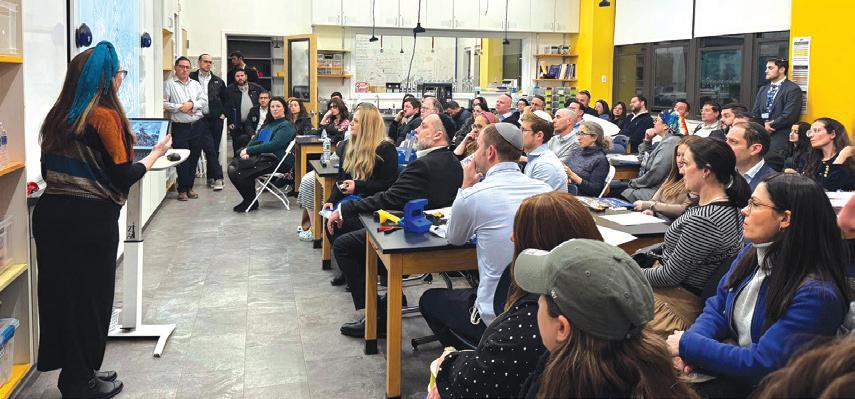
The excitement was palpable as families filled the beis medrash for MTA’s annual Open House, themed “Ahead of the Curve, Connected Across Community.” The evening began with inspiring remarks from Rabbi Daniel Konigsberg, principal, Rabbi Dr. Ari Berman, president of Yeshiva University, Rabbi Michael Taubes, Rosh Yeshiva, and Rabbi Shimon Schenker, menahel. Each shared the yeshiva’s vision of Torah excellence, academic growth, and personal development, reflecting MTA’s mission to provide education, uncompromised.
Rabbi Konigsberg captured the spirit of the evening, sharing, “From the moment families walked through our doors, the energy and enthusiasm were unmistakable. They experienced firsthand what makes MTA so special, a yeshiva centered on Torah, devoted to every talmid, uncompromising in its education, and uniting students from every community in a shared mission.”
After the opening presentations, guests joined four parallel sessions designed specifically for parents and prospective students. Parents heard from
faculty and administrators about MTA’s outstanding academic and Judaic programs. Students enjoyed interactive programming that captured the energy and camaraderie of MTA life. Highlights included a lively Family Feud-style game show, a Senior Panel offering an authentic look into student life, and an Alumni Panel that gave families a firsthand glimpse into the lasting impact of the MTA experience and what it truly means to be #Lion4Life.
The evening concluded with a circular fair-style Melave Malka, where families enjoyed delicious food while connecting with faculty, students, and administrators. Booths featured MTA’s wide range of extracurriculars, academic tracks, athletic opportunities, and student support services, offering families a taste of the warmth, spirit, and excellence that define the MTA community.
From start to finish, the Open House was more than just an introduction to a school. It was an experience that embodied the heart of MTA: Education, uncompromised.

In an ambitious move to shape the future of Jewish leadership, the Orthodox Union launched the OU Pipeline Initiative, a groundbreaking program that brings together Yachad, NCSY, JLIC, and Human Resources in a unified effort to nurture future leaders from within.
The initiative focuses on college-aged volunteers, strengthens leadership pipelines across the OU and broader Jewish community, and promotes cross-departmental collaboration with the goal of enhancing Jewish communal life by sharing best practices, engaging and retaining volunteers, cultivating leadership skills, and creating both immediate impact and long-term professional growth.
The OU Pipeline Initiative consists of three core components: the first is the Emerging Leaders Fellowship, a yearlong program bringing together 30 elite volunteers — 10 each from Yachad, NCSY, and JLIC —for mentorship, professional and leadership development, and a national leadership Shabbaton.
Ten young leaders from Cedarhurst, Woodmere, and New York City were among those selected to participate in the Emerging Leaders Fellowship.
“OU mentors have built organizations, navigated challenges, and shaped
Jewish life on the ground,” says OU Chief Human Resources Officer Josh Gottesman. “Fellows gain wisdom earned through years of service and leadership, learning not just the ‘how’ but also the ‘why’ behind decisions and leadership styles, rooting their professional journey in mission and responsibility to the Jewish community.”
The second element involves broader engagement of over 750 volunteers across the divisions through training, appreciation events, and growth opportunities; and the third facet is Career Forward, a fellowship helping JLIC-affiliated college students interested in Jewish communal careers to secure part-time internships.
“At the Orthodox Union, we see leadership development as both a responsibility and a privilege,” says OU Executive Vice President and Chief Operating Officer Rabbi Dr. Josh Joseph. “This initiative reflects the best of who we are — leaders across departments coming together to invest in our people and our shared mission. By building a strong leadership pipeline, we’re not only preparing individuals for future roles, we’re ensuring that collaboration, mentorship, and purpose continue to define our work and strengthen the Jewish community

NCSY advisors during a night of inspiration and skill-building
for generations to come.”
This latest program builds on previous OU investments in future Jewish leaders. In 2023, the OU launched its Executive Fellowship, a 10-month program introducing emerging leaders to all aspects of the Jewish nonprofit world and honing workplace skills needed for sustained communal impact. Conceived by Rabbi Dr. Joseph, the fellowship was inspired by a similar program at Yeshiva University.
The OU congratulates the following 30 elite volunteers who have been selected to participate in the Emerging Leaders Fellowship:
By Monet Binder, Esq.
AI can do amazing things. It can plan your meals, create a workout, or organize your week in minutes. For everyday tasks, it’s a great helper. But estate planning? That’s far more personal. It’s easy to think, “My situation is simple—I can do this myself.” Many people feel that way, especially if they don’t have much or think their family setup is straightforward. But estate planning isn’t just about documents—it’s about making sure the people and things you care about are looked after the way you want. And that’s something AI can’t truly understand. Before you trust a program with something this important, ask yourself these three questions.
1. What Matters Most?
When someone close to you passes,
it’s not their things you remember—it’s their kindness, laughter, and love. Now imagine your family dealing with confusion, costs, or conflict because your estate plan didn’t work as intended. That’s not what anyone wants. Estate planning is about easing the burden on those you love and giving them peace of mind when life gets hard.
2. What’s It Worth?
Once you know what matters, consider how much it’s worth to safeguard. Maybe it’s ensuring your children avoid court delays or that your assets go where you intend. Estate planning might seem simple, but it’s full of details and laws that change from place to place. AI can’t interpret your personal situation—it just fills in blanks. Are you comfortable taking that risk?
3. Is AI Really Cheaper or Easier? AI tools promise quick, low-cost
solutions. But if a mistake leads to family tension, extra taxes, additional expenses, or lost assets, any savings disappear fast—and the emotional toll can be even greater. A well-done estate plan isn’t about spending more—it’s about doing it right. It brings clarity, protection, and confidence when your family needs it most.
Estate planning is one of the kindest things you can do for your family. It’s not about wealth—it’s about care. AI can help with many things, but it doesn’t know your story, your relationships, or your heart. Taking time to plan with care ensures the people you love are supported—today and in the future. Consult a professional who has your best interests in mind, not someone who only focuses on after death documents. Estate Planning is also about
Yachad: Yaniv Dahan, Shaina Ermine, Neima Fine, Devorah Gottesman, Ezra Klausner, Arielle Mayer, Micah Pickett, Adira Schreiber, Noah Spear, and Yolie Starck
NCSY: Caleb Breda, Aaron Colomby, Rena Cooper, Jessica Ghitis, Bayla Keiffer, Gabriel Lallouz, Chana Levi, Uri Ostrin, Shmuely Pak, and Sarah Rabitz
JLIC: Binyamin Alter, Dani Bank, Andrew Berger, Maytal Chelst, Samantha Klein, Sophie Koffsky, Eyal Lubin, Zachary Magerman, Bailey Spitz, and Ephraim Weiss
what happens while you’re still living. Learn the best way to protect yourself and your family while you’re still living and after you’re gone, and keep everyone out of court and conflict.
Call today
718.514.7575 | 732.333.1854
Monet Binder, Esq., has a practice in Lakewood, Queens, and Brooklyn areas, dedicated to protecting families, their legacies and values. All halachic documents are approved by the Bais Havaad Halacha Center in Lakewood, under the direction of Rabbi Dovid Grossman and the guidance of Harav Shmuel Kaminetsky, shlita, as well as other leading halachic authorities.

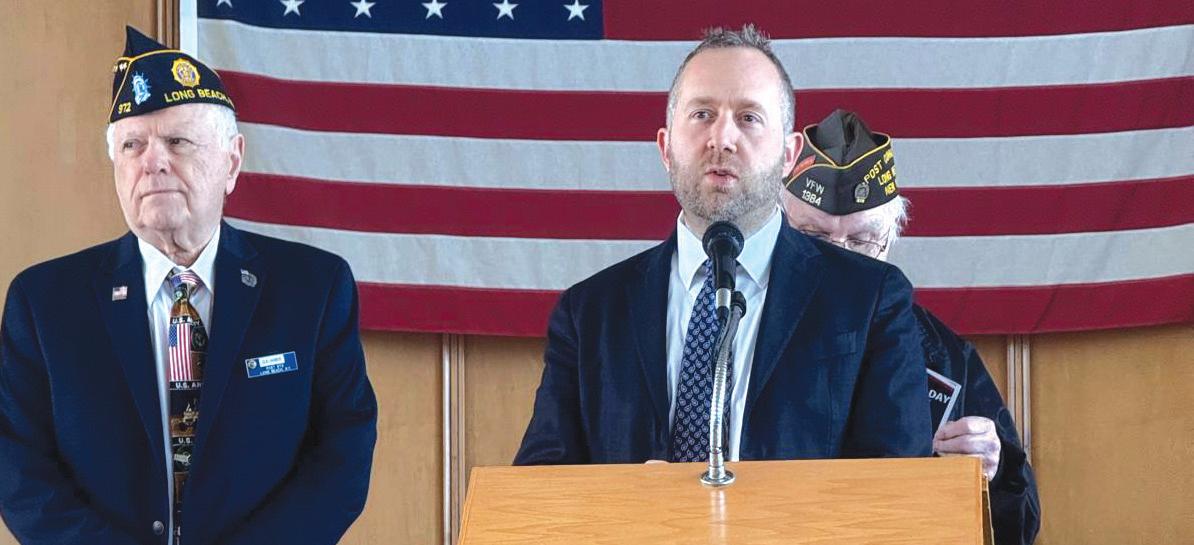
Rabbi Benny Berlin delivered the Invocation at Long Beach Veterans Day Ceremony at City Hall
The fourth graders in Mrs. Zicherman’s class at Yeshiva of South Shore have been cultivating an attitude of gratitude! Throughout the month of November, the boys have been focusing on the middah of gratitude, learning about the importance of appreciation and the many ways we can express it.
Through engaging lessons and meaningful discussions, the students explored who deserves our gratitude and why expressing it matters. To deepen their understanding, the boys took part in a classwide scavenger hunt that challenged them to think creatively about new people worthy of their thanks.
After brainstorming together, the class compiled a thoughtful list of meaningful ways to show gratitude. Each student then wrote a beautiful piece highlighting one special person in their life and describing specific ways they could express appreciation to them.
This lesson encouraged the boys not

just to recall what they had learned, but to apply it in a personal and heartfelt way which demonstrated true understanding and reflection. As the students discovered, when we train our minds to focus on what we’re thankful for, we use our ayin tov to continually see the good in the world around us.
Talk about an attitude of gratitude!



Tech in Check superstar talmidim at YOSS celebrated a month of excellence with bowling and cash with TIC Commissioner Rabbi Yitzy Haber
It is no easy task winning at Model Congress Congressional Debates, but senior Henach Barningham won first place this past Wednesday night!
To win is one thing, but to do so with a perfect score, as Henach did, is almost
unprecedented. Henach has represented the school at Debate Nationals in Iowa in the past, and Rambam looks forward to him representing the school at Nationals this year in Virginia.

Scott Galloway, AKA Prof G, host of The Prof G Pod business podcast and author of numerous books, was interviewed by actor and director Ben Stiller of Night of the Museum and The Secret Life of Walter Mitty Fame.
A dozen students attended this sold-out event accompanied by Mr. Avrumi Weinberger, Assistant to the Administration.
The subject of the night was Galloway’s new book, Notes on Being a Man, which dissects the challenges facing young men today and offers solutions to many of these problems. A great deal of Stiller’s movies explore masculinity, especially his later work, and he and Galloway are old
friends, so the discussion was informative and lively.
Some of the students were fortunate enough to have Galloway sign their books and were able to get photos with him, while Mr. Stiller said hi to a few people but had to make a quick exit. For a man named “Stiller,” he was moving pretty quickly by night’s end.
Next up, the Meet The Author Book Club is already looking forward to a Zoom interview with author Chuck Thompson, The Status Revolution, on December 1, while the Classic Film Club is gearing up for their Civic Spirit Film Festival.

Mercaz Academy’s fourth-, fifthand sixth-grade students got a firsthand look at democracy in action last week when State Senator Steve Rhoads came for a visit on Election Day, bringing insider insights into civic responsibility, lawmaking, and representation and advising Student Council candidates on their own campaigns.
After preparing for the visit with a deep dive into how the New York state and federal governments work and the differences between them, led by Mercaz President Jeff Lichtman, the students met with Senator Rhoads, who began by explaining New York’s government and the role of the State Senate. The Mercaz students, who have also met with Congressman Tom Suozzi and Assemblyman Charles Lavine during previous school visits, peppered Senator Rhoads with questions about his work as a legislator.
Emphasizing the value of public service, Senator Rhoads told the students that representing others in government,

whether at a state, federal, or elementary school level, should always be motivated by a desire to help and a willingness to listen. The Senator was impressed by the many ways Mercaz students are working to make a difference in their communities, including by donating books and clothes, volunteering at school to help their peers, and donating hair to benefit
This past Sunday, Mesivta Netzach HaTorah hosted its annual Open House, welcoming an enthusiastic crowd of prospective talmidim. Families attended from across the Five Towns, Far Rockaway, Brooklyn, Queens, and Great Neck, filling the Beis Medrash to capacity and creating an atmosphere of energy and anticipation.
The program opened with remarks from the Menahel, Rabbi Yitzchok Yurman. Rabbi Yurman spoke about the Mesivta’s philosophy, explaining how Netzach blends traditional, time-honored methods of chinuch with a thoughtful understanding of the needs and challenges facing today’s young Bnei Torah. He described the rebbeim’s deep commitment to their talmidim—not only in the classroom, but in the countless interactions that build confidence, deepen middos, and nurture personal growth. Rabbi Yurman illustrated this with a powerful story demonstrating how every talmid is truly seen, valued, and supported, emphasizing that the Mesivta’s warm environment is a deliberate and foundational priority. Following his remarks, the General Studies Principal, Rabbi Etan Tannen-
baum, highlighted the Mesivta’s academic vision. He explained that Netzach is a mission-driven Mesivta focused on shaping impressionable boys into impressive young men—balanced, thoughtful, and prepared for success in whichever path they choose. Rabbi Tannenbaum discussed the Mesivta’s commitment to academic excellence and the cultivation of curiosity, noting the Mesivta’s partnerships with SUNY schools and TRIO, which allow students to earn college credits during their high school years, providing them with meaningful opportunities in pursuing their personal academic goals.
The audience then heard from current talmidim, who offered personal perspectives on their experiences. Ninth grader Yechezkel Stern shared how quickly he felt at home in the Mesivta, noting the genuine warmth he experienced from both Rebbeim and fellow talmidim. He spoke with understanding to the prospective students about the uncertainty of choosing a high school and expressed heartfelt confidence that choosing Netzach was the best decision he ever made and assured that it will be the best decision any prospective talmid will ever
children with cancer in Israel.
The conversation then turned to our own upcoming elections. Senator Rhoads asked students what qualities they were looking for in a candidate and challenged the candidates to explain why they wanted to run. He reminded them that being a representative means serving not just those who agree with you,
but everyone in the school. One student summed up the challenge with a smile: “I think whoever wins should make the school a better place—which will be really hard, because this school is already such a great place!”
Both the Mercaz students and Senator Rhoads came away from the event impressed. “I think he was inspiring,” said one sixth grader, while Senator Rhoads called the students “fantastic.”
“It was really inspiring to listen to the difference that they’re making in the school community and in the larger community,” he observed. “Even as 10, 11 and 12-year-olds, it’s amazing to see their interest and their passion. They asked some terrific questions, some harder questions than I get out of Albany!”
The Senator added, “I’ve spoken to a lot of fourth, fifth, and sixth graders. This is probably the best group I’ve ever spoken to.”

make as well.
Twelfth grader Rummie Friedman reflected on his journey throughout his four years in the Mesivta. He described how the Rebbeim and Hanhala consistently encouraged him to strive higher—both in learning and personal growth—and how these relationships shaped him into the Ben Torah he is today. His words offered a testimony that the the connections that he has formed with his rebbeim and friends will last a lifetime.
The program concluded with a short
video presentation featuring various talmidim, alumni, parents, and rebbeim, highlighting the distinctive qualities that personify this Mesivta. With this small glimpse, everyone saw how choosing Mesivta Netzach HaTorah will provide a four year journey and a Talmid’s lifelong path.
To watch our Open House video presentation and apply for the upcoming year, please visit netzachhatorah.org/openhouse.

While preparing for Shabbos is always a major focus in HANC’s Early Childhood Division, the preparations began extra early this week in anticipation of the special international Shabbos Project. In order to prepare a tasty treat to enhance their family’s celebration of Shabbat, the young children had the opportunity to make a delicious challah. They chose their own type of challah to bake, including raisins, chocolate chips or sprinkles. As the children measured the ingredients and prepared the dough, they utilized their science skills as they watched the yeast interacting with the liquid and marveled at how the dough expanded over time. After braiding the challah, the challot were placed in a pan to be brought home so that their families could also enjoy the magnificent scent of challah baking before Shabbat.
While learning the parsha, the yeladim learned the mitzvah of hachnasat orchim. Each classroom put up a tent that the children could play in and reenact

the mitzvah of welcoming guests to their homes. They then invited their friends in other classes to visit their tent and offered them a special treat to enjoy.
After all of the preparations were complete, each grade gathered for a musical Shabbos party with Rabbi Ouriel Hazan, Head of HANC’s Reinstein Family Campus in West Hempstead. As HANC
Early Childhood Director Morah Trudy Rubinstein added, “To see the joyfulness of all of the yeladim singing together was an absolutely beautiful sight.” Concluding this energetic and exciting event, the children received yummy treats in the classroom to usher in the sweetness of Shabbat.

The Yeshiva of South Shore Open House, held this past Monday evening in the beautiful new Friedman Family Building, was a smashing success, drawing over 80 parents and guests eager to experience what makes YOSS go “Above & Beyond” every day. Attendees were warmly welcomed by the YOSS hanhalah and faculty, who shared the Yeshiva’s vision of excellence in Torah learning, character development, and academic growth.
Rosh Yeshiva Rabbi Mordechai Kamenetzky spoke passionately about how, to a parent, a child is everything — and how the Yeshiva shares that same perspective, investing everything into every talmid. Each menahel and principal spoke

By Rabbi Baruch Fogel
What is education? A seemingly straightforward question, with a surprisingly complex answer. Education, of one’s students, of one’s children, and above all, oneself, is understanding what is wanted from you in the present, and not what is demanded of you in the future. This unexpected answer was the main takeaway from the many speeches given by Rabbi Reuven Leuchter this past week.
The Five Towns community was privileged to host Rabbi Reuven Leuchter this past week. He was the scholar in residence at the Irving Place Minyan (IPM) this past Shabbos, Parshas Vayeira. At the Friday Night Oneg, Rabbi Leuchter addressed the overflow crowd and spoke about the importance of recognizing how our own lives educate us. He said we must possess an emunah in Hashem that the situation that He has placed in front of us is meant to educate. Once we understand, and recognize, that Hashem wants us to grow from the situations that He places us in, we have begun the process of education.
a manner that is accessible to our generation. He also publishes a weekly transcription, in both English and Hebrew, of the main mussar vaad of that week, which can all be accessed through his website meihadaas.com.
The Mei HaDaas institute is also the headquarters of a recently launched unique endeavor in the field of chinuch. Every afternoon, 30 of the top maggidei shiurim, from the best yeshivas in Israel, gather at Mei HaDaas. Of course, these maggidei shiurim, who are each responsible for the education of hundreds of bochurim, spend their time learning and preparing for the coming shiurim that they will give. However, the uniqueness of this institute is the fact that they gather together to be educated and guided how to be better educators.
briefly about how they ensure that the Yeshiva consistently goes above and beyond for its talmidim, providing a warm, inspiring, and growth-oriented environment.
Guests toured the state-of-the-art building, met members of the hanhalah and dedicated volunteers, and saw firsthand the vibrant atmosphere where talmidim thrive every day.
The event underscored how YOSS continues to nurture each child’s potential with care, warmth, and a steadfast commitment to chinuch that truly goes Above & Beyond in every sense.
Applications for the 2025–2026 school year are now open at yoss.org/applications
Shabbos morning, at the Woodmere Club minyan of IPM, Rabbi Leuchter delved further into this topic. He challenged everyone to develop an emunah that Hashem is interested in each and every one of us. Davening, at its core, is predicated not on my desires to receive from Hashem, but instead, on building a relationship with Hashem predicated on the fact that He is interested in hearing from us, and He wants to help us, and push us, to grow in every aspect of our Avodas Hashem.
Rabbi Leuchter is the head of the Mei HaDaas institute. Through his institute, he impacts thousands through his weekly Zoom shiurim and vaadim. Additionally, he has recently published a new edition of the Ramchal’s Daas Tevunos with an extensive commentary that breaks down the foundational ideas of the Ramchal in
Rabbi Leuchter, a talmid muvhak of the Mashgiach Rabbi Shlomo Wolbe, zt”l, created Mei HaDaas in order to help the next generation of educators, and his experience has shown that the most necessary tool that an educator needs is the ability to educate themselves with the emunah that one’s life, in the present, is the underlying starting point of education.
On Tuesday, Rabbi Leuchter visited DRS and presented a synopsis of these ideas to the rebbeim in our community as well. Rabbi Elly Storch, a long time talmid of Rabbi Leuchter, was instrumental in bringing him to DRS, where Rabbi Leuchter explained the emunah that each one of us must have in Hashem’s desire to educate us, in addition to the emunah that each and every one of us, and our students, are wanted by the Torah. This paradigm shift in thought – that the Torah wants, and needs, every Jew – is at the heart of Rabbi Leuchter’s educational mission, and we hope that our community will have future opportunities to learn from him.
Rabbi Baruch Fogel is a rabbi at IPM and HAFTR High School.

Bikur Cholim of the Five Towns and Rockaway launched its newest initiative, Be The Light, with an inspiring kickoff event featuring Rabbi Joey Haber. The program aims to engage post-seminary and single women in meaningful volunteer opportunities that bring comfort and support to families in crisis within our community.
The evening drew an incredible turnout of young women eager to make a
difference. Attendees expressed deep gratitude for the chance to connect, contribute, and be part of something greater than themselves. Rabbi Haber’s uplifting message highlighted the power of each individual to bring light to others. This is just the beginning of a beautiful movement — empowering our community’s young women to shine their light and help countless families in need.

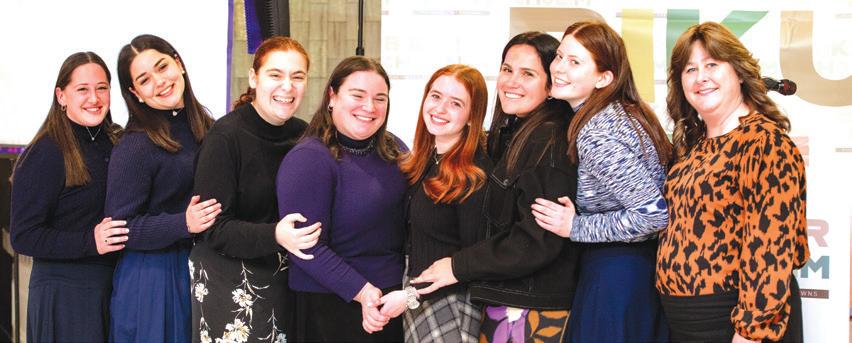

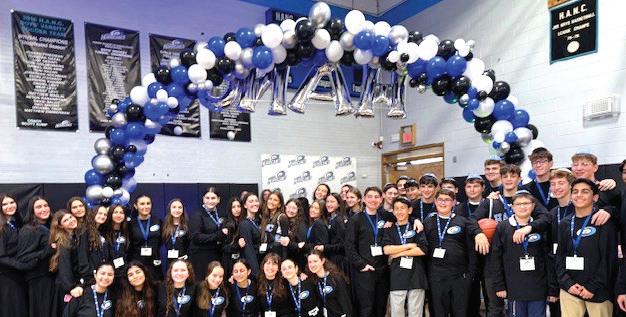
On Sunday morning, November 9, HANC High School welcomed eighth grade prospective students and parents to its annual Open House. Nearly five-hundred guests participated in the event! Guests signed in with the assistance of HANC parent and student volunteers, and those who pre-registered received personalized schedules for both the parent and the student. The program showcased the HANC High School experience emphasizing the theme, HANC Makes IT Happen.
After an elaborate breakfast by Grapevine Caterers, the program began with opening remarks from HANC High School Menahel, Rabbi Eli Slomnicki, ’97, who, along with current students, described the three main components that define this outstanding yeshiva: Aspirational Academics, Community Focus, Torah.
The program opened with Student Senate president Halle Hakimian welcoming the visiting students and parents. Freshman Henry Kaye recited the Mishebeirach Lechayalei Tzahal. Current High School students Molly Leifer ‘27, Elisheva Schutzman, ‘28 and David Alper ‘28 from three different middle schools (YHT, YCQ and HANC respectively) and neighborhoods (West Hempstead, Flushing and Oceanside respectively) warmly addressed the guests. Each described their individual experiences relating to one of these core values, and what they specifically enjoy about being at HANC. They helped paint the mosaic of the HANC difference.
Two videos were featured which showcased our separate boys and girls Limudei Kodesh programs and the Academic and Student Experiences.
Parents and students then proceeded to classrooms for mini-lessons and course sequences given by our esteemed faculty in both Limudei Kodesh and General Studies. Following the lessons, students and parents participated in numerous informational sessions. Parents participated in an Academic Showcase in our new multipurpose rooms called ‘Canes Common space, meeting administrators, directors and department chairs who were on-hand to answer questions.
Prospective parents then explored Campus Life via panel discussions consisting of current students from various middle schools, parents and HANC alum, Yoni Goldenberg ‘16. Simultaneously, prospective students chose two of four elective offerings within the Student Expo. This showcase featured a STEM Expo, Art Gallery Tour, Hurricane Athletic Press Conference, and our Student Panel.
The program concluded with an expansive and awesome Club Fair, where students learned about athletics and the incredible selection of co-curricular clubs and teams available to HANC High School students. Our newest offerings include Sport Skill Advancement and Women in Medicine. Guests were awed by our student ambassadors and how HANC Makes IT Happen with an appreciation for the rigor, warmth, and individualized programs and opportunities offered at HANC High School.
Apply at https://hs.hanc.org/ and for questions, please email our Director of Admissions, Mrs. Elynn Rosenberg at erosenberg@hanc.org.

The Chevra Mishnayos at YOSS is a volunteer learning program that was adopted by the eighth grade and is led by Rabbi Neuman, eighth grade rebbi. The goal of the program is to help the students gain a bekius in Mishnayos that are not generally taught as part of their curriculum. Students that are part of the program learn a new Mishna every day and review the previous three

days’ Mishnayos. This way, each student is learning four Mishnayos every day. Shabbos is meant to review all the Mishnayos from the week. The students are required to find their own time during the day to do the learning, and it cannot impact their regular classes.
Baruch Hashem, the majority of the eighth grade student body has joined this incredible program!

This past Sunday, the former world-renown professional basketball player, Tamir Goodman, visited the boys of TAL Academy. The students were mesmerized by Tamir’s stories of his youth as a child with dyslexia who found his place on the basketball court, learning that his weakness in reading came with an extra sense in seeing things on the basketball court that others did not see. Still, his father, a”h, taught him that even in our greatest moments of success we must remember that all our talents come from Hashem.
Tamir shared with the boys how his hard work and dedication to practicing over and over again helped him succeed. He made a beautiful connection to the davening of the TAL boys he heard in the building prior to his talk. Tamir asked
the boys why we daven the same tefillos every day? He explained that it is similar to the daily practice of a professional athlete that develops muscle memory allowing him to play well even under pressure in front of large crowds.
The boys were also impressed when they heard that Tamar always wore his yarmulka and never once played on Shabbos throughout his career even if it meant not playing in important championship games.
The highlight of the morning was when Tamir played basketball with the boys, giving them pointers and letting each one practice his shots. Tamar’s example of making a kiddush Hashem using his talents is one the boys will remember for a long time to come.

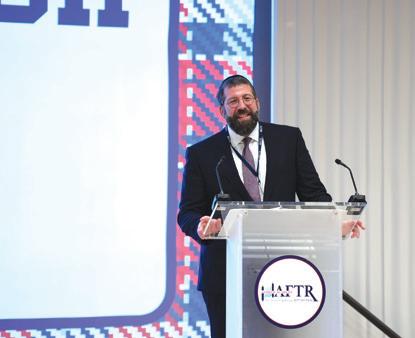
This past Sunday, HAFTR High School opened its doors to prospective students and their families for a memorable and engaging Open House that truly captured the spirit and strength of the HAFTR experience.
The Open House began with a special welcome from HAFTR’s leadership team: Head of School Ms. Naomi Lippman, Principal Dr. Josh Wyner, Rosh Yeshiva Rabbi Ira Wallach, and Student Government Co-Presidents Tehilla Kaffash and Zachary Strauss — accompanied by a podcast video featuring students sharing their unique positive experiences at HAFTR. This presentation took place in the High School’s newly renovated, stateof-the-art auditorium, offering guests a glimpse into the school’s continued in-

vestment in excellence, innovation, and community.
Following the introduction, families were guided through a dynamic campus tour designed to highlight the academic and extracurricular opportunities that define the HAFTR experience. Stops included the school’s award-winning STEM program, where hands-on projects in the cutting-edge maker space showcased how HAFTR empowers students to bring creativity and critical thinking to life, and the renowned Art Institute and Maker Space, where visitors admired a display of student artwork that reflected both talent and passion. In the humanities and science classrooms, prospective students participated in interactive mini-lessons, experiencing HAFTR’s

engaging and collaborative approach to learning. Model shiurim led by HAFTR’s acclaimed Rebbeim and Morot gave families a taste of HAFTR’s rich Limudei Kodesh program.
A favorite feature of the day was the beloved Creating Connections activity, a unique opportunity for prospective families to engage in a “speed meet.” These fast-paced, meaningful conversations with faculty and current students offered an authentic window and personalized insights into HAFTR’s vibrant school culture, highlighting the relationships, mentorship, and sense of belonging that make the HAFTR community so special.
The day concluded with a warm and inviting collation in Satran Arena, where families continued conversations with
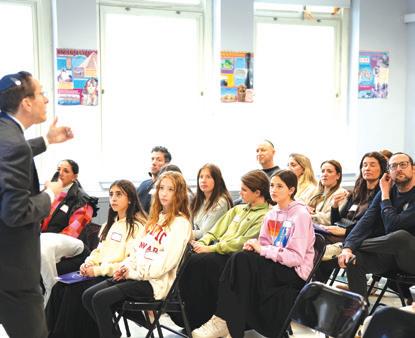
teachers, students, and administrators. The energy in the room reflected what makes HAFTR High School truly exceptional: combining academic excellence with genuine care. At HAFTR, intellect meets inspiration, Torah and learning intertwine, and every student is seen, supported, and celebrated.
If you expressed interest but were unable to attend, our team will be in touch soon. For any questions about the application process, please contact Mr. Elie Hirt (elhirt@haftr.org) or Mrs. Rachel Graham (ragraham@haftr.org).
We can’t wait to welcome you to the HAFTR family next fall!
Apply at https://www.haftr.org/admissions/
Researchers at Touro University have found that an AI tool identified suicide risk that standard diagnostic tools missed. The study, published in the Journal of Personality Assessment, provides evidence that large language models, a type of AI that processes and analyzes conversational language, show promise for detecting who is at risk of attempting suicide.
“It’s very difficult to predict who might attempt suicide, which makes it hard to know who to help and when to intervene,” says Yosef Sokol, PhD, clinical assistant professor, School of Health Sciences at Touro and lead author of the study. The current methods for assessment are not very accurate. They typically rely on people answering multiple choice questions about themselves. The questions lack nuance and often don’t reflect people’s unique experiences, and people may worry about directly answering questions about suicide.
“I’m trying to create a set of methods that enable us to assess for suicide risk
without asking direct questions,” says Sokol. “We can do that by using the characteristics of language to predict suicide.”
Large language models (LLMs) are machine learning AI programs that comprehend and interpret human language.
In the study, the researchers used LLMs to assess a concept called future self-continuity, which is how a person sees the connection between their present self and future self. “Having a sense of oneself that continues into the future is a core aspect of healthy identity and its lack is strongly related to suicide,” says Sokol. But because future self-continuity is very nuanced, standard tests are not good at detecting it.
The study used an LLM (Claude 3.5 Sonnet) to process audio responses to 15 interview prompts of people talking about themselves and their futures. It included 164 participants, with 93 of them having past-year suicide ideation. The researchers first asked the participants to rate their risk on a 1-7 scale of how likely they were to attempt suicide in the future.
They compared the results of the LLM and standard assessment tools to that self-reported perceived risk.
The LLM found patterns in natural speech that standard methods miss such as how coherently someone describes their future, their emotional tone, and the level of detail they provide. “We got a better measure of future self-continuity and were better at predicting if people thought they would attempt suicide,” says Sokol.
This study compared LLM insights to perceived risk of suicide, not actual attempts at suicide. But perceived risk is important for healthcare providers to know. Research shows a person’s perceived risk does predict actual suicidal behavior, and even without a future attempt, it’s important to identify people who feel that they are at risk of attempting suicide.
LLM could be used in any setting, such as a hospital, crisis hotline, or even with a therapist. “We want to create a system where a therapist could ask you a set of

2-3 questions and record it, and the LLM could produce a risk score,” says Sokol. LLM could potentially be used to help detect many mental health disorders such as depression or anxiety. These may be even easier to detect than risk of suicide. “Suicide may be one of the hardest to detect, and, to save lives, the most important,” says Sokol.

Yeshiva Darchei Torah’s talmidim of grades 1 through 8 were treated to freshly scooped ice cream cones from a Cholov Yisrael ice cream truck last week. This served as a kickoff for the Sh’nayim Mikra V’Echad Targum program. Special thanks to the Yeshiva’s Women’s League.
Throughout the halls of the Yeshiva University High School for Girls (Central) last week, one word was on everyone’s lips: Shabbaton. The annual schoolwide Shabbaton – which took place this past Friday and Saturday, November 7-8 – remains one of the most anticipated events of the year, uniting all four grades, faculty, and faculty families for a weekend of learning, laughter, and spiritual connection.
The YUHSG theme for the 2025-26 school year, B’chol L’vavcha U’vchol Nafshecha: Full Hearts, Full Souls, was reflected throughout Shabbaton 5786’s activities, helping students explore what it means to live with that concept in their daily lives. Central’s Director of Activities, Judaic Studies faculty member Mrs. Sydney Yaros, said that Shabbatonim provide a valuable opportunity for growth. “It’s a time to come together as a community –to bond and learn and sing and have fun,” she reflected. “The Shabbaton theme this year is ‘Heart to Heart.’ A big part of our focus will be davening and what it means to speak to Hashem both through davening and through more informal ways – and how central our davening is to our relationship with Hashem, and to figuring out our own individual paths.”
The weekend began on Friday morning, when students and faculty departed together for the Camelback Mountain Adventure Park. Upon arrival, students jumped into a full schedule of spirited programming, including settling into accommodations at the Camelback Resort. Friday evening brought Shabbos, with candle lighting, Mincha, a welcome from YUHSG G.O. Co-President and senior, Shalhevet Koenigsberg, freshman


and senior Divrei Torah, a festive dinner, and, of course, the annual, much-beloved YUHSG faculty skit, followed by an oneg and a panel for the senior Wildcats. Shabbos day brought more grade-bonding activities designed to strengthen the sense of community that defines YUHSG, including Divrei Torah from sophomores and juniors, “Choose Your Own Schmooze” sessions with YUHSG faculty, a shiur, shaleshudus, and singing, and closing words from YUHSG G.O. Co-President and senior, Eliana Gomberg. Saturday ended with Motzei Shabbos Melava Malka, a DJ, and exclusive privileges at the Aquatopia Indoor Water Park. The group returned to the Holliswood campus on Sunday morning, rejuvenated and newly bonded.
There’s no better way to begin the new school year than together — celebrating, connecting, and living the spirit of Shabbat as one schoolwide family. And there’s more to come on the YUHSG calendar: Student-Teacher Conferences have been revived and will be held on Tuesday, November 11. The much-anticipated annual Freshman Family Panoply will be held on November 22, giving the newest Wildcats and their families a chance to deepen their YUHSG connection. Lastly, Parent-Teacher Conferences will be held on campus, live and in person, on December 3.
Shulamith ECC constructed an “ohel” and invited guests inside alongside “Avraham Avinu” and “Sara Imeinu”




By Esther Mochan

Our dear father’s levaya was on Veterans Day 2012. How befitting, that a man who invested 21 years of his life in service to this country in the United States Army, would have his burial on that day.
Of all the myriad of titles which my father successfully and valiantly achieved and earned in his lifetime, the ones that were most valued and cherished, and of which he was most proud of, were “Dad” and “Zayde Jack.” His family always came first, above all else, and his deep love and devotion for my dear mother, a”h, for my sister and myself, were a blessing and special gift from Hashem to us.
How is it possible to put into a few words a 21-year military career of dedication to serving our country and Klal Yisroel, reaching out, protecting, caring, and saving thousands of Yiddishe neshamos , Jewish souls. My father was the link to Yiddishkeit for so many soldiers who clung to him, turned to him and depended on him spiritually, emotionally and physically. Rabbi Jack, as he was fondly called, was Hashem’s shaliach , and his life was devoted and immersed in doing Hashem’s work. He accomplished great feats, rose above many challenging life situations, and did so much for so many.
My father taught by example: self-
lessness and caring for others before him, always remembered for his beautiful, radiant smile, and his endearing way of greeting every human being with “sever panim yafot.”
He was a career military chaplain and succeeded in achieving the high and distinguished rank of Colonel. He was the highest-ranking Jewish chaplain in the United States Army in his time. My father taught us the power of reaching out to others and having emunah in Hashem. He did an abundance of kiruv work in the army and prevented much intermarriage from taking place. His chaplain’s office, whether in the United States, in the many places that he was stationed, or in Europe, was a safe haven for soldiers, who were alone and away from their families and loved ones. He gave chizuk and guidance, held them, comforted them, and consoled them. Dad and Mom’s home was a home with an open door and open hearts. I remember many visits from soldiers, all hours of the day and evenings. The young Jewish soldiers were always guests at our Shabbos table. The warmth in my parents’ home was palpable. With the immense, dedicated and unified efforts of both our parents, whether in the states or in Europe, my sister and I were privileged and blessed to be raised in a home that was filled
with Torah and chessed.
My father was a man of the world, yet he was firmly steeped in Torah values. He could give divrei Torah on any subject.
Dad had great emunah and was always confident that Yad Hashem, the Hand of G-d, protected him always. This was especially evident during his year in Vietnam. He told us of a bunkbed that he slept in, that was in a hut surrounded by other huts of soldiers. A grenade and artillery attack was made in their camp. The attack leveled all the huts that surrounded my father’s hut and killed and injured many of the soldiers in these huts. Even the soldier who was sleeping in the lower bunk of the same bed as my father was injured. Dad was sleeping on the top bunk and was untouched by any shrapnel. He considered this a true miracle, and only one of the many signs that he had of the Shield of Hashem with him at all times. Although there was always constant danger in the battlefield, Dad put up the first sukkah in Vietnam for the young Jewish soldiers.
To my father, every Jewish neshama was sacred. While flying in a helicopter over the battlefield area, my father heard over the radio that there was a man wounded and had to be left because it was too dangerous to go down
on the ground to get him. He called into his commander and asked the name of the wounded soldier. They would not give the name, as this was against the protocol, so he pulled some strings and some “rank” and called another source, and found out that the soldier had a Jewish name. He instructed the helicopter pilot to turn back and go down and pick up the wounded soldier. The pilot tried to convince my father not to go down into this dangerous territory, but my father insisted and was able to bring this soldier into the helicopter and take him to safety. He would never leave a Jewish soldier to die, even if it meant risking his own life to save him. My father always joked that on that day, he got a slight “demotion” for not listening to protocol and the commander, but that he knows for sure that he got a “promotion” in Shamayim, and that’s all that really matters.
My father was awarded many medals and was highly decorated over his 21year career for his valiant and dedicated service to our country. He received two “Legion of Merit” awards for his meritorious conduct in Performance of Outstanding Services. It is rare for this award to be given at all in an officer’s career, but my father received the award two times.
When my sister and I were in our
mid-teens, my father commuted to Ft. Dix, New Jersey, where he was stationed at that time. He was the Chief Jewish Chaplain there. My mother stayed with us in New York, so that my sister and I could continue in our yeshiva high school that we were attending. After my father completed his years in Ft. Dix, the government offered him to go to Europe for another 3-year tour. They told him that as soon as he would go overseas, he would be promoted to General. This would have given him the honor of being the first Jewish Chaplain General in the history of the United States Army. Although this would be very tempting to most, my father, without any hesitation, declined the offer. He knew that uprooting his family at this juncture would be detrimental for us, and we would not have the “Yiddishe” schooling and socialization that he knew was so important for his teenage daughters.
My father never looked for any honor or kavod. His family came first. He was an anav, a humble man, a true tzaddik.
Another clear example of Dad’s emunah in Hashem was when he was being wheeled into the operating room for a
major surgery. I was with him as they were about to wheel him into the operating room. The nurse took his blood pressure, and it was a perfect 120/80. She was shocked, as most patients about to undergo such a procedure are agitated and very nervous. They often have such elevated blood pressure levels
My father was a Chazan, and he was blessed with a beautiful voice. His davening on Rosh Hashana and Yom Kippur moved the kehilla to tears. He and my mother met while singing in choir together at the Young Israel of Bushwick in Williamsburg, Brooklyn. It was a start of a life of “harmony” and love, a
My father was the link to Yiddishkeit for so many soldiers who clung to him, turned to him and depended on him spiritually, emotionally and physically.
that sometimes it is necessary to cancel a surgery. When the nurse asked my father how he was able to be so calm, his response to her was simply, “I have nothing to worry about… G-d is watching over me, He is with me, taking care of me, and He will protect me.”
Emunah and bitachon always.
fabulous journey, which separated them only in her death. They were two birds that flocked together – two hearts that beat as one. Our home was always filled with song, love, laughter, comfort, joy and warmth.
My father never complained and never wanted to be a burden on anyone.
He was the supreme giver…never a taker. The aide who helped out with Dad for the last few years of his life told us at his funeral that Dad was a “prince.” She said it was such an honor and a privilege to work for such a prince of a man, a perfect gentleman with a regal presence.
Although it has been many years since our parents were niftar, I still remember a beautiful analogy that one of the grandchildren said about them at the shiva for my father. She compared Bubby Malky to a kallah at her wedding badekin, anxiously waiting to soon see her chosson who is coming towards her. The joy, excitement, and euphoria that they are feeling were as strong, if not stronger, than those felt by a chosson and kallah on their wedding day.
We know that together they are watching over us, and over Klal Yisroel, just as they did in life and doing their best to send refuos, yeshuos, shalom and brachos for us all.
My father was a pillar of strength. A beacon of light.
Dad, you are our hero, and we salute you. As your yahrtzeit approaches, may your neshama have an aliyah.



The Arctic Intern: “Keeping it at keeping it at 55° builds character” (says the person who cries for three days when he gets a splinter).
The 2:17 A.M. Ninja: Raises it 4 degrees in total darkness, then sprints back to bed like a guilty cat.
The Temperature Judge: Hands on hips, staring at the thermostat like it just committed a Class A felony.
The Passive-Aggressive Thermostat Operator: Looks at the thermostat and sighs loudly enough for the whole house to hear that he thinks that nobody but him knows how to use the thermostat.
The Diplomat: ”Let’s compromise…72.5.” (Hmm…we really needed Jared Kushner and Steve Witckoff for that one!)
The Walking Weather Channel: “It feels like 64.2. This morning it felt much warmer in here, and yesterday was perfect.” (In other news…it is slightly cloudy in Oklahoma today.)

The Thermostat Historian: “Back in my day, we didn’t even have heat… We all sat around the stove.” (Uh, you were born in 1982!)
The CFO of Warmth: Begins every adjustment with, “Let me explain energy bills to you.”
The Layer Enthusiast: “Just put on another sweater!” (I already look like I’m wearing all the sweaters from the shul’s lost-and-found, plus three from Costco.)
The HVAC Mixmaster: Hangs out at the thermostat, constantly adjusting it. (When you are DJ-ing the thermostat, you are really the most boring person in the world.)
The Weather Denialist: “It’s not cold.” (Yeah, for Siberia, but around here, 12 degrees Fahrenheit is not exactly Miami Beach.)
The Stealth Raiser: Moves it one degree every hour until everyone is fainting from heat exhaustion.
The False Accuser: Changes it. Forgets. Accuses everyone else of treason.
The Thermostat Dramatizer: If the temp changes 1°, they act like the Titanic is sinking.
The Shower Hypocrite: Takes 40-minute hot showers but insists 63° is “perfectly warm.”
The Contrarian: If you are hot, he is cold; if you are cold, he is hot. (How do you spell c-o-n-t-r-o-l f-r-e-a-k?)
The Human Thermostat: Can detect a one-degree change from three rooms away.
The Draft Detective: Patrols the house for “rogue breezes” like a mall cop.
The Winter Denier: “It’s not winter until after Thanksgiving.” (Uh, there’s a howlin’ blizzard outside!)
The Heat Traitor: Turns on the AC in November. Should be tried at The Hague.
1. What part of the body loses heat the fastest?
a. Hands
b. Feet
c. Head
d. Knees
2. What U.S. city experiences the largest difference between summer and winter temperatures?
a. Minneapolis, MN
b. Fairbanks, AL
c. Detroit, MN
d. Jackson Hole, WY
3. What everyday household item was originally invented to keep houses warm in winter?
a. Carpets
b. Window blinds
c. Stoves
d. LED lights

4. Which material traps heat the best?
a. Cotton
b. Linen
c. Wool
d. Polyester
5. Before modern-day heating, what did families sleep with for warmth?
a. Warm rocks
b. Heated spoons
c. Fireplace ash
d. Bed warmers filled with hot coals
c. 31 degrees
d. 49 degrees

Answers:
6. The fastest temperature drop ever recorded was in South Dakota on January 22, 1943. How many degrees did it drop in 2 minutes?
a. 16 degrees
b. 23 degrees
Wisdom Key:
5-6 correct: You are the ultimate HVAC guy… F150 MAGA pickup truck that runs on Guns, Fuel and G-d!
2-4 correct: You are average… which means that if you were a heating bill, you’d be around $2,500 a month!
0-1 correct: Brain freeze?
Sadie texts her husband Yankel, “Windows frozen, won’t open.”
Yankel texts back, “Gently pour some lukewarm water over it and then gently tap edges with hammer.”
Sadie texts him back 10 minutes later, “Wow, the computer seems really messed up now.”

Heat, because you can catch a cold!
Answer:

The death of a parent at any stage of life and at any age is a tragic and traumatic experience. I find that the grief is more profound for the surviving spouse than even for the surviving children. Children somehow find a way to move on with their lives. They factored in the inevitability of the death of a parent into their subconscious and thus usually were and are able to deal with their loss. Not so with the surviving spouse who never imagined being left alone and bereft especially in old age. Abraham remarries Hagar/Keturah and even fathers children from her. But his concern and fatherly love is concentrated on his son Yitzchak, the son of his beloved Sarah. Through Yitzchak, Sarah is still alive and present in the life of Abraham. Abraham’s concern regarding his son being unmarried is somehow reinforced by the continuing subconscious presence of Sarah in his life. The rabbis teach us that when Rebecca arrived at the home of Abraham and Isaac, the “presence” of Sarah returned with her. Her candles became lit again, her bread
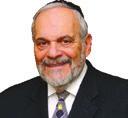
By Rabbi Berel Wein z”l

was once again blessed in her home ,and her spirit of holiness and G-dliness hovered once more in the tent of Abraham and Isaac. Rebecca was Sarah incarnate. People say that men, so to speak, always seek to marry their mother. Rebecca becomes Sarah to both her husband
for Yitzchak who is descended from Sarah’s family. Eliezer is not to take a woman from any other genetic stock to be considered for marriage to Yitzchak. There are many explanations to these instructions given to Eliezer. But certainly, the simple explanation and ob -
Sarah lives on through Rebecca and through all Jewish women throughout the ages who emulate her and live by her value system and way of life.
Yitzchak and her father-in-law Abraham. This is one of the more amazing insights that this week’s parsha offers for our consideration and education.
All of this is implicit in Abraham’s instructions to his trusted servant and agent Eliezer. He tells him to find a wife
vious insight is that Abraham is committed to find another Sarah through whom the Jewish people will be built and preserved. Eliezer is apparently unaware of this insight, so he concocts an elaborate scheme as to which woman he will choose to bring back as a wife
for Yitzchak. He is not looking for Sarah as much as he is placing his mission in the hands of G-d to send him the proper woman. The L-rd complies, so to speak, but it appears that Eliezer is never conscious that he is really looking for a Sarah.
That is why, according to Midrash, Eliezer harbors within himself hope that perhaps his own daughter, who is not Sarah by any stretch of the imagination, could be a potential bride for Yitzchak. It is the L-rd, so to speak, that is in on the secret of Abraham’s wishes and provides Yitzchak with a wife who brings him solace and closure after the death of his mother.
She is able to do so because of her uncanny G-dly ability to be Sarah in a spiritual and emotional sense. Perhaps this is why the parsha begins “these are the lives (plural) of Sarah,” for Sarah lives on through Rebecca and through all Jewish women throughout the ages who emulate her and live by her value system and way of life.
Shabbat shalom.
When Avraham wants to find a wife for his son Yitzchak, he sends his servant Eliezer to accomplish this great task in the following way (Bereishis 24:3): “I will cause you to swear in the name of Hashem, the G-d of heaven and earth that you will not take a wife for my son from the daughters of Canaan among whom I dwell.” There are several difficulties with this pasuk. The first is that we must understand why Avraham is so insistent that Yitzchak marry a woman from Charan, Avraham’s hometown, but not from Canaan. The people in both places worshiped idols and were resha’im, wicked. In addition, later on in the Torah, when Yaakov is leaving home, Yitzchak gives him the same warning, that he must marry a woman from Charan, and not Canaan. Considering that they are all idol worshipers, what is the great difference between the women in these two places?
In the fifth drasha of the Drashos Haran, the Ran offers an amazing principle

By Rav Moshe Weinberger

to help us understand Avraham’s insistence that the mother of the Jewish nation be from Charan rather than Canaan. He explains that techunos ra’os, bad character traits, like cruelty and nastiness, are passed on from generation to generation.
A nation with a bad character can change its nature, but only with great effort.
Dei’os ra’os, false ideologies, however, are not passed down from generation to generation. The environment can have a significant influence on ideology, but each person must make his own decisions and think through various issues for himself.
Dei’os ra’os, false ideologies, are, relative to character traits, a matter of bechira, individual free choice.
Based on this principle, the Ran explains that Avraham knew that in finding a wife for Yitzchak he was building the Jewish nation. He therefore wanted to ensure that Yitzchak’s wife came from a nation, even if it was a nation of idol worshipers, which had good middos, good character
traits. The people in Canaan were not only ideologically bad; they were also cruel and nasty people. The citizens of Charan, however, where Avraham grew up, were at least kindhearted. They had good character traits. Avraham, and later Yitzchak, were therefore very careful that their children marry women who, even if they came from idolatrous backgrounds, had a lev tov, a good heart, so that the Jewish nation would be built on a foundation of good character traits, which are passed on throughout the generations.
Why was it so important that Yitzchak marry a woman with a lev tov, a good heart? The Mishna in Avos (2:13) says the following: “[Rav Yochanan ben Zakai] said to [his students]: ‘Go and see which is the best path to which a person should cling.’ Rabbi Eliezer says, ‘A good eye.’ Rabbi Yehoshua says, ‘A good friend.’ Rabbi Yossi says, ‘A good neighbor.’ Rabbi Shimon says, ‘One who sees the future.’ Rabbi Elazar [ben Aroch] says, ‘A good heart.’ He
said to them, ‘To me, the words of Rabbi Elazar ben Aroch are more correct than your words, because your words are included in his.’”
According to Rav Yochanan ben Zakai, the most important good middah is a lev tov, a good heart, because it is the root and source for all of the other good character traits, techunos tovos. This trait of having a lev tov was therefore the trait Avraham sought for Yitzchak’s future wife.
But what is the source of a lev tov? How does one acquire a good heart? According to the Ramchal, the Ramak, the Chovos Halevavos, and other seforim, the source of a good heart is the trait of anavah, humility. When one is humble, and nullifies his “I,” his anochi, his ego, he can look out for others and their needs. If a person has humility, he sees beyond his own daled amos, his own person space, and focuses on others and things greater than himself. This is the root of the lev tov, the good heart.
Reb Simcha Bunim of Peshischa and other tzaddikim explain Yaakov’s statement (Bereishis 28:16), “Achein yeish Hashem b’makom ha’zeh v’anochi lo yadati, indeed Hashem is in this place and I did not know it” in the following way: “Hashem is within me, but I did not know it because the anochi, my ego, caused me not to know it.” A person who is arrogant, who has an exaggerated sense of self cannot see G-d in his life. As the Gemara in Sota 5a says, “Hashem says, with regard to every arrogant person, ‘Both he and I cannot live together in the same world.’”
Avraham, in contrast, had no sense of ego. He said (Bereishis 18:27), “V’anochi afar v’eifer, my sense of ego, my anochi, is nothing but dust and ashes.” He knew that humility is the foundation of a lev tov, a good heart. That is why he sought out a wife for Yitzchak with a kindhearted nature.
Eliezer also internalized this message. When he came to Lavan and Besuel, he said (Bereishis 24:24), “Eved Avraham anochi , I am the servant of Avraham.” In other words, Eliezer was saying: “Before we begin, let me tell you the perspective from which this marriage is going to begin. I am not coming here for myself. My ‘I’ is merely a servant of
Avraham, who himself is ‘afar v’eifer,’ dust and ashes.”
The Chasam Sofer asks why Avraham makes it a point to say that Yitzchak may not marry a woman from the Canaanim, the Canaanites, “asher anochi yosheiv b’kirbo, among whom I dwell.” Didn’t Eliezer already know that he and Avra-
a woman from Canaan. He was explaining that the problem with Canaan is that anochi, egotism, a sense of “I,” dwells within the people of Canaan. That is why they lack kindness, and why a woman from such a place is unfit to become the mother of the future Jewish nation. There is a well-known story about
If a person has humility, he sees beyond his own daled amos, his own person space, and focuses on others and things greater than himself.
ham both lived in Canaan and therefore that they live among the Canaanim? Why was it necessary for Avraham to say something so obvious? The Chasam Sofer offers one explanation, but according to what we have said, and the way the Drashos Haran explains Avraham’s intent, we can understand that Avraham was actually explaining to Eliezer why he was insistent that Yitzchak not marry

the Baal Hatanya and his grandson, the Tzemach Tzedek. At one point, the young Tzemach Tzedek knocked on the Baal Hatanya’s door. When he asked who it was, his grandson said, “It’s me,” rather than “It’s Mendeleh” or the like. The Baal Hatanya felt that on his grandson’s level, there was too much “I” in the way his grandson said, “It’s me.” He therefore sent him away to a certain place. There,
no one knew him, and he was not given the recognition of the son of a great Rebbe. He had nowhere to go, so he stayed with the other shleppers and poor people. At one point during the night, someone realized that his watch was stolen. Because the young Tzemach Tzedek was the only stranger there, he was accused of stealing the watch and the other beggars started beating him up. As they did so, he screamed out again and again, “It’s not me! It’s not me!” When he returned home later, his grandfather asked him, “Nu, Mendeleh, is it still you?” At that point, he answered, “No, no, it’s not me.”
As the pasuk in Devarim 5:5 says, “Anochi omeid bein Hashem u’beineichem,” the anochi, the ego, is the main impediment that stands between a Jew and Hashem. Only a nation that nullifies its sense of anochi-yus, its sense “I,” is it fit to receive the first of the Aseres Habidbros, the Ten Commandments, which begins, “Anochi Hashem Elokecha, I am the L-rd your G-d.”
Rav Moshe Weinberger, shlita, is the founding Morah d’Asrah of Congreagation Aish Kodesh in Woodmere, NY, and serves as leader of the new mechina Emek HaMelech.


By Rabbi Shmuel Reichman

In 1942, the Japanese invaded the Philippines, engaging in a brutal, bloody war. Hiroo Onoda, a Japanese lieutenant, was dispatched to the Philippines to fight and was instructed that under no circumstances was he to surrender. True to his orders, he fought determinedly throughout the war. But in 1944, when the war ended and the Japanese returned home, something strange happened. Unaware that the war had concluded and the Japanese had surrendered, Lieutenant Hiroo Onoda remained where he was and continued fighting. He was twenty years old and completely alone, but he remained in uniform, hiding in the jungle, waging a one-man battle. He carried on this
mission for almost thirty years, remaining loyal to his orders not to surrender. During this time, he became a legend, avoiding capture and killing over thirty Filipinos.
In the years following the war, the Japanese sent Lieutenant Hiroo Onoda numerous announcements that the war had ended, but he refused to surrender without orders from his commanding officer. In 1974, the Japanese government finally sent Hiroo Onoda’s original commanding officer to find him. He eventually found Hiroo Onoda hiding in the jungle, still wearing his original uniform, still wielding his original rifle, fully focused on winning the war of 1942. When the officer told him that it
was time to go home, Hiroo Onoda refused. “I’m following my orders. I was commanded to fight to the death with no surrender!”
His officer tried to reason with him. “This is ridiculous, you have to come home. Don’t you understand? The war is over.”
But Hiroo Onoda could not be convinced. “Orders are orders. I have to be loyal.”
His officer finally pulled out the original demobilization order and read the official order to go home. The moment Hiroo Onoda heard the official surrender order, he immediately turned over his rifle and went home.
While this story is one of extraordi-
nary commitment and loyalty, it is also one of utter foolishness. For almost thirty years, Lieutenant Hiroo Onoda fought a non-existent war, living in a subjective reality that was completely disconnected from the truth. While this level of loyalty is worthy of admiration, it also begs the question: What is the virtue of faithfulness, and what is its ideal implementation? When is it appropriate and praiseworthy, and when is it inappropriate?
The final eight pesukim in the Torah raise many questions, as they discuss Moshe Rabbeinu’s death. This poses an obvious problem, as Moshe Rabbeinu
prophetically received and wrote the Torah. If every word of the Torah is absolutely true, how can Moshe have written of his death while still alive? The Gemara (Bava Basra 14a-15b) suggests two solutions to this problem: Either Yehoshua wrote these last eight pesukim after Moshe’s death, or Moshe wrote these words “b’dim’ah” (with tears). However, these seemingly straightforward answers actually raise even more questions. First, how is it possible that Yehoshua wrote the last eight pesukim of the Torah? This runs counter to one of the very core principles of Judaism: that Moshe received the complete Torah from Hashem on Har Sinai and wrote it in its entirety. (Even according to the opinion that Moshe wrote the Torah in stages (Gittin 60a), it is incontrovertible that Moshe himself wrote the entire Torah.) Once the door is opened to the possibility of an additional author, where is the line drawn? And if one accepts the other answer, how does Moshe Rabbeinu writing these pesukim with tears solve the problem? If writing with tears is considered writing, then Moshe did write these last eight pesukim, and the substance of the ink should be inconsequential. If writing with tears is not considered writing, then Moshe did not write them, and the fact that they were written with tears should also have no consequence.
The Vilna Gaon (Kol Eliyahu, V’zos Haberachah 133) provides an amazing solution to this problem, masterfully synthesizing both answers of the Gemara. The word “dim’ah” means tears, but it also refers to a mixture. The Ramban explains, in the introduction to his commentary on Bereishis, that the entire Torah is one interconnected sefer, one elongated Shem Hashem , a single organic entity. When Moshe wrote the Torah, he separated the single, elongated Shem Hashem into individual words, forming the written text of Torah. However, Moshe left the final eight pesukim as a mixture (dim’ah), still in its original form as an elongated Shem Hashem. Yehoshua then took this “seed,” this mixture of letters, and unpacked it into its separated, final form. Thus, these eight pesukim were, in fact, written by both Moshe and Yehoshua — documented by Moshe, but finalized by Yehoshua. ( This is another way to explain that these pesukim were written in a mixture. In addition to being written in a mixed format, it was expressed through a mixture of both Moshe and Yehoshua’s writing.) There is another layer as well to the
statement that Moshe wrote the final eight pesukim b’dim’ah. The spiritual concept of tears represents confusion and a lack of clarity. One cries when they are existentially confused and when the path ahead loses its clarity or dissolves. One cries when they hear that instead of the fifty years they imagined, they have only weeks left to live. Tears come with happy news as well; when one thinks they only have days left in this world, and they suddenly hear that they are cured, they cry.
When clarity breaks down, when
writing down the actual words of these pesukim with his literal tears, deepening the Vilna Gaon’s answer, that Moshe wrote the last eight pesukim in a mixture. Not only were the words written as a mixture, but they were written with a mixture — with confusion, with tears.)
The Essence of Emunah
To better understand the meaning and significance of these last eight pesukim, we must turn to the concept of emunah. We are often told of the importance of having emunah in Hashem, but
When clarity breaks down, when the expected path disappears, we cry.
the expected path disappears, we cry. This is why the Hebrew words for tears (dim’ah) also means “mixture,” something that is unclear and confusing. Interestingly, the root of the Hebrew word for “crying” (bocheh) is the root of the word “confusion” (mevuchah) as well. ( When the Meraglim delivered their negative report about Eretz Yisrael, Klal Yisrael cried. Chazal (Taanis 29a) note that this was an inappropriate form of crying (bechiyah shel chinam — a baseless cry). In Klal Yisrael’s eyes, the road to Eretz Yisrael was broken, and the path toward their destiny was shattered. But in reality, this was not true. As punishment for inappropriately crying — for incorrectly viewing the clear path as broken, Hashem made that day — Tishah B’Av — a day of genuine crying (middah k’neged middah, measure for measure). Tishah B’Av became the day of all breakdown and crying, and it became the day where we actually lost our place in Eretz Yisrael; not by choice, but by exile [both in the Midbar and later on in Jewish history].)
Moshe’s journey was coming to an end; the leader of the Jewish People was ending his life-long mission without entering Eretz Yisrael. As his path came to an end, he laid down his final words in tears, leaving Yehoshua the job of recreating the clarity that Moshe had achieved. (This can be understood as Moshe writing down the last eight pesukim while crying, or as Moshe
Hashem (Rambam, Mishneh Torah, Yesodei HaTorah 1:1) and have emunah in Hashem (Sefer HaMitzvos 1). If it is objectively true and knowable that Hashem exists, then why is there a mitzvah of emunah, of blind faith? How can we be commanded to both know Hashem and have faith (emunah) in Him?
To summarize, we can either be commanded to have blind faith in Hashem or to know Hashem, but not both.
• If we are commanded to know Hashem, what need is there for emunah (faith)?
• And if we are commanded to have faith (emunah) in Hashem — to believe in something unknowable — how can we also be commanded to know Hashem?
In our next article, we will delve deeper into this fascinating topic and try to understand the nature of emunah on an even deeper level. In the meantime, may we all be inspired to continue to embark on the journey of becoming our ultimate selves!
what exactly is emunah? Emunah is often translated as “faith”; the dictionary defines faith as a “firm belief in something for which there is no proof.” Faith is generally viewed as a “personal opinion,” a “subjective belief,” an “emotional decision,” or a “blind leap.”
Knowledge ( yediah), on the other hand, is objective, unconcerned with opinion and belief. Without knowledge, there is no basis for argument. For example, if two people argue over which flavor of ice cream is superior, chocolate or vanilla, they are simply expressing two subjective opinions; their arguing is fruitless. Neither side reflects the objective truth, because there is no objective truth in this case. These are both subjective beliefs. Knowledge deals with objective facts, that which is not subject to belief or opinion.
If belief in Hashem is simply a subjective opinion, a question of blind faith, then it has no connection to knowledge. However, this presents a major problem. Many commentators include emunah in Hashem as one of the 613 mitzvos. If it is possible to objectively know that Hashem exists, then why is there a mitzvah of emunah? Instead of commanding us to “believe” in Him, shouldn’t we be commanded to “know” Hashem? And if emunah is not a subjective belief, why is it called emunah?
To make things even more complicated, the Rambam states that we are commanded to both attain knowledge of
Rabbi Shmuel Reichman is an international speaker, bestselling author, business coach, the CEO of SMA, and a TED Talk Speaker. His online content reaches millions of people every month, and he lectures internationally on topics of Torah thought, psychology, leadership, and business – uniquely blending many areas of Torah and wisdom together. His bestselling book, The Journey to Your Ultimate Self, serves as an inspiring gateway into deeper Torah thought. After receiving his BA from Yeshiva University and Semicha from Yeshiva University’s RIETS, Rabbi Reichman received a Masters degree in Philosophy and Religion from the University of Chicago. As part of his Masters Degree at the University of Chicago, Rabbi Reichman received an Ivy Plus Scholarship to Harvard where he spent a year studying Religious Philosophy and Literature as an Ivy Scholar. Additionally, he received a Masters degree in Educational Psychology from Azrieli Graduate School and a Masters degree in Jewish Thought from Yeshiva University’s Bernard Revel Graduate School. As a business and leadership coach, Rabbi Reichman provides a unique 1-on-1 coaching program where he helps high-achievers, coaches, and business owners achieve their financial and personal goals. To learn more or to get in contact with Rabbi Reichman, visit his website: ShmuelReichman.com
By Rabbi Avrohom Sebrow
Recap: Boruch called Shimon a sheigetz for eating popcorn and peanuts on Erev Pesach, when chametz was already forbidden. Shimon politely explained that his posek ruled that popcorn is permitted, and peanuts are not even kitniyos.
Boruch: I’m sorry to intrude at the last minute, but it turns out all my food is chametz. Can I join you for the sedarim?
Shimon: Sure.
Boruch notices that Shimon seems to be moving the Seder along fairly quickly.
Boruch: Shimon, what’s the rush?
Shimon: When I was a bochur, I merited joining HaGaon HaRav Henoch Leibowitz, zt”l, for his sedarim . The first Seder was surprisingly quick, while the second Seder was longer and more in line with what I expected. I asked my Rebbe why the first Seder was so short, and he responded: “The Rebbetzin has been working tirelessly and non-stop to make Pesach, and I should keep her up?!”
Along the same lines, I once discussed with HaRav Binyomin Forst that I would be having my elderly grandparents at the Seder and might have to rush it. He told me, “You are fortunate to have grandparents at your Seder. Appreciate the opportunity, and don’t worry too much if you have to go a bit faster.” In fact, Rabbi Shaya Cohen told me that having grandparents at the Seder is actually integral to the entire idea of the Seder. We’re trying to pass our mesorah to the children, and when children see their grandparents participating, it strengthens that mesorah even more.
The Seder finishes rather quickly, and Boruch returns the next night.
Boruch proceeds to say a lengthy dvar Torah, and Shimon responds with, “Chatzos.”
The next time Boruch begins anoth-

er long dvar Torah, Shimon again says, “Chatzos.”
Boruch: Does “Chatzos” mean yasher koach?
Shimon: No, it means hurry up — we have to finish before chatzos
Boruch: Why?
Shimon: The pasuk says the Korban Pesach should be eaten on “this night” (Shemos 12:8), and regarding the plague of the firstborn, which occurred at midnight, it says it will happen on “this night” (Shemos 12:12). From here we derive that the Korban Pesach must be eaten by midnight.
Boruch: Let’s put aside for a moment that we’re not eating the Korban
Pesach , but if your drasha were true, you should have to eat the Korban Pesach precisely at midnight!
Shimon: Good point. But since it’s humanly impossible to eat a kezayis of the Korban Pesach precisely at midnight, the Torah must mean we must finish the Korban Pesach by midnight.
Boruch: Maybe the start time is midnight, not the end time.
Shimon: The Torah’s ways are pleasant, and if we’re forced to choose between ending at midnight or starting at midnight, it’s more logical that midnight is the end time. People usually eat at night. The alternative would require people to start eating at midnight,
which is not a normal time to eat.
Boruch: But maybe the Torah doesn’t mandate finishing at midnight. Maybe you could eat the Korban Pesach all night. After all, the Torah says, “And you shall eat it [the Korban Pesach] in haste” (Shemos 12:11). When was the time of haste? When the Bnei Yisrael left Mitzrayim — during the day. They didn’t sneak out in the middle of the night.
Shimon: Yes, Rabbi Akiva says precisely what you say — that the Korban Pesach may, in fact, be eaten all night. But Rabbi Elazar ben Azaryah rules that it may only be eaten until chatzos Boruch: Okay, this is easy. The rule is we pasken like Rabbi Akiva against his disputant, so the Korban Pesach may be eaten all night.
Shimon: Well, Abaye rules that even Rabbi Akiva agrees you must eat the Korban Pesach by midnight as a Rabbinic safeguard. Indeed, the Gra rules this way.
Boruch: But the Rashba disagrees and says that according to Rabbi Akiva, you may indeed eat the Korban Pesach all night.
Shimon: Yes, but if you’ve been learning the daf, you know that there’s an anonymous Mishnah that follows Rabbi Elazar ben Azaryah’s view. The Mishnah states (Zevachim 56b) that the Korban Pesach must be eaten by midnight. Why did Rabbi Yehuda HaNasi record this opinion anonymously? To demonstrate that the halacha should follow this view.
Boruch: Yes, but elsewhere in Shas, the opinion of Rabbi Akiva is also recorded anonymously in Mishnayos.
Shimon: But here in Zevachim is the primary place where korbanos are discussed, so we should follow the Mishnah here.
Boruch: But there are at least three other Mishnayos that anonymously record Rabbi Akiva’s opinion.
Shimon: Well, Tosfos here in Zevachim rules like Rabbi Elazar ben Azaryah.
Boruch: But the Ran and other Rishonim rule like Rabbi Akiva.
Shimon: Since it’s an unresolved debate, I choose to be machmir, and the Shulchan Aruch says so, too.
Boruch: What are you talking about? The Shulchan Aruch doesn’t discuss the Korban Pesach!
Shimon: True, but Rava in Pesachim (120b) ties the opinions of these Tanaim to the mitzvah of eating matzah. Whenever you are allowed to eat the Korban Pesach , that’s when you can fulfill the Torah obligation to eat matzah.
Boruch: So you mean to tell me that if I eat matzah after chatzos, I can’t recite the bracha of “Al achilas matzah”?
Shimon: Precisely. That’s how the Mishnah Berurah rules (477:6). He rules the same way for marror as well.
Boruch: Okay, then we’d better hurry up.
They proceed with the Seder and eat matzah and marror. During the festive meal, Boruch begins another long-winded dvar Torah
Shimon: Chatzos.
Boruch: Again with chatzos? We ate matzah already!
Shimon: Yes, but there’s discussion about with which matzah one primarily fulfills his obligation — the initial matzah or the afikomen. The Shulchan Aruch (477:1) rules that one should be
tied to matzah and the Korban Pesach. The Chofetz Chaim ruled in Machaneh Yisrael that one who finishes Hallel after chatzos cannot say the concluding bracha of Hallel.
Boruch: You’re not going to get me on that. The Chofetz Chaim clearly retracted that position, because in the
Circumstances sometimes dictate that we must be lenient about certain practices, even if ideally we’d prefer to be strict.
careful to even eat his afikomen before chatzos.
They finish their meal, eat the afikomen, and Boruch begins yet another long dvar Torah.
Shimon: Chatzos.
Boruch: Again?!?
Shimon: The Korban Pesach was eaten together with Hallel. Hallel is also

Boruch: Again?!? What now?
Shimon: The Gra writes that all four cups should be drunk before chatzos , since they are tied to the mitzvos of the Seder.
Boruch: But the Maaseh Rav says that the Gra himself drank the fourth cup after chatzos.
Shimon: Yes. One has to understand that although it’s best to finish the afikomen, Hallel, and four cups before chatzos, sometimes there are other factors. Let’s say a mother made a delicious meal — should you say, “Sorry, can’t eat the meal; have to finish Hallel”? Circumstances sometimes dictate that we must be lenient about certain practices, even if ideally we’d prefer to be strict.
Mishnah Berurah he writes that you can still say the bracha on Hallel even if it’s recited after chatzos.
Shimon: True. Nevertheless, the Rema writes that it’s best to finish Hallel before chatzos.
They finish Hallel, and Boruch begins another long-winded dvar Torah.
Shimon: Chatzos.
Rabbi Avrohom Sebrow is a rebbe at Yeshiva Ateres Shimon in Far Rockaway. In addition, Rabbi Sebrow leads a daf yomi chaburah at Eitz Chayim of Dogwood Park in West Hempstead, NY. He can be contacted at ASebrow@gmail.com.

By Rabbi Yair Hoffman

As the Daf Yomi learns Maseches Zevachim, our minds cannot help but go back to the Gemara that teaches us that every neshama stands before the Heavenly Court and faces a series of penetrating questions about the life that has just been lived. Among them, one question cuts to the very heart of a Yid’s relationship with destiny: “ Tzipisa liyeshuah —did you yearn for the redemption?”
It is a haunting inquiry. Not “Did you daven for it?” nor “Did you believe in it?” but rather—did you yearn for it? Did the absence of the Beis HaMikdash create a palpable void, a deficit, a lacuna – in your life? Was there a sacred space in your heart reserved for something missing from this world? Or did you, meaning we, all of us – go about life – talking about sports, or our next vacation spot or the market?
This Wednesday’s daf, Zevachim
59, speaks to this yearning in the most visceral way possible. It discusses what happens when the Mizbeyach is damaged, when that central structure around which the entire service of the Mikdash revolved is somehow compromised. The ruling is stark and unequivocal: “Mizbeach shepagam, kol hakodashim sheshachtu sham pesulim —if the Mizbeach is damaged, all the korbanos that are slaughtered there are pasul – they are disqualified.”
Let’s think about this for a moment. Even if everything else is perfect—the kohanim are ready, the animals are without blemish, the Sanctuary stands in all its glory—if the Mizbeach itself is flawed, nothing can proceed. The entire Divine service grinds to a halt.
The Gemara probes even deeper, comparing two seemingly contradictory statements of Rav. Regarding the outer Mizbeach, he teaches that even minor
damage renders all offerings invalid. Yet regarding the inner Mizbeach where the ketores was burned, Rav rules that if the Mizbeach is completely removed, the incense may still be burned on the spot where it stood.
How can both be true?
The resolution is profound: while the ketores could theoretically be burned on the floor of the Sanctuary, and the limbs of offerings could be burned on the floor of the courtyard, there is one element of the service that absolutely requires the physical Mizbeach—the placement of the dam – the blood. The blood, that symbol of life itself, of the neshama’s connection to HaKadosh Baruch Hu, of dveikus b’Hashem – that dam must touch the Mizbeach. Without it, even the location itself is insufficient.
This difference teaches us something essential about yearning. Some aspects of our Avodah can continue even in
galus – in exile—our Torah study, our davening, our mitzvos. These are like the ketores that could theoretically be offered on the sacred ground even without the Mizbeach.
But there remains something else.
Something irreplaceable.
Something that cannot be substituted or approximated.
The blood must touch the Mizbeach. The full expression of our dveikus, our relationship with Hashem, requires the Beis HaMikdash itself.
The Gemara goes on to tell us something extraordinary. When Klal Yisroel returned from Bavel, three neviim accompanied us. One of these neviim had a very specific mission: to testify about the exact location of the Mizbeach.
The Gemara explains that without this prophetic testimony, they could not have rebuilt the Beis HaMikdash, because they would not have known
exactly where the Mizbeach belonged.
Let’s for a moment – imagine the scene:
Thousands of Yidden streaming back to a devastated land, our land –where ruins stand where glory once had stood. They have reshus, permission, to rebuild. They have the will to rebuild. But they don’t know where to place the Mizbeach—that exact spot where heaven and earth met, where Avraham Avinu had bound Yitzchak, where Yaakov Avinu saw the ladder reaching to the heavens.
Without knowing that precise location, all their yearning and all their resources would not be sufficient.
Today, we face the same challenge. The Maharatz Chayos notes that even those poskim who discuss the theoretical possibility of offering korbanos even before the complete rebuilding [may it come speedily in our days] all agree on one point: we need to know the exact location of the Mizbeach.
And without a Navi to tell us, we cannot proceed. We are in a state of waiting, of yearning for that prophetic knowledge to be revealed.
But this limitation itself contains
a powerful message. Our inability to rebuild on our own is a reminder that the Beis HaMikdash is not merely a human construction project. It is the dwelling place of the Shechinah, the nexus between heaven and earth. Just as we needed neviim to show us where it belongs, so too we need prophetic vision—we need Moshiach—to rebuild it properly.
ing away of spiritual tumah before approaching Hashem. Anyone who wished to enter the environs of the Shechinah had to first examine himself in those polished mirrors from which the kiyur was fashioned.
Perhaps this is part of our answer to that question, “Tzipisa liyeshuah? ” Do we examine ourselves in the mirror? Do we check whether our words and
The full expression of our dveikus , our relationship with Hashem, requires the Beis HaMikdash itself.
There is also a beautiful insight from the Rama – related to the Daf – about the placement of the washing basin, the kiyur, which stood south of the Mizbeach near the Menorah. The southern side represents wisdom, and the kiyur represents self-examination, the wash-

thoughts truly reflect the longing for Kedushah that should characterize one who awaits the Beis HaMikdash?
When we study these halachos—the exact position of the Mizbeach, the requirements for its integrity, the precise procedures of the korbanos—we are
doing more than engaging in abstract legal theory. We are keeping alive the knowledge of what once was and what will be again. We are maintaining the blueprints for a future that grows closer with each daf we learn, with each mitzvah we perform, with each moment we truly yearn.
Yes, we yearn. Every day, we study what we cannot yet do. Every day, we remember what we cannot yet see. Every day, we prepare ourselves for the moment when the Navi will come and point to that exact spot and say, “Here. This is where it belongs.”
That yearning, that limud, is our tzipisa liyeshuah . When we stand before the Heavenly Court, may we be able to say: We never forgot. We studied your laws even when we could not fulfill them. We knew exactly how the Mizbeach should be built, even though we could not build it. We were ready. May it be soon, in our days.
This article should be viewed as a halachic discussion and not practical advice. The author can be reached at yairhoffman2@ gmail.com.

Routines are what keep me on track. l also like it when days follow a predictable pattern with no surprises or change in weather. It’s hot and dry in Jerusalem, and we are waiting for rain. In Israel, when the clocks change, the expectation is that the weather will go from hot to cold or at least warm. It does feel a bit strange to see sandals and shorts when the calendar reads November.
Today, I apologized to Dror, the proprietor of our favorite gift shop on Ben Yehudah. Dror responded with a hug; that’s all he wanted to do when I bluntly told him of Bob’s passing.
To apologize was the right thing to do.
Store displays are already filled with menorahs in every iteration and color; glorious Chanukah is coming. Last year, we were busy finding a new one for our courtyard; it took weeks to find the perfect display box. We bought the menorah from Dror.
I’m not sure if I will be putting it outside this year.
Rows of doughnuts fill the food market shelves. Their colors and shapes beckon you – diet or no diet – to enjoy them.
We are trying to put this horrible war period behind us and take joy and comfort in the return of the chatufim as Hamas searches for the remains of the dead still held hostage.
There still remains a feeling of unease.
My dear friend Anne Golombeck is the incoming Yoshevet Rosh of Amit Women. I’m not exactly sure what that means, but I know it’s an important role and she is treated with a lot of respect. She lives a bifurcated life, spending time in America with part of her growing family and in Israel, her heart home. Her wonderful husband Shelly joins her whenever he can. When in Israel, Anne pushes herself out of her own comfort zone and drags me along whenever she can and I’m willing to go. Anne is much younger than me and is gifted with what it takes to make a difference. I look forward to the time we get to spend together; when she told

By Barbara Deutsch

me about this huge event in Masada for Amit’s 12th grade high school students, I said, “Sure.”
From Jerusalem, Masada is a twoand-a-half-hour road trip into the desert and up the mountains. It is far. On Wednesday, after my daily Pilates, shiur, and acupuncture appointment with a quick detour to get us Shuk pretzels for the road, I relented and took a cab to Anne’s house in Katamon.
We left at 12:40 p.m. and arrived a little before 3:00 p.m. David, the cab driver, is an affable, quiet man who left us to our “catch up” conversation. When we reached Arad, the scenery took an aggressive turn, and we had to stop and look. Driving along the edge of the sandy terrain was downright scary, yet majestic. The terrain around the mountain roads is a veritable dizzying roller coaster ride.
The Amit head principal, driving in her own car in front of us, had to pull over because she was so nauseated from the drive.
We wondered out loud about the journey our forefathers took as described in the Torah. Our cabbie walked us through it, sharing stories and legends from bib -
lical times. He gave us a glimpse into the lives of Avraham and his nephew Lot and showed us in real time the spot where Lot’s wife turned to salt.
Only in Israel.
We approached the base of Masada and glimpsed the Dead Sea behind it. There are no shortcuts to Masada that take you along the seacoast; you cannot drive through the mountains of sand. We spotted many buses parked in an enclosure on the side of the mountain; our cab pulled in behind them. Danny Bereri, our host, a sabra who speaks flawless English and whose family emigrated from Chicago, was waiting to guide and feed us.
We even scored t-shirts for ourselves and the cab driver.
Masada, and what it represents, is the platform for the yearly landmark gathering for all 12th grade students in the Amit Mechinot. The program celebrates leadership, resilience, responsibility, unity, and the transition for these teens into the next stage of their lives, the army.
Imagine a tableau of food stations filled with fruits, sandwiches, cakes, candies and popcorn, all kinds of kid food, set out at the base of the mountain. We
came after the big activities of climbing (our younger selves would have definitely done that), building a mosaic sign (collaborative skills) for an army rehab center and a culminating activity featuring Ruti Greenglick, mother of slain soldier Shauli, and singing “Let there be Light” together. Ruti spoke movingly about her precious son, a singer/soldier and finalist in a song competition, to a silent audience of teenagers sitting outside on the bleachers. Shauli’s story is heartbreaking; the absoluteness of the “silence” overwhelmed me. I wondered if these kids were thinking about their own story, their future?
The event ended with the group singing “their” song and Hatikvah Riding back in the beautiful moonlit dark, Anne and I discussed the differences found in doing work for Amit in chutz la’aretz and here. Without the hard work and fundraising from abroad, no dreams could be realized. Anne is the product of multi-generational support for Amit and its vision for the future of children in Israel. The Amit network spans the entire spectrum of educational opportunities for its recipients.
Living in Israel, I am able to witness Amit’s work being done in real time; it is a privilege. Watching this next generation as they work and bond together in preparation for what will probably be, as our history has taught us another challenge to our existence, is a gift.
There will be an Amit Fundraising Dinner on Thursday, November 27, in the Inbal Hotel courtyard. I plan to participate. Join me!
Chanukah celebrates heroes. Israel is routinely building magnificent new ones every day.
Barbara Deutsch is the former associate principal at HANC, middle school principal at Kushner, and Dean of Students at Yeshiva of Flatbush. A not-retired educator, she is trying to figure out life in Israel through reflections on navigating the dream of aliyah as a wife, mother, grandmother, great-grandmother and friend.

By TJH Staff
TJH recently sat down with Capt. (Res.) Zoe Marks to discuss Yatar, a groundbreaking volunteer-run IDF reservist unit that uses ATVs — high-speed vehicles capable of traversing all kinds of terrain — for rapid response missions in Judea and Samaria, the Gaza Strip, and along all of Israel’s borders. Thanks to its ATVs, the Yatar unit has been able to access areas that were previously inaccessible due to rough terrain, thus preventing terrorist attacks and saving wounded soldiers. Zoe, the unit’s director of overseas operations, shares why the unit was formed, how Yatar’s soldiers save lives, and what it takes to join the team. She also discusses Yatar’s impact and mission and how its role has shifted since its induction into the IDF and October 7.

Yatar has been around for just a few years now. How did the Yatar unit get started?
The idea of the unit came to be in 2016. The reason why it started in 2016 is because, that year, Israel saw a surge in terror attacks across Judea and Samaria. At the time, the founder of the unit, Tzuriel Raviv — who is still a commander today — realized that the terrain in Judea and Samaria is so difficult to traverse that many of our army and medical vehicles are unable to or have difficulty accessing certain areas. For example, an ambulance can’t reach the forest because it can’t drive between all those trails and trees; it can’t go through the desert easily because of the sand. There were a couple of attacks that really struck Tzuriel and made him want to make a difference. He heard of these ATVs that had been used elsewhere for security by security guards in different places in the U.S. and he felt that the IDF could benefit from using them to our advantage.
At the time, Tzuriel was a civilian and reservist in Miluim, but he was very much aware of the situation. He grew up around Jerusalem, so he also knows the difficulties over there. After he heard about ATVs being used for security, he said, ‘Why not bring these ATVs into combat, into the IDF, into Israel?’ That’s really where the idea came to be. Very quickly, a few months later – this was 2017 – our first ATV was purchased. We started going on operations
with the police and IDF. The results very quickly spoke for themselves: we were very quickly able to apprehend terrorists, to prevent attacks before they happen, to stop any infiltrators, and to provide first response when needed in places where a typical vehicle cannot reach.
Is the unit officially part of the police or army?
Now, we are officially part of the army. We became an official reservist unit two years ago, just before the October 7 war started.
Beforehand, we were completely volunteer-based, and we still are, even though we are a reservist unit. What that means is that each one of our soldiers is highly trained from combat units in the army or selected specifically to be a part of our unit. We are active every single day. Since the day we started the unit, we’ve always had ATVs spread across all the borders of Israel. Becoming an official reservist unit gives us the coverage of the insurance of the soldiers going into operations and allows us to expand more and more.
How do you know where you’re needed?
In the beginning, we started off with one location with one ATV. From there, it grew, largely through word of mouth from officers on the ground. These officers on the ground very quickly realized that the ATV, such a small
vehicle, has so much power and so many capabilities. Word spread between the different locations, and then we had requests from officers from different locations, asking us if we could bring an ATV to them.
Every time we acquired more ATVs, we were able to spread them out more. Now that we have a sufficient amount of ATVs — we have 52 right now — we have them spread across the borders and in permanent positions. For example, we have a couple of permanent stations inside Gaza – this was also before the war. The commander of that region gives us instructions on what’s needed and what needs to be done. That’s what we do with every single one of the locations that we operate in.
How many volunteers do you have in total? And how many people are involved in your operations?
In total, we have 85 volunteers. Compare that to a regular reservist unit — which usually has around 500 — and you’ll notice that the difference is large. But again, it’s because we specifically choose our people. You have to be a very specific type of person to want and be able to ride these ATVs in such critical circumstances. So, we really hand-select our people. At any given moment, we have teams spread out. So now, throughout the war, we have around four people per location. And every single one of our ATVs can only be ridden by our soldiers. If a soldier
isn’t part of the unit, he can’t ride these ATVs. In an operation, we always have two of our drivers on each vehicle: one is the driver, of course, and the person next to him is there for backup. There are usually two other soldiers in the back with them that could be from different IDF units collaborating with us.
What special responsibilities do your soldiers have?
Generally speaking, we take all the qualities of all the other soldiers and are able to place them in one soldier on this ATV. We’re able to get there first: we act first, we respond first to any situation. If we’re apprehending a terrorist, we are the ones riding there and responding, apprehending, and completing all the necessary steps. Rather than waiting for teams from different places to come and collaborate, we do everything with just one or two soldiers, basically. And we do have backup, and we do have people who obviously know what they’re doing, but that’s why our soldiers are so highly trained — because they singlehandedly do tasks that would usually be spread out to different roles between different units and teams. We kind of consolidated all these roles into one small team.
We have people who are always active, patrolling the areas. At the same time, we always receive requests for us to go on specific operations. We’re always on call in case something happens, but we also always have planned operations coming up, as well.
Can you share a situation the unit has been involved with?
Since the beginning of the war, since it erupted on October 7, we have experienced a shift in our operations. And this was the first time in Israel’s history that ATVs were used on a battlefield, in a war zone — inside Gaza. When October 7 happened, there was a huge shift, and the army realized how great these ATVs can be in these circumstances. One of those shifts was us being able to adapt these ATVs with platforms to provide stretchers to be able to evacuate wounded soldiers from the battlefield.
Now, you don’t have to be a medical doctor to know that if a soldier’s wounded in the middle of a battlefield, the sooner you rescue and treat him, the higher the chance he’ll survive. So, that’s been a huge shift in what we’ve been doing since the war started. And since then, we’ve evacuated over 260 soldiers, and each one of those lives was saved. It’s an unfortunate reality we’re living in, but we’re very proud to be able to bring those soldiers to safety and to give them the chances they deserve to live.
One of the soldiers we saved was Aaron, a soldier from the Netzach Yehudah Battalion. They were operating in Gaza, and they were attacked and targeted by a Hamas sniper who had been moving from location to location, targeting IDF soldiers and escaping without anyone being able to catch him. In Beit Hanoun, in Gaza, this terrorist shot towards a group of eight soldiers. Two of them were tragically killed on the spot, and the six others around them were injured.
Aaron, the soldier, was one of the wounded, and we participated in the operation to evacuate all six of those soldiers and bring back the bodies of those two who were killed. What happened with Aaron was that our team was deployed right away. From outside Gaza, our team went in and, while under fire — under threat from the Hamas sniper still out there — were able to evacuate Aaron, as well
as the other soldiers around them, in participation with the other units and take him outside of Gaza to meet a helicopter and an ambulance to take him for further medical treatment. They were so fast — it took the team less than four minutes to get into Gaza from outside the Strip and then get back out to the helicopter. It was so quick that the helicopter hadn’t even had a chance to land yet, which they were completely surprised by because they expected to have to wait for our teams. Just for comparison, tanks were also in helping us evacuate those six wounded soldiers. And a tank is a great vehicle — everyone knows that, it’s large, it’s scary, it’s very armored and safe — but it’s also very slow, so it can also act pretty much as a slow-moving target. With our ATVs, with the speed that we get to, we can basically zoom through so many threats; it’s very hard to shoot toward you if you’re moving at 85 miles per hour in these kinds of terrain.
So, in Aaron’s case, he got injured; the bullet ricocheted off his friend, who was killed, went through the back of his shoulder, and down towards his lung. By the time Aaron got to the helicopter, he was intubated, and he was sedated in a hospital afterwards for several weeks.
The beautiful part of the story is that after a few weeks of him being intubated and sedated, he woke up, and he
“theY were so fast — It took the team less than four mInutes to get Into gaza from outsIde the strIp and then get back out to the helIcopter.”
was able to recover miraculously. It was really beautiful because one of the soldiers who evacuated him was able to go meet him and speak to him. Not too long after he recovered, Aaron proposed to his girlfriend. The same soldier who saved him came to his wedding to celebrate his life and marriage.
Aaron is not the only one we’ve saved, but it’s a beautiful full-circle story.
How do the Yatar soldiers protect themselves and the wounded soldiers they’re transporting?
Since the ATV is basically completely open, our soldiers wear everything from helmets to vests to anything you can think of. But also, we can’t just keep adding attachments because we don’t want to weigh down the speed of the vehicle too much. So, to be honest, the key to the safety of the soldiers is actually the speed.
Wounded soldiers get strapped on very safely. Stretchers are behind the ATV’s four seats. The soldiers who are in the back for backup protect the wounded soldiers from attack.
What is the difference between the threats in Judea and Samaria versus the Gaza Strip?
Not many people are aware of it, but Judea and Samaria

is under constant threat. Right now, in Gaza, we are at war, and we’ve always been under threat from now. But in Judea and Samaria, the number of attacks from lone wolf terrorists is huge. That’s why the majority of our ATVs are actually in Judea and Samaria: it’s such a large part of our country, and it’s such a sensitive part because the borders between us are basically non-existent, and we have to always be there to protect every town, village, and family.
On the other hand, right now in Gaza, we also have ATVs there. On October 7, three of our Yatar soldiers who were stationed in their ATVs on the border of Gaza were killed in the Hamas attack. We’ve always had teams protecting there, but right now, it’s definitely changed since it’s a war, and going with these ATVs has really changed the game of how to fight and respond in a war under these circumstances.
We don’t know what the future might hold in that part of the country, but we know we always had ATVs over there, we always will, and, at the end of the day, it’s another border that we’re trying to protect.
Can you identify the characteristics that are needed to be part of the unit?
There is an interviewing process with the unit commander, Tzuriel, before becoming part of the unit. At the end of the day, you have to be someone who likes to ride these ATVs — it might sound funny, but many of our soldiers are people who have their own ATVs at home and, before the war, would travel around on them for fun. It’s also someone who’s willing to understand how to function under these crazy circumstances with a vehicle that’s not typical for others to use. For example, we also operate on the Egyptian and Jordanian borders. A lot of the incidents that happen on those borders involve the smuggling of weapons and ammunition. The enemy would copy us by using ATVs to try and deceive us from our ATVs. So, you have to be someone very specific and very quick to understand what you’re facing and who the enemy is and how to adapt to many different situations. We have a variety of things that we deal with. So, every one of our soldiers has to be equipped to handle any situation that might come our way. It’s very important for us that people know that we are a group of people who want to take care of Israel in the best way possible by being the first ones to respond and the fastest ones to get there and by doing everything in our power to protect the citizens of Israel for as long as we’re needed.


By Eliyahu RosEnBERg
David Tenenbaum sat in a small room, his arm strapped to a lie detector machine.
“Did you sleep well last night?” the examiner asked him.
“Yes,” David replied.
“Have you had any alcohol?”
“No.” “Any medications or drugs?” “No.”
The examiner asked a few more routine questions — just to ensure that no irregularities, such as substance use or sleep deprivation, would impact the test’s accuracy. Then came the real questions.
you have to realize that we don’t control the world. There’s a higher entity: hashem controls everything, and whatever is supposed to be is going to be.
you can reinvent yourself. you can, as my daughter always tells me, take lemons and make lemonade. We don’t have control over what happens and what goes on. But how we deal with it – that’s what we can control.
a nd i’ve been told this was going on all over the world: people were saying Tehillim for me, and people were davening for me. a nd it chokes me up just thinking about it. Kol yisroel areivim zeh la’zeh... To think that someone else who doesn’t even know me is concerned about myself and my family — it’s just amazing.
“Dr. David Tenenbaum, are you spying for Israel?” the examiner barked.
When David said no, the examiner accused him of lying. And no matter how many times David denied the charge, the polygrapher was unmoved. The examiner made one thing clear: the only thing that would satisfy him was David’s confession.
“I’ve done other Jews before, and I’ve gotten them to confess. And I’ll get you to confess, too,” the man said tauntingly, staring at David’s face. “I could tell you’re a spy by the look in your eyes.”
At the end of the eight-hour-long interrogation, the examiner placed a sheet of paper in front of David.
“I want you to confess,” he told David.
“Confess to what?” David replied, exhausted and baffled.
“I want you to write out a confession, admitting that you inadvertently gave classified information to every Israeli you met over the course of 10 years on every classified program you ever worked on.”
“What? That doesn’t even make sense!” David shot back.
“Sign it,” the examiner ordered. “You have four days. Sign it by Monday.”
“I’m not signing anything,” David replied defiantly.
“Well, if you don’t sign it, then we’re going to have a problem.”
And with that, David rose from his seat and left.
Later that week, David came to work — he was a civilian engineer for the U.S. army — went straight to his desk, and found his computer…missing. Confused and concerned, David asked to use a coworker’s computer. But after attempting to log in, he discovered that he no longer had access to his work’s system; he’d been banned.
“I go back to my desk. And all of a sudden, I’m surrounded,” Dr. Tenenbaum recounts. “There’s FBI, CIA, DIA, DOD, any acronym you can think of. Everybody’s there, and my colleagues are all around there, watching this. And the agents say, ‘We want to speak to you.’ So, we go to a conference room, and we all sit down. They leave the door open.”
“There’s spying going on here,” the leader of the group, Special Agent James Gugino, declares, cutting right to the chase. “Why don’t you tell us what’s going on?”
“Why don’t you tell me what’s going on?” David replied.
“Well, somebody’s spying here,” the special agent said.
“With whom?”
“With Israel.”
“Oh, I understand,” David exclaimed. “So, there’s spying going on. And I’m a

Jew, so I must be the one who’s doing the spying.”
“No, well, we didn’t mean it like that,” Gugino said weakly.
“So, what did you mean?”
The agents began bombarding David with questions. Later, David found out that the polygrapher had falsely told the FBI that he’d confessed to spying.
“We want to come search your house,” the special agent finally said.
“I think I need to get an attorney,” David replied, getting up from his seat. “Look, I’m leaving. If you want to arrest me, arrest me. If not, I’m leaving.”
“Well, we don’t have anything to arrest you on,” Gugino said.
“That’s because I haven’t done anything wrong.”
And with that, David headed for the door.
“All of my colleagues hear everything that’s going on,” Dr. Tenenbaum recalls. “And I’m walking out. It was like a walk of shame. And I’m walking to my car in the parking lot. And my eyes are closed, and I’m just thinking to myself, ‘Any minute now, any minute now, there’s going to be a tap on my shoulder, and there’s going to be handcuffs put on me, and I’m going to go to jail.’”
He continued walking. And when he was fifty feet from his car, he felt a tap on his shoulder — a tap that sent a shiver down his spine. He turned around and saw a military police officer standing there.
“Dr. Tenenbaum, I need your badge,” the man said.
David handed his badge over, and the man proceeded to scrape the parking decal off of David’s car. Then, the officer left, David got into his car, and drove away, fearing that at any moment he’d see red and blue lights, hear a siren, and be arrested. He could barely process what was happening to him.
When David got home, his wife was surprised.
“It’s Friday. What are you doing home so early?” his wife asked.
“Well, you see, I’m having some problems at work,” he explained.
“What kind of problems?”
“Well,” David exclaimed. “They think I’m a spy.”
In the mid-1980s, the U.S. Army hired David Tenenbaum as a civilian engineer. In 1997, he was accused, without any evidence, of spying on behalf of the Jewish state.
It all started with a handful of complaints from his colleagues:
“He has this little round thing on his head. What is that?” one coworker wondered. The answer: David, as a frum Jew, wore a yarmulke.
“Why does he always carry around a huge knapsack?” others mused. “Maybe he’s carrying around classified documents?” Meanwhile, David needed the bag to bring kosher food and seforim to work.
“Why does he speak Hebrew while he’s on the phone?” some complained. The answer: David would frequently speak on the phone in Hebrew to his young children, since he wanted them to be bilingual.
“Why is he always speaking to Israeli officials?” There’s an explanation for that one, too: David frequently interacted with officials from Israel (and Canada, Germany, Britain, etc.) because, well, that was part of his job.
The double standard couldn’t have been more obvious: David had coworkers from Russia, Iran, China, Japan, and other places. They also spoke their respective languages and behaved according to their respective cultures. And yet, no one accused them of espionage. But because David was a Jew — an identifiably religious one, no less — his loyalty to the United States was always in question.
For a while, the unfounded complaints — the toxic rumors — were annoying. But when they caught the at-
tention of Lt. Col. John Simonini, the head of security and counterintelligence where David worked, that’s when the situation went from annoying to deeply concerning.
Simonini, an outright Jew-hater, was immediately convinced that David was a traitor. And thus, Simonini did everything in his power — including fabricating evidence — to compel the FBI to investigate Dr. Tenenbaum.
On Friday night — just hours after his FBI interrogation — David and his family were enjoying their Shabbos meal when, suddenly, the phone rang. Moments later, their old-fashioned answering machine began playing the voicemail.
“David, David, pick up! It’s Marty,” said the voice coming out of the answering machine. It was David’s attorney. “You’ve got to pick up. They’re coming tomorrow. You’ve got to pick up the phone, and I’ve got to talk to you! The FBI’s searching your house tomorrow!”
Sure enough, at 12 noon the next day — as David, his family, and two guests enjoyed their Shabbos day meal — three black sedans pulled into Dr. Tenenbaum’s driveway.
“I watched as they came to the door — seven FBI agents with guns. My daughter Nechama was about four and a half years old at the time, and my son Yehuda Leib was about a year and a half,” Dr. Tenenbaum shares. “And they had a search warrant. The lead agent, special agent James Gugino, comes in, and he literally says, ‘I don’t know what I’m doing here. I told them not to do this.’”
The agents proceeded to search David’s entire house, with his attorney arriving soon thereafter. What were they looking for? They didn’t know. They searched for around six hours, leaving no stone unturned, confiscating random items. They took his passport, all his mail, his bills, and, worst of all, his IRS tax documents.
After Shabbos — after the ordeal had
ended — David realized that he had to call the IRS, since he no longer had any of his documents. And so, he called the agency and, miraculously, they answered right away. A kind, older woman answered the phone.
“What’s your name?” she asked.
He told her.
“What’s your social security number?”
He told her.
“I don’t have my documents,” he said, explaining his problem.
Suddenly, the woman’s voice grew solemn.
“I’m sorry, sir. We don’t have your documents anymore. Another agency has them. May G-d be with you.”
“Wait, but you don’t understand. How am I supposed to—”
“May G-d be with you and bless you,” the woman said abruptly. And with that, she hung up.
* * *
“After the whole fiasco with the FBI searching my home, I remember I went somewhere because I had to do something for the case. It was at night, and I called my wife,” Dr. Tenenbaum recalls. “I said, ‘I’m coming home.’ And she says, ‘No, you’re not.’ And I say, ‘What do you mean I’m not coming home?’ And she explains that there are cameramen all over our lawn; there are TV cameras, journalists. And later, I found out that when the FBI put everything through the court system, they forgot to seal my case. They seal common drug busts, but they ‘forgot’ to seal my file. Obviously, it was done purposely. But what it did was put an X on me.
“At that point, my house was on the Internet: my address, my phone number, everything, literally on the Internet. We were inundated with people calling,” he shares. “I couldn’t go home. My attorney told me, ‘You can’t go home because, at this point, your life’s in danger. Someone could try to kill you.’”
One day, their phone rang. David’s wife answered it. And she heard someone on the other end of the line scream “traitor” before hanging up. For months, FBI agents followed David wherever he went. Once, someone even tried to run him over.
“We had to deal with all of this going on. For years, whenever ordinary people would knock on the door, my daughter, who was four and a half, would scream, ‘Don’t open the door! You don’t know who it is!’ It took years to get over that,” David explains. “I was told by friends of mine and people in the know that I’m going to jail or the electric chair. The government doesn’t just go after people like this and then give up… The penalty for treason is life imprisonment or the death penalty.”
Eventually, David was cleared of any wrongdoing, and in 1998, his security clearance was restored. But the drama didn’t end there. Although his innocence was proven, his coworkers and superiors treated him like he was guilty. His colleagues were at times hostile, and it was clear that they didn’t trust him. As for his superiors — well — they were even worse, going out of their way to make life harder for him. And then, during the coronavirus pandemic, the army ordered David to come to work. But because his wife had COVID and he was still recovering from a concussion, he said he couldn’t come to work. The next thing he knew, he was “removed from government service.” In other words, he was fired, but without unemployment benefits or access to his pension or health benefits. He is currently fighting the move in court.
Even though the FBI dropped the investigation, the government never apologized for the trauma and pain they caused; they never acknowledged that the accusations were baseless from the get-go, driven solely by antisemitism. Moreover, the government has done nothing to repair David’s reputation, which was severely damaged by the investigation and by blatant lies that the government fed to the press. Dr. Tenenbaum has, twice now, tried suing the government. But even though a report from the Inspector General’s office acknowledges that David was the victim of discrimination, both lawsuits were dismissed on “state secrets” grounds. Some senators and officials have urged the army to give David an apology and compensation, but the military has yet to do so.
In 2020, Dr. Tenenbaum wrote a book called “Accused of Treason,” in which he details the ordeal. Notably, he has emerged as a prominent whistleblower, highlighting how dysfunction and bigotry in the army have led to casualties. Before the investigation began, Dr. Tenenbaum was working on an unclassified project called Light Armor Systems Survivability (LASS), which was supposed to protect soldiers from improvised explosive devices by up-armoring the U.S.’s vulnerable Humvees. But after the army accused him of treason, the program’s funding was cut off to spite David. And because of that — because of antisemitic military leaders — many soldiers have died.

This article is based on a podcast, “Inspiration For the Nation,” hosted by Yaakov Langer. To catch more of this conversation, you can watch it on LivingLchaim.com or YouTube.com/LivingLchaim or listen wherever you listen to podcasts (just search for “Inspiration For The Nation”) or call our free hotline: 605-477-2100
Despite all the trauma and pain he and his family endured, Dr. David Tenenbaum feels that he has a lot to be grateful for. He understands that it is Hashem — not the government or its most powerful officials — Who runs the world. Most of all, he’s thankful that he had support from his family, community, and all of Klal Yisroel during his tribulations.
“Within a few years of this happening, my family and I took a trip, and we had to go through Cleveland,” Dr. Tenenbaum recalls. “We stopped off at a pizza place in Cleveland. And I will never forget this: I gave my credit card to the person, the owner, and he looked at me, and he looked at my credit card. He sees the name on the credit card, and he looks at me and asks, ‘Are you an engineer?’”
“Yeah,” David answered.
“You worked for the army?” the man asked.
“Yes.”
“You’re the guy who was accused of treason?”
“Yeah,” David replied.
“You know we were all saying Tehillim for you? Everybody here,” the owner said with a smile.
Dr. Tenenbaum notes: “I never met them. I never knew. I didn’t know it was going on. And I’ve been told this was going on all over the world. People were saying Tehillim for me, and people were davening for me. And it chokes me up just thinking about it.”
“Kol Yisroel areivim zeh la’zeh. I remember the night before the FBI came, I couldn’t sleep, and I got up. And for the first time in my life, I said all of Tehillim. I was just saying Tehillim all night,” he shares. “But to think that someone else who doesn’t even know me is concerned about myself and my family — it’s just amazing.”

Moderated by Jennifer Mann, LCSW of The Navidaters

I’m twenty-three years old, a preschool teacher, and I’ve been dating without much luck for four years. I finally met a guy who said he was learning seriously in a local yeshiva, which was something I really admired. My parents, though, were skeptical about him being a “learner.” I ignored their concerns because I truly believed in him.
Without telling me, my mother put an AirTag in his coat to see if he actually goes to shul, and according to the tracking, he doesn’t. He also leaves kollel for hours at a time. I’m shocked, because honesty and integrity matter so much to me. At the same time, I feel guilty that this information came from such an invasion of privacy.
How do I confront him without sounding like a stalker? And if he was lying about something this basic, how can I trust anything else?
Please advise.
Nechama*

Dear Readers,
We want to offer YOU an opportunity to be part of the discussion! Please email us at MichelleMondShadchan@gmail.com, subject line “reader’s response,” if you would like to participate in the new “A Reader’s Response” columnist spot. We will send you a question and publish your answer in an upcoming Navidaters edition.
If you have a question you would like the Navidaters to answer, please reach out to this email as well.
Looking forward!
Michelle, the “Shadchan”
Rebbetzin Faigie Horowitz, M.S.
Nechama, you have two issues to deal with. One is your relationship with the young man. Two is how to handle your parents going ahead.
You do not have to confront the young man. Carefully plan a conversation that will lead to discussing your and his daily schedules and favorite parts of the day. Ask follow-up questions with affirmations and openers (such as, “That sounds like a heavy afternoon to manage”). Ask what he does for fun and recreation and see where that leads. If he hedges or is super smooth, you will see for yourself and know that the suspicions your parents had were substantiated. Obviously, you will drop him because he is pretending and not being honest.
Second, dealing with your parents is something you may need help with. The fact that they picked up on things and you didn’t means that you need to learn about red and orange flags in a relationship. That is a third issue.
Find a good local professional and get some guidance on how to move forward with your relationship with your parents (with appropriate roles for each) and become a wiser dater.
Thank Hashem for His looking out for you even if it was not the way you would have wanted.
Michelle Mond
This is a very complicated situation. Your mother should never have put a tracking device in this young man’s coat. That is not just inappropriate but disturbingly stalkerish behavior. I can imagine the answers of our panelists if a question came in regarding a guy dating a girl and later found out that his mother dropped a tracker in her pocket.
Can you imagine the letters to the editor about such a question? I am more concerned about your mother’s psychological wellness and ability to have a normal relationship with her adult children and in-law children than I am worried if this guy is “really learning all day.” But alas, now you are left with questions, and you want answers.
Before giving any advice, I do want to entertain the idea that guys sometimes borrow each other’s items for dating. It is a possibility that the guy your mother is tracking is not even the guy you’re dating.
At this point, it is your job to communicate openly with the guy you’re dating. Talk about his seder hayom (daily schedule) to get a good idea what his days look like. Without coming from a place of judgment, ask him general questions surrounding learning. Is it hard for him to sit and learn all day? Does he feel like he needs lots of breaks?
Give him the opportunity to open up on his own. You can also call his references listed that are within his yeshiva.
If you are still skeptical about whether he is telling the truth, it will be very hard for you to move forward. You will not be able to build a truly healthy relationship with someone you don’t trust.
I hope you also recognize that what your mother did was not normal and came out of a place of paranoia. I’m not sure if she purposely did this to sabotage you, but keep your eye on this. If she continuously doubts the guys you’re dating, talks negatively about them, and/or uses sly tactics to “figure them out,” you may want to consider moving out and navigating your shidduchim without her involvement. I have seen parents like this hold their kids hostage for many years, making it impossible for them to truly feel comfortable moving forward with any prospect.
Dr. Jeffrey Galler
This story is horrifying on so many levels.
Frightening fact #1 – Tolerating unethical behavior
What your mother did was terribly misguided, very wrong, and possibly illegal. Can you imagine the repercussions if this invasion of privacy ever became public? The negative consequences would be catastrophic! Who would ever want to date someone, or trust anyone, in your family?
Imagine what might happen when the guy finds the AirTag in his coat pocket. It won’t take a genius to figure out where he had recently taken off his coat and who could possibly have tagged it.
Yes, we can all understand that a mother hen will do anything to protect her chicks. But your date could have been carefully investigated utilizing normal channels: checking with his yeshiva rav, shul rabbi, folks listed as
You will not be able to build a truly healthy relationship with someone you don’t trust.
references, neighbors, friends, shadchan, etc.
Frightening fact #2 – Acting like an adult
You are a preschool teacher, not a preschooler. It is time for you to use your own grown-up judgment.
On a daily basis, you deal with children, their parents, other teachers, and supervisors. At this point in your life, you should be developing the ability to judge, evaluate, and understand people that you meet.
Please learn to develop and finetune your G-d-given instincts and intuition. When something doesn’t feel right, you need to be able to trust your perceptions.
In this case, because his yeshiva learning was so important on your dating checklist, you were lulled into blind acceptance. Here, your mother’s intuition was better than yours.
Frightening fact #3 – Brainwashing our singles
I hope that my opinion doesn’t offend, but far too many of our young singles have been convinced that the only road to true marital happiness is for a young man to spend years studying full-time in yeshiva.
But please consider the George Gershwin lyrics in Porgy and Bess: “It ain’t necessarily so.” Excuse the mixed metaphors, but not every size fits all, and you shouldn’t try to fit a square peg into a round hole.
There are perfectly wonderful young
men, who will be terrific husbands, fathers, and invaluable assets in our Orthodox world, who are spectacularly unsuited to this yeshiva-life choice. Forcing perfectly honest young men into an unhappy lifestyle can cause them to fake it and act or behave dishonestly.
Likewise, there are wonderful young women who will never consider dating guys who don’t fit the full-time yeshiva mold that they were convinced is essential. Perhaps they should broaden their horizons; perhaps their true bashert lies outside those strict parameters.
So, what do you do now?
There is a very remote possibility that your AirTag sleuthing is misleading. Perhaps he goes to a different shul. Perhaps he leaves Kollel for a few hours in order to tutor or feed disadvantaged children.
If you want to be absolutely certain, you may wish to innocently ask him, “ I’ve been wondering what your typical day in yeshiva looks like. Where do you daven? When do usually learn with your chavrusa?”
But understand that this relationship is probably doomed. Always remember that honesty and integrity are absolute values. Dishonesty and lack of integrity can never be accepted under any circumstances.
You do not need to give reasons for breaking off the relationship. Of course, never disclose that you dishonestly discovered his dishonesty. A simple, “He’s not for me. I don’t wish to discuss it further,” is sufficient.
Good luck. And next time, trust your instincts, not an AirTag.
This situation highlights two serious breaches of trust: his possible dishonesty and your mother’s invasion of privacy. It’s understandable that you
The Navidaters
Dating and Relationship Coaches and Therapists
Dear Nechama, My heart went out to you reading this. You wanted to believe in someone, and now you are stuck with information you never wanted, gathered in a way that doesn’t feel right.
Let’s start here: your mother’s choice to track him without consent was inappropriate. It crossed a line and undermined your ability to build trust in your
own way. I understand her instinct to protect you, but this was not the way.
That said, the in- formation is out. You can’t un-know it. And honesty, for you, is a core value. So rather than pretending you don’t know, I would lean into gentle transparency. You might say something like:
feel torn, because both sides raise red flags.
If it’s true that he isn’t where he says he is, that speaks to integrity. But before jumping to conclusions, keep in mind that AirTags aren’t proof of deception; people leave coats behind, lend them, or go elsewhere for valid reasons. The bigger concern here may actually be how this information was obtained. Tracking someone without their knowledge — even for “good” reasons — crosses a major boundary.
If honesty and respect are important to you (and they should be), that has to go both ways. The more menschlech path would have been to verify his learning through normal channels — asking his rabbi or roshei yeshiva, or even having your father stop in the beis medrash once or twice to see him learning.
So, what now? First, own what happened. If you choose to confront him, be transparent: “I recently learned information that made me question whether you’re being honest about your learning.
Tracking someone without their knowledge — even for “good” reasons — crosses a major boundary.
It was found in a way I’m not proud of, but I do think we need to clear the air.” His reaction to that conversation will tell you a lot about who he is — and who you are becoming through this process. If it turns out he was dishonest, that’s reason enough to end things. But if this experience teaches you that relationships built on suspicion — from either side — can’t grow, that’s an even more valuable lesson.
“I want to be upfront about something uncomfortable. My mom did something I don’t agree with. She put an AirTag in your coat because she was worried. I didn’t know until after the fact, but I now realize she saw things that don’t match what you’ve told me about your learning schedule. I feel awful about how this happened, but I also need to understand what’s true.”
Say it calmly, with grace. You are not accusing; you are seeking truth.
And then pause. See how he responds.
If he owns it and explains himself with maturity, that tells you something important. If he deflects, blames, or
becomes defensive, that tells you something else.
This is really about character. Not whether he learns full time, but whether he is capable of being honest when things get uncomfortable.
And you, Nechama, are already showing your character because you are trying to handle this with integrity even after being pulled into something messy. That says everything about the kind of person, and partner, you are.
Whatever happens, remember: truth and trust can survive a lot of things, but they cannot survive secrecy.
Warmly, Jennifer
It starts innocently enough. You are scrolling through Instagram after putting the kids to bed. A wellness influencer appears on your screen, her home serene, her kitchen lined with glass jars and organic snacks, her children in matching neutral pajamas, laughing softly under a caption about creating a non toxic sanctuary. You save the post for inspiration. But a few scrolls later, you start to feel tense. Maybe you should be switching out your cleaning products. Maybe your child’s lunchbox is not safe enough. Maybe, despite your best efforts, you are somehow not doing enough.
As a psychiatric nurse practitioner, I have seen how the non toxic movement, originally meant to promote mindful, health conscious living, has quietly evolved into a new form of pressure. What started as a wellness trend has, for many, become a source of anxiety, guilt, and even obsession. Beneath the language of purity and safety often lies something far more toxic: the unrelenting belief that if we just do enough, research enough, and buy the right things, we can control every outcome for our families.
The truth is, a healthy home is not just about what we remove, it is about the emotional environment we create. The goal is not perfection. It is balance. And balance, in both psychology and faith, is what keeps us well.
By Rivka Kramer, PMHNP-BC

The Rise of the Non Toxic Ideal
The non toxic lifestyle has become its own micro economy. Once a niche corner of the wellness world, it is now a full blown industry driven by social media influence and a desire for control in an unpredictable world.
We live in an era where health information, often unfiltered and fear based, is available 24 hours a day. Influencers with beautiful homes and glowing skin promise a cleaner life through the right supplements, air purifiers, and household swaps. Every post subtly reinforces a message: if you truly care about your health and your children’s future, you must do this too.
And people listen. Because who does not want to keep their family safe? The problem is not that we care too much, it is that caring becomes intertwined with fear. The more we consume this content, the more we start to believe that danger is everywhere. And the more anxious we feel, the more we scroll, searching for the next product or answer that might finally make us feel at peace.
The cycle feeds itself, and influencers, often unintentionally, profit from it. Fear is good for business. Non toxic is no longer just a lifestyle, it is a brand.
The Psychology of Fear and Control
At its core, this anxiety stems from a
very human instinct: the desire for control. Anxiety thrives in uncertainty, and modern motherhood is full of it. From environmental toxins to school safety to food allergies, there is no shortage of things to worry about.
The brain’s natural response is to look for patterns and rules that promise safety.
“If I avoid all plastics… if I only buy organic… if I use the cleanest detergent…” It becomes a ritual of reassurance. Psychologically, this can resemble what we call wellness perfectionism, a belief that emotional calm will come once we finally reach perfect purity.
But that calm never fully arrives. Because every time we think we have figured it out, new fears appear: a new list of toxic ingredients, a new expert warning, a new influencer insisting we are doing it wrong.
In my practice, I have seen this pattern mirror the cognitive cycle of anxiety disorders: vigilance, doubt, reassurance seeking, temporary relief, renewed anxiety. It is not intentional, and it does not mean someone is unstable. It is simply how the anxious brain tries to self soothe, through control. Unfortunately, social media amplifies that loop until it becomes relentless.
When Healthy Becomes Harmful
The emotional cost of living this
way can be high, especially for mothers. What starts as protective care often turns into chronic worry. Many describe feeling on edge, unable to relax at family gatherings, hyperfocused on ingredients, or panicked when others do not share their same standards.
I have spoken with mothers who feel guilty for buying a non organic snack when they are tired, or who spend hours online researching every item that enters their home. They may start to view others, spouses, grandparents, even teachers, as careless or uninformed. The home, once meant to feel safe, becomes a battleground of vigilance.
Over time, this can erode emotional connection. Children pick up on their parents’ anxiety. Partners feel criticized or excluded. The family’s sense of warmth and spontaneity fades. Ironically, in trying to protect their loved ones from physical harm, many mothers end up suffocating the very peace and joy that make a home healthy.
One client once said to me, “I wanted to raise my kids in a clean world, but I have made them afraid of it instead.” That, to me, captures the essence of this cultural moment.
Hishtadlus:
Finding the Middle Path
There is a concept rooted in our belief
that beautifully captures what is missing from modern wellness culture: hishtadlus, the idea of doing our part within human limits while trusting that ultimate outcomes are not in our control.
It is an antidote to perfectionism, both spiritual and psychological. In mental health terms, hishtadlus reflects the practice of radical acceptance, acknowledging that we can take wise, intentional action but we cannot guarantee results.
Applied to the wellness world, this means we can care about our health without making it our identity. We can choose non toxic products where it makes sense and let go when it becomes obsessive. We can strive for better, but not at the cost of our inner peace.
A hishtadlus mindset might sound like this:
• “I will use cleaner products when I can, but I will not panic if I cannot.”
• “I will research what is reasonable, not what is endless.”
• “I will do my best, and then I will live my life.”
That balance does not just lower anxiety, it models resilience for our children. When kids see us practicing flexibility, they learn that safety and control are not the same thing, that calm does not come
from eliminating every risk but from learning to tolerate uncertainty.
So how can we step out of the non toxic spiral and back into grounded living? Here are a few practical strategies I share with patients and parents:
1. Audit your inputs. Pay attention to how certain influencers or accounts make you feel. If you notice guilt, shame, or anxiety after scrolling, that is your cue to unfollow or mute. Your nervous system deserves protection too.
2. Shift from fear to values.
Instead of asking, “What is the safest choice?” ask, “What choice aligns with my family’s values?” Maybe that is connection, gratitude, or moderation. Let values, not fear, guide your decisions.
3. Limit wellness comparison. Remember, influencers are often selling a brand, not a lifestyle. You are seeing their highlight reel, not their chaos. Health does not have to look like minimalist perfection.
4. Practice good enough health. Borrowing from psychologist Donald Winnicott’s idea of the good enough mother, aim for good enough wellness.

That means doing what is supportive, not obsessive.
5. Ground in the body. When anxiety flares, pause and breathe. Feel your feet on the ground, notice your surroundings, and remind yourself: I am safe right now.
6. Seek support if it is taking over. If health anxiety is disrupting your relationships or peace of mind, therapy can help. Cognitive behavioral therapy and mindfulness based approaches are highly effective for anxiety rooted in control.
7. Reframe toxic. The most toxic thing in any home is chronic fear. Peace, laughter, and flexibility are far more protective than any product label.
True health is not about purifying our homes to sterile perfection. It is about creating environments, both physical and emotional, where people can thrive. That includes space for imperfection, spontaneity, and joy.
When I think about the mothers and families I work with, I am struck by how often the desire to do better for our children morphs into a fear of not doing enough. But children do not need perfect parents. They need calm ones. They need
parents who can sit with them on the couch without worrying about what is in the upholstery.
A non toxic home is valuable. But a peaceful one is vital.
The non toxic movement has opened our eyes to important truths: what we consume matters, what we expose our families to matters, and awareness can empower us. But awareness without balance becomes anxiety.
The path forward is not to reject wellness, it is to reclaim it from the grip of fear. To remember that mental and emotional health are part of health too. To practice hishtadlus, doing our part with intention and then letting go.
Because the healthiest environment for any family is not one scrubbed clean of all risk, it is one filled with love, laughter, and the peace that comes from knowing: I am doing enough.
Rivka Kramer is a Board Certified Psychiatric Nurse Practitioner. She has a psychiatric private practice based in Cedarhurst, NY. She serves as a member of the board of JANPPA, the Jewish American Nurse Practitioner Psychiatric Association. She can be reached at 516-945-9443.

Avi and Rivky sat in the car outside their house, the hum of the engine the only sound between them. They were supposed to leave twenty minutes ago for dinner.
“I told you I just needed a few minutes,” Rivky said, scrolling through her phone to check the babysitter’s messages.
Avi’s jaw was tight. “It’s not just a few minutes, Rivky. This happens every time. You’re never ready when we have to go somewhere.”
She turned toward him, defensive. “You think I’m doing this on purpose? I was trying to make sure the kids were settled. You could’ve helped instead of waiting in the car.”
He exhaled sharply. “Here we go again.”
In relationships, there are two ways to think about an argument: the content, which is the specific details of the argument, and the process, which is how they are arguing, and what pain, fear, or frustration is getting kicked up during the disagreement. When I work with couples, my main focus is listening to the process of the argument, because until that is resolved, it’s extremely hard to work through the content of the actual argument. Think about it: if you are feeling blamed or unheard, how easy is it to come up with solutions at that moment?
As I listen to Avi and Rivky’s fight, I try
By Michal Goldman, LCSW


to notice their process in the argument. Rivky feels blamed and like she can’t get it right, which leads her to react defensively. Avi, on the other hand, feels like he isn’t being heard, causing him to amp up his frustration. This creates a cycle where Avi criticizes more and Rivky defends more. Both end up feeling more disconnected, and nothing is resolved.
In therapy, I help Avi and Rivky notice this cycle that they get stuck in and help them slow down just enough to notice what is happening – to pause the pattern and try something different.
When one person can slow down, they can respond instead of react. As both partners practice this over time, it changes everything about the way they fight. They won’t get stuck in a pattern of disconnection and frustration as easily.
As human beings, we are all creatures of habit. The way we argue becomes a habit and requires deliberate effort to break. At the same time, the more we practice doing things differently, the easier it becomes to change habits (including argument habits). In therapy, Avi and Rivky practiced slowing down their arguments. They started noticing when the emotional temperature started rising. Feeling the underlying pain. Finally, they practiced sharing the pain with each other.
Let’s go back to Rivky and Avi in the car. In the heat of the moment, Rivky rec-
ognized her pounding heart and the tightening in her throat.
She was about to respond, and then she paused and took a slow breath. “Wait,” she said. “I can feel I’m about to snap. It’s not about being late – I just feel like you think I can’t get it right, and that really hurts.”
Avi looked at her, startled and relieved. “I don’t think you can’t get it right. I just start to panic when we’re running behind, and I’m not sure you realize how important it is to me. I feel out of control and unheard, and it comes out angrily.”
The energy in the car had completely shifted, and the temperature was brought down to normal. Avi and Rivky still had things to sort out, but for once, they weren’t fighting from opposite sides. They were both standing on the same side, looking at the problem together.
This was their practice paying off.
They had spent months building the skills of noticing when things started getting heated, identifying their emotions, and learning to share more vulnerably instead of reacting.
At first, it felt awkward, even forced. But eventually, that practice made its way into real life.
And one quiet evening in the car, it worked.
**Note: All narratives presented are composites derived from the experiences of multiple clients.**
• Notice your body’s cues. When, during a conversation, your heart starts racing or your tone sharpens, that’s your signal to pause and wonder what is coming up for you which is leading to the conversation getting heated.
• Ask yourself what’s underneath. Is it disappointment? Fear of being ignored? The need for reassurance? Bonus: if it feels safe enough, share the underlying feeling with your partner!
• Appreciate progress, not perfection. The goal is learning how to come back to each other faster, with more gentleness each time. Knowing that you are both growing together creates connection in and of itself.
Michal Goldman is a licensed clinical social worker in Queens specializing in helping individuals and couples navigate relationship challenges. She can be reached through her website at www.michalgoldmanlcsw. org, via email at michalgoldmanlcsw@ gmail.com, or by phone at 917-590-0258. If you have questions that you would like answered here, you can submit them to the email provided. This content is for educational and informational purposes only and is not a replacement for therapy.


By Aliza Beer MS, RD, CDN

Polycystic Ovary Syndrome (PCOS) is a common hormonal disorder that affects women during their reproductive years. While the exact cause of PCOS remains unknown, it is thought to be influenced by a combination of genetic, environmental, and hormonal factors. PCOS can have wide-ranging effects on a woman’s health, including her cycle, fertility, and overall metabolic health. One of the most common and challenging aspects of PCOS is its impact on weight and metabolism, which can contribute to long-term health issues if not managed properly.
PCOS is a condition characterized by hormonal imbalance in women. These elevated levels can lead to irregular cycles, ovarian cysts, and symptoms like
excess hair growth, acne, and thinning scalp hair. Other manifestations of PCOS can include infertility and metabolic issues such as insulin resistance, obesity, and type 2 diabetes.
PCOS and Weight Gain
One of the hallmark symptoms of PCOS is weight gain or difficulty losing weight. Research suggests that nearly half of women with PCOS are obese or overweight. The underlying causes of this weight gain are multifactorial:
1. Insulin Resistance: Insulin is a hormone produced by the pancreas that helps regulate blood sugar levels. In many women with PCOS, the body becomes resistant to insulin, which means the pancreas must produce more insulin to keep blood sugar levels in check. High
levels of insulin can lead to increased fat storage, particularly around the abdomen, and contribute to weight gain.
2. Hormonal Imbalance: Hormonal imbalance in PCOS can interfere with the body’s ability to maintain a healthy weight. The presence of excess hormones not typically needed by the body contributes to increased fat accumulation, especially around the abdominal area, which is linked to a higher risk of metabolic diseases.
3. Cravings and Appetite Regulation: Some studies suggest that insulin resistance may affect hunger signals, leading to increased cravings for sugary and high-calorie foods. This can make it difficult for women with PCOS to maintain a healthy eating pattern.
Managing PCOS-related weight gain requires a holistic approach, combining lifestyle modifications and dietary strategies that address the underlying causes of the condition. While there is no onesize-fits-all diet for women with PCOS, research suggests that certain dietary changes can help improve insulin sensitivity, regulate blood sugar, and promote weight loss.
4. Slower Metabolism: Women with PCOS often report that they find it harder to lose weight despite eating healthy and exercising regularly. This may be due to a combination of factors like insulin resistance and the influence of elevated hormone levels, which can slow down the body’s metabolism.
1. Low Glycemic Index (GI) Diet
A diet with a low glycemic index can be incredibly beneficial for women with PCOS, as it helps stabilize blood sugar levels and improve insulin sensitivity. Foods with a high glycemic index (such as refined grains and sugary snacks) cause a sharp spike in blood sugar, which in turn leads to higher insulin levels. Over time, this can worsen insulin resistance.
Examples of low-GI foods:
• Whole grains (quinoa, brown rice, whole wheat pasta)
• Non-starchy vegetables (spinach, kale, broccoli)
• Legumes (lentils, chickpeas, beans)
• Fruits such as berries, apples, and pears
• Nuts and seeds (almonds, chia seeds, flaxseeds)
Examples of high-GI foods (to limit or avoid):
• Refined grains (white bread, white rice, instant oatmeal)
• Sugary snacks and desserts (cookies, cakes, candy)
• Sweetened beverages (soda, fruit juices, energy drinks)
• Processed breakfast cereals (corn flakes, puffed rice)
• Starchy foods (potatoes, white pasta)
Aiming for meals that consist of whole, minimally processed foods can help regulate insulin levels and support weight management.
2. Increase Fiber Intake
Fiber is important for managing blood sugar and supporting weight loss in women with PCOS. It slows the digestion and absorption of carbohydrates, which helps prevent blood sugar spikes and the subsequent insulin response. High-fiber foods also promote feelings of fullness, reducing the likelihood of overeating or frequent snacking.
Fiber-rich foods include:
• Vegetables (sweet potatoes, carrots, Brussels sprouts)
• Fruits (apples, pears, berries)
• Whole grains (oats, barley, quinoa)
• Legumes and beans
Women with PCOS should aim to incorporate a variety of these foods into their meals to help maintain steady blood sugar levels. A general recommendation is to consume about 25-35 grams of fiber per day, focusing on both soluble and insoluble sources. Soluble fiber (found in oats, beans, and fruits) is especially beneficial for improving insu-
lin sensitivity and reducing cholesterol levels.
3. Prioritize Protein and Healthy Fats
Including a balance of high-quality protein and healthy fats in each meal can help control hunger and keep blood sugar levels stable. Protein helps regulate appetite by stimulating the release of hormones that promote satiety, while healthy fats slow digestion and prevent
Highly processed and refined foods, such as sugary snacks, fast food, and refined grains, can exacerbate insulin resistance and lead to weight gain. These foods often contain added sugars and refined white flour, both of which cause blood sugar spikes and contribute to chronic inflammation in the body. Over time, this inflammation can worsen insulin resistance, making PCOS symp -
Certain dietary changes can help improve insulin sensitivity, regulate blood sugar, and promote weight loss.
rapid rises in blood sugar.
Good sources of protein include:
• Lean meats (chicken, turkey)
• Fish (especially fatty fish like salmon, which is rich in omega-3 fatty acids)
• Eggs
• Plant-based proteins (tofu, tempeh)
Healthy fats include:
• Avocados
• Nuts and seeds
• Olive oil and coconut oil
• Fatty fish (salmon, sardines)
4. Incorporate Anti-Inflammatory Foods
Chronic low-grade inflammation is thought to play a role in the development of insulin resistance and other metabolic complications in women with PCOS. Eating a diet rich in anti-inflammatory foods can help reduce this inflammation and improve overall health. Anti-inflammatory foods include:
• Fatty fish (rich in omega-3s)
• Berries (blueberries and strawberries)
• Leafy greens (spinach and kale)
• Turmeric and ginger (known for their anti-inflammatory properties)
Reducing inflammation not only supports insulin sensitivity but may also help with weight management and other symptoms of PCOS.
Because insulin resistance can make it more challenging to lose weight, paying attention to portion sizes and overall caloric intake is important. A modest calorie reduction, based on your individual needs, can lead to gradual, sustainable weight loss without triggering nutrient deficiencies or metabolic slowdown.
Focusing on balanced portions of lean protein, fiber-rich carbohydrates, and healthy fats at each meal helps promote satiety while keeping total calorie intake in check. Using smaller plates, measuring portions, and avoiding mindless snacking can also make a big difference. It’s important to aim for steady, slow weight loss (about 1–2 pounds per week), as this approach supports hormonal balance and long-term success.
toms more difficult to manage.
Common sources of added sugar and refined flour include:
• Sweets and desserts (cookies, cakes, pastries)
• Sugary drinks (soda, sweetened coffee, fruit juices)
• White bread, white pasta, and other refined grain products
• Packaged snacks and processed convenience foods
To help reduce inflammation and improve insulin sensitivity, women with PCOS should focus on whole, natural foods instead of processed ones. Choose dark, colorful fruits and vegetables, whole grains (like oats and quinoa), lean proteins, and healthy fats. These foods provide essential nutrients, antioxidants, and fiber that help regulate blood sugar and combat inflammation naturally.
Eating small, balanced meals every 3-4 hours can help keep blood sugar levels steady and prevent overeating. This approach can also help manage insulin resistance and prevent energy crashes that lead to unhealthy cravings.
In addition to making healthy food choices, maintaining a calorie deficit is important for promoting and managing weight loss in women with PCOS.
In some cases, medications may be used in conjunction with dietary changes to help manage the symptoms of PCOS. The choice of medication will depend on the patient’s specific symptoms and health concerns. It’s important to consult with a physician before starting any medication to ensure the best approach for your condition.
1. Metformin: This medication is commonly prescribed to help improve insulin sensitivity in women with PCOS who have insulin resistance. By improving the body’s response to insulin, metformin can help regulate blood sugar levels and may contribute to weight loss in some women.
2. Anti-androgens (e.g., Spironolactone): These medications can help lower excess hormone levels, reducing symptoms like acne and excessive hair growth. While not directly related to weight loss, managing these symptoms can improve overall well-being and quality of life.
Always discuss these options as well as additional medications with your physician to determine the best treatment plan based on your specific symptoms and health goals.
Aliza Beer is a registered dietitian with a master’s degree in nutrition. She has a private practice in Cedarhurst, NY. Patients’ success has been featured on the Dr. Oz show. Aliza can be reached at alizabeer@gmail. com, and you can follow her on Instagram at @alizabeer
By Sara Weissman
“Nearly all runners do their slow runs too fast, and their fast runs too slow.” –Christopher McDougall, Born to Run.
Top athletes have teams of experts meticulously leveraging every piece of data to optimize their performance. With prize money, sponsorship deals, and national pride on the line, it’s fair to assume that they are converging on the most effective training plan. Tony Robbins, a renowned motivational speaker, succinctly said, “Success leaves clues”; it is important that all amateur athletes understand what professional athletes are doing and why. Most of today’s professional endurance athletes, including runners, cyclists, swimmers, and rowers, use a polarized training model.
“Polarized training” emphasizes two extremes: low intensity and high intensity. This training model involves spending about 80% of your time working out at low intensity (“easy”) and the rest at high intensity (“hard”). In the polarized training model, moderate intensity is avoided, although, practically, even professionals who rigorously follow the polarized training model will occasionally exercise at moderate intensity.
Improving performance requires a mix of volume (time spent doing the activity), intensity (hard efforts), and recovery (resting between workouts and avoiding injuries). In just one week, professional marathoners typically run over 100 miles, and cyclists train for 20-30 hours. If athletes performed all of that at high intensity, their bodies would break down. However, if athletes decrease their training volume, they lose out on aerobic physiological adaptations. By mostly doing easy workouts,
high-volume athletes reduce their risk of overtraining and injury.
Running slow to get faster can seem counterintuitive. However, physiological adaptations occur in your body while running (or cycling, swimming, etc.), even if you’re going slow, which will enhance performance at higher speeds. Regardless of intensity, training stimulates your body to increase the number of mitochondria in your skeletal muscle and makes existing ones more efficient. Nicknamed “the powerhouse of the cell,” the mitochondria are essential for endurance exercise. In the mitochondria, the products of glycolysis are broken down further, producing the bulk of the energy you get from carbohydrates. Additionally, mitochondria are the site of fat oxidation, so having more mitochondria improves your body’s capacity to use fat as fuel while running.
Running a lot of slow miles can also improve your running economy – how efficient your running movements are (or your “running form”). Think of it like fuel efficiency in a car: the same amount of gas can take cars different distances depending on how efficiently they use it. The less unnecessary movement, the more efficient you are. Form often falls apart at fast paces, but easy runs train you to maintain better form without thinking about it. As you run more, your form will naturally improve.
It shouldn’t be a surprise that if you want to get fast, you need to go fast. Pushing hard triggers physiological changes that make it easier to maintain the same speed and possible to maintain a faster speed the next time. An important metric

for athletes is VO 2 max, or how well your body uses oxygen during an intense effort. The better you are at using oxygen, the stronger your performance will be. Along with being an indicator of your aerobic fitness, VO2 max is one of the strongest predictors of health and lifespan.
During hard efforts, your heart powerfully and rapidly pumps waves of blood to deliver oxygen to your exercising muscles. The volume of blood your heart pumps per minute is called “cardiac output.” Vigorous exercise strengthens your heart muscle, making contractions more powerful. Each heartbeat will deliver more oxygen-rich blood to your exercising muscles. This is one of the main ways that high-intensity workouts increase VO 2 max.
Additionally, during high-intensity efforts, lactate builds up, causing a burning sensation in your muscles and a general sense of fatigue. Training with lactate in your system increases your body’s tolerance for it, allowing you to maintain high intensity for longer.
Like low-intensity workouts, high-intensity workouts also increase the number of mitochondria in your skeletal muscle. Since high-intensity workouts also provide a host of other benefits, high-intensity workouts certainly give you more bang for your buck, but to reiterate, athletes cannot physically (and sometimes mentally) handle spending all of their time doing hard workouts. Furthermore, literature shows that among well-trained endurance athletes, increasing the frequency of high-intensity training beyond two sessions per week does not further improve performance. Therefore, despite high-intensity workouts providing expanded adaptations, they should comprise only a small fraction of total workout time in high-volume athletes.
Why Avoid Moderate Intensity?
Some people call runs at moderate intensity “junk miles,” while others call it “the grey zone.” I prefer to avoid these terms because no workout is for naught. Regardless of intensity, if you’re moving your body, you’re doing great. However, moderate-intensity workouts are avoided for athletes using polarized training because they are hard to recover from yet lack the key adaptations gained from high intensity. Specifically, moderate intensity does not adequately improve VO2 max enough to be worth the additional fatigue compared to a slower, low-intensity workout.
The key to polarized training is to work hard but in a smart and sustainable way. Too much intensity risks overtraining, plateauing, burnout, or injury, while low-intensity sessions increase mitochondrial density and running economy without those risks.
For recreational runners, scaling down what the professionals are doing is a great start, but without the constraint of a maximal volume load, some adjustments can be made. In my next article, I’ll break down how polarized training relates to your fitness goals. This will include identifying intensity zones, providing structured high-intensity interval workouts, and discussing how balancing intensity fits within low-volume training.
Sara Weissman is a high school psychology teacher, biochemistry researcher, former adjunct professor of biology, and distance runner. Follow her running adventures on Strava @Sari Weissman. If you have feedback or suggestions for future articles, contact Sara at sara.lifshitz18@gmail.com.
By Etti Siegel

Q:Dear Etti, I’m reaching out as a mom who just wants to help my child navigate friendships and feel comfortable socially. My daughter is a sweet girl. She is thoughtful, sensitive, and the kind of child who’s happy with one or two good friends.
But lately I’m seeing a social shift. Some kids seem to gain attention by being bold, dramatic, or even a bit unkind, and it feels like that is what gets noticed. Meanwhile, the quieter, kind kids like mine sometimes seem invisible.
I don’t need her to be the center of attention or the most popular kid in the grade. I just want her to feel confident and to find friends who appreciate her for who she is. At the same time, I worry that the pressure to fit in and be noticed might push her to change herself or feel like she isn’t “enough.”
How do I guide her to make real, healthy friendships in a world that seems to value flash over substance? How do I help her feel good about who she is while still helping her develop social confidence?
- A Mom Trying Her Best
A:Dear Trying-Your-Best Mom, Your letter actually made me think of a fascinating piece I read on Upworthy, which summarized research by Dr. Mitch Prinstein, a child and adolescent psychologist at UNC Chapel Hill. Dr. Prinstein explains that being likable is very different from being “popular.” And according to Dr. Prinstein’s research? It’s the quiet, kind, steady kids, the ones who make people feel safe, included, and valued, who grow up to be happier adults with healthier relationships and stronger wellbeing.
Meanwhile, the kids who peak socially because of power, drama, and attention…often struggle later on. That doesn’t make them “bad kids”; it just means that chasing status isn’t a recipe for long-term emotional success.
And here’s where it gets really interesting and relevant for us as parents: Dr. Prinstein says that years ago, kids mostly left that status-pressure world behind after senior year. You graduated, you got a job, you built real friendships, and suddenly no one cared about who sat at what lunch table.
But now? Thanks to social media, the chase for status, the likes, followers, and attention doesn’t end at

graduation. It follows our children right into adulthood. And that is a heavy, exhausting way to live. (It is another reason we should not be giving our kids smartphones (or having them ourselves…).)
So what are we, the loving, slightly-nervous, trying-ourbest parents, supposed to do with this information?
Being liked for who you are beats being admired for who you’re pretending to be, every single time.
First, take a breath. If your child isn’t the one with the loudest voice or the biggest group chat, that’s not a problem…it might actually be a gift. The quiet, thoughtful child who notices others, who listens, who includes, who shows kindness? Dr. Prinstein’s research tells us that child may very well be building the life skills that lead to true happiness.
And if you do have a child who is drawn to the glitz and attention, who loves the spotlight, who cares deeply about being seen, that’s okay, too. It just means we have an opportunity to gently guide them toward authentic connection rather than performative popularity.
Second, talk about it. This is a chance to open conversations at the dinner table or in the car on the way to school – not lectures, just curiosity-driven, “let’s think about this together” moments.
“Why do you enjoy being around certain kids?” “What makes someone feel good to be friends with?” “How can we make others feel included?” “Do likes on a screen feel the same as laughing with a friend in person?”
These are huge life-skills questions, and our kids are hungry for guidance, even when they pretend they’re not.
Third, model it because they’re watching. Our children see whether we treat the grocery cashier warmly or dismissively. They see whether we listen
when someone talks or stare at our phones. They watch how we celebrate others’ successes and how we speak about people when they’re not in the room. They learn what “popular” looks like not from media influencers, but from the adults who love them most.
And finally: reassurance. Every child wants friends and wants to belong. That’s human. Wanting connection doesn’t make them shallow; it makes them normal. Our job is not to remove that longing; it’s to show them how to pursue belonging in healthy, grounded, and meaningful ways.
The Upworthy article quoted Prinstein saying he’s “worried about teens today,” and I understand why. The world tells kids: Be seen. Be loud. Be big. Be in the center.
But childhood — and adulthood — thrive on something softer:
Be kind.
Be trustworthy.
Be someone who makes others feel safe and valued. Being liked for who you are beats being admired for who you’re pretending to be, every single time.
So yes, help your child say hello first to the new kid. Encourage them to invite the shy kid to sit with them. Celebrate when they handle conflict kindly. Notice when they include others, or when they choose not to follow the crowd.
Someday, long after high school group chats and DMCs fade, those are the children who grow into adults who build meaningful friendships, strong marriages, supportive communities, and joyful lives.
And in the end, that’s the kind of popularity that truly matters.
- Etti
By Sara Rayvych, MSEd

Reading this article will make me sound old. Writing this article will make me feel even older. But the truth is I only need to be hovering just over thirty for much of what is written here. Even some of our readers in their older twenties will smile along, recognizing the different examples.
It’s no secret that our world has changed dramatically over the past (very) few decades. Technology has always been making strides but has exploded in recent decades. The parenting repercussions of technology could be a parenting book all its own.
While most articles – particularly those for the frum community – will focus on tzinius and other similar issues, there are other areas where we don’t recognize the subtle changes that occur from hi-tech. The changes of technology impact every area of our daily life, and we don’t always realize it. Sometimes, it’s because it happens so slowly. Perhaps it’s because we don’t even notice it.
Today’s topic isn’t about bemoaning the loss of a simpler life, the potential evils out there or the concerns over staring at a screen. In this article, I’d like to focus on some of the simple social and emotional skills that have slowly withered with the current technology. My hope is that awareness will help parents in bridg-
ing the gap, permitting our community’s children to thrive in the new, ever-changing world we live in.
Times are Changing
Technology – especially phones, internet and computers – have dramatically changed our lives. The ease and convenience we currently take for granted was once unthought of. Online shopping can save hours of driving around to find a store with the required item. We avoid the hassle of parking and waiting on lines.
Our sanity can only be grateful. The convenience of quick delivery means we can still get in last minute necessities. Preparing for yom tov, a simcha or any other occasion has become faster and simpler. The opening of packages also provides an exciting activity for my preschooler.
Kids may not appreciate the ease of payment, but in-person shopping didn’t always go as smoothly as a quick tap. Most payments were made by fumbling with change, writing out a check or frequently sliding the card till the machine was happy. Before credit card machines, payment by plastic was made by sliding a special paper over the card, getting an imprint and inputting the data later. Online banking affords us ease of transactions, quick and accurate financial details and even check cashing at home or direct
deposit for paychecks. I can digitally reimburse my neighbor for the quick item they picked up for me.
Maps are outdated, all information just a keyboard away and spell check to make a writer’s life easier. Every area of our life has been similarly changed, often made better and more convenient.
I picked up the ringing cell phone and said, “Hi.” I was shocked to be greeted back with a rude, “Who is this?” No “hello.”. No introducing themselves – after all, they had called me. I decided to exercise good middos and respond politely.
It’s not the first time I’ve received a call from a child who was not trained in phone etiquette. They didn’t say hi, introduce themselves or respond politely. As kids, we were trained on how to respectfully speak on the phone. We knew to introduce ourselves when calling someone else, “Hi, this is Reuven. Can I please speak with Shimon?” We also understood how to pick up the phone and receive a call.
Children rarely use landlines, and many homes don’t own a family phone. Kids are used to cell phones with caller ID and probably are unfamiliar with the idea of introducing yourself. Much communication is through texts that are
abrupt and emails that are quickly sent. This not only encourages atrocious spelling and grammar (“how R u,” “gr8, u?,” “lol”), it lacks the formality of normal communication, and this can carry over into their daily speech or day-to-day life. While the phone is one common example, there are many areas where social skills are allowed to slide, and children are not being given this important life tool. As parents, we need to be mindful and ensure our children are acquiring the crucial skills of interpersonal communications.
“When are we going to be there?” said in a whiny voice is a classic memory from road trips. Parents know to be prepared for a very long-feeling trip when this question is asked just five minutes after exiting the driveway. Kids lack the same concept of time that adults have. Combined with their inability to recognize the highways and other landmarks, this results in some very impatient passengers. This is normal and should decrease with maturity.
It is normal for young children to be less patient and unable to delay gratification. They want it now, and they can’t understand why it’s not here. Some skills come with maturity, and these can’t be
rushed. Sadly, this normal childhood frustration isn’t going away so naturally anymore. With everything so instantaneous, today’s child finds it hard to learn that not everything happens right away.
It wasn’t that long ago that mailed packages took weeks to arrive, and you never knew where it was until it landed at your door. It could get lost in the great postal beyond, and you wouldn’t know until you waited the requisite time – plus a week, or two. We knew we had to wait, and there was nothing else to do. Today’s child can ask incessantly, “When is it coming?” and “Why isn’t it here yet?” All it takes is a click on the app, and they can find exactly where their package is, the driver’s name and how many stops are before yours. Soon, we’ll know what the driver ate for breakfast, too.
Technology is incredible and allows us to access so much in virtually no time at all. Blood and medical tests come back faster than ever. GPS can get us quickly out of the craziest of traffic. Important documents can be transmitted instantaneously. Our readers can readily appreciate how much our daily lives are improved because of these modern-day conveniences – and often, necessities.
Simultaneously, many children are
growing up with the expectation of immediate results. They can’t understand that we can’t do something, know everything or fix their problem immediately. This inability to delay gratification is not to their advantage, and parents should try to find
one needs them? It’s an unhealthy stress on all of us. There is a lot of pressure to always be in contact, and the person we’re speaking to right next to us may get pushed aside for the continuous need to check the phone or text.
With everything so instantaneous, today’s child finds it hard to learn that not everything happens right away.
ways to encourage a little more patience into their child’s day.
Along with this expectation of immediate results is the assumption that everyone will be available at all times, whenever called or “summoned.” The idea that someone could be unavailable is beyond the understanding of many children. This results in a number of issues for families. Many people feel unable to be away –even for a moment – from their phone or means of communication. What if some -

It also takes away from children learning independence. We had to learn to do some things on our own, and we couldn’t always expect someone else to bail us out. We had to work things out, and we learned to function on our own.
We often don’t realize how much we depend on technology for entertainment. Kids are losing time from playing outdoors, creative play, building forts and just acting plain silly. Children are meant to run around, color and do all kinds of
fun things that build their skills and encourage healthy development.
Digital versions cannot fully replace the old-fashioned ones. Digitally, kids can color pictures, build with fake tools and play basketball with a tap on the screen. This is not the same as the original. For example, real-life jigsaw puzzles require hand-eye coordination. Kids can learn so much just from the trial-and-error of turning the pieces and seeing what does and doesn’t work.
Like many areas of life, technology has the potential for much good but needs to be used with mindfulness. We’re the first generation of parents dealing with this specific issue, and we’re learning as we go how to address each new concern that arises. With awareness, thoughtfulness and lots of siyata dishmaya we can successfully raise this generation to safely use the technology around them while maintaining their social and emotional health.
Sara Rayvych, MSEd, has her master’s in general and special education. She has been homeschooling for over 10 years in Far Rockaway. She can be contacted at RayvychHomeschool@gmail.com.

If you’re planning on getting married nowadays, you won’t get far without a shidduch resume. Ask anyone. Well, not anyone with a child of marriageable age, because none of those people had shidduch resumes. Nor did any gedolim.
In the old days, nobody had shidduch resumes. What on earth did we do? Maybe everyone kept it all in their heads; I don’t remember. There were a lot fewer people; I know that
Definitely for most of Jewish history there were no resumes. People just handwrote whatever information they had, and then the singles sent in a drawing of themselves. Then there was a whole hock about, “Is it tzinius to send a drawing? Because I hear that anyway the drawing is not always accurate.”
Even when I got married, there were no pictures. I mean, pictures existed. You developed your film and you got one copy, so you would have to send around the one copy. And the guy was like, “Oh, she has red eyes! I don’t know…”
So there had to be a better way. Better ways keep coming along all the time, so IY”H soon a better way than this will come along. It had better be better. But in the meantime, we might as well learn how

By Mordechai Schmutter

to write a shidduch resume that makes you stand out and also looks exactly like everyone else’s so no one reads too much into it.
The better way can’t get here soon enough.
NAME: So he knows who to ask for when he comes to the door. In case the parents aren’t sure.
HEIGHT: This is the single most important item on the resume. You must write your height, but baruch Hashem not your weight. Height even comes before date of birth.
DATE OF BIRTH: Also write your age, in case the perspective guy is bad at math.
CONTACT INFO: Include your home address, so people can look it up on Google maps and see if it’s nice.
PARENT INFO: This should include their height, where the father learned, and whether he still gives that yeshiva money when they send him mailings.
SHUL: You need to write this, even though where the family davens might have less to do with hashkafa and more to do with which shul has good cholent. I don’t ask my shaylos during davening anyway.
RAV: Putting down the name of a rav is a good indicator that you have shaychus to a rav. Unless he’s the rabbi of the shul, in which case maybe you wrote him in because he sits up front in the shul that is closest to your house.
SIBLINGS: If the single in question has siblings, you need to write all about them, even if you’re not particularly proud of their accomplishments.
Note that the only solid piece of information we’ve written about the girl so far is her name and her height, and now we’re already on siblings. The resume should look like it was written by a neighbor who was not informed until the very last second which kid exactly she was writing about.
I think if you really want to know about somebody, ask for a resume about one of their siblings. Then you can read it and find out about them. That’s why a lot of times if you submit your daughter’s resume to a shadchan, the shadchan is like, “Ooh, can you send me her brother’s resume?”
And you get all offended.
MECHUTANIM: The reader is not going to know your mechutanim from Yehupitz, unless they too have relatives
in Yehupitz. But it’s going to show that other people are willing to get involved with your family. They don’t want to be the only one. That’s why if this is your oldest kid, it’s going to be a little harder to marry them off, because no one wants to go first on anything.
EDUCATION AND JOB EXPERIENCE: This part is exactly like a job resume, down to previous employment and honor roll and that time she was a counselor at Camp Noonewantstodrivethatfar.
REFERENCES: This is so the reader can call your friends during dinner and play conversational chess to figure out what you’re concealing. You can’t just write, “References available upon request.” You have to put in a bunch of people that the reader can call to verify that you’re not an axe murderer.
“Yeah, someone that they know and prepped beforehand vouched for them, so it’s okay.”
Maybe we should put in references for the references.
But not everybody in your life has a complete picture, so you want a mix of names: A teacher, a family friend, a single friend, a married friend, a divorced friend, a widowed friend, a co-worker, a
person you used to date, and one person who’s met you once and doesn’t know why you put their name on your resume.
And this way, even if they don’t call anyone, it tells them that you have at least four friends! And your parents have at least one.
WHO I AM: This is the part at the bottom in which you write about yourself in two sentences, as an afterthought. If you’re having problems writing this, I would say – at the risk of being morbid – what do you want people to say at your levaya? Write that.
Make sure to also mention that you’re kind, caring, a good friend, family-oriented, and that you like to laugh, are frum but worldly but not too worldly, and that you’re sometimes serious but you like to have fun. In case the other person hasn’t met a human being before.
Other great adjectives to stick in about yourself: outgoing (“I’m going out, right?”), thoughtful , warm but sometimes cold , engaging (“I hope to get engaged, right?”), creative , articulate , frank , patient, likable , observant, polite, teachable, balanced, approachable, brave, classy, curious, inspiring, realistic, relatable, supportive, and sturdy
If you are a guy, you also might want to mention whether you eat gebrochts and how many hours you wait after fleishig. If you’re a girl who is not afraid to be fleishig, that is a great thing to mention that will have people breaking down your door.
You can’t write anything negative about yourself, obviously. If there’s something less than positive about you, people will have to get it from context, that for example there is a good quality that you didn’t mention. And then hope it’s not just that you forgot to mention it.
“She didn’t mention that she likes chessed. Does that mean she hates chessed?”
WHAT I’M LOOKING FOR : Ask yourself: What do you want people to say at his levaya?
This is where you write that you want someone who is serious but fun, is chessed-oriented (chessed starts in the home), and is always striving to grow, in case you find something about them you don’t like.
You also want to write that you’re looking for someone out of the box. No one on the planet is looking for someone in the box. They want a spouse they can pick out of a crowd.
Basically, “out of the box” means “different in some way but I can’t tell you how.” How about you tell me on your re -
sume what you consider “the box”? Do you mean “not like my brothers”? Because there’s a limit as to how far out of the box you want the person to be.
Finally, you want to proofread your resume before you send it out. For example, make sure that you wrote that you’re looking for someone “kind and communicative,”not “kind of communicative.”
You also want to make sure your shidduch resume has impeccable grammar, so people don’t think you’re uneducated. Though if you are uneducated, or have no attention to detail, and are looking for the same, then maybe you do want people to know that.
The other thing to remember is that like a job resume, it’s a one-page autobiography all about you, so it can’t be more than one page or people will decide they no longer want to hear about you. If your life is so interesting that you need a second page to describe yourself, no one wants to read about it. When making the most important decision of their lives, people don’t like having a lot to read, they like having very little to read, and then analyzing every word that’s there way too intensely and trying to infer stuff. That’s a better use of their time.
Basically, it’s a piece of paper to wrap around your photo when you send it around so the mailman doesn’t get in your business.
And then people can overanalyze the photo.
“Why is she wearing pink?”
Because that was the color at this wedding. Not her choice.
“Why is her face orange?”
Okay.
A good resume will be vague enough that the shadchan can sell it to the largest number of guys. If you write a unique resume that’s good for just one guy, who knows if this shadchan knows that one guy? Should that prevent her from setting you up? You want a resume she can sell to 100 guys. Our goal here is to make the job easier for the busy shadchan who doesn’t know you and will charge thousands of dollars for her services, so that she doesn’t have to get to know you. All she has to do is match up compatible yeshivas and bais yaakovs, and she’s done.
Mazal tov.
Mordechai Schmutter is a freelance writer and a humor columnist for Hamodia and other magazines. He has also published eight books and does stand-up comedy. He can be contacted at mschmutter@gmail.com.


By Michelle Mozes

During a recent group coaching session, a client asked me a question I hear often: “How much do I need to post on social media to see results, and would that count as my hishtadlus?”
It’s a fair question. In business, we’re constantly balancing effort and faith. We want to know we’re doing “enough” while still leaving space for bitachon, trusting that Hashem runs the show.
In my world, questions like this are typical. My coaching fuses Jewish values with business mentorship to help entrepreneurs double their revenue and impact by becoming the best version of themselves. Because when your business grows, it’s not just about income…it’s about who you’re becoming through the process.
I responded by bringing down the Chofetz Chaim’s perspective on bitachon: We’re expected to put in the work, show up with consistency and effort to earn a living but never at the cost of losing trust in Hashem or the intensity with which we serve Him.
Our hishtadlus is actually a beautiful way to co-create with Hashem to grow our businesses. We do our part and trust that
He carries us on the best possible path for us. Even if we’re faced with rejection or an income dip — it’s all part of the process because where we are is exactly where we’re meant to be.
So instead of asking, “Am I doing enough?” I encouraged her to reframe the question: “How can I fulfill a higher purpose and impact others through my content?”
What if instead of obsessing over sharing the “right” message, you share your light? What if instead of “needing to keep posting to stay relevant” you keep sharing your unique G-d given gifts with your audience? This allows people to get to know your story and your values before they ever buy from you. It’s marketing, but it doesn’t have to feel salesy. It doesn’t have to feel forced, fake, or convincing people
What if instead of obsessing over sharing the “right” message, you share your light?
Because when we’re posting online just to keep up with trends or chase likes, we lose the point. Social media becomes noise and an endless time-suck –– exactly what the yetzer hara feeds off of. But when we use it intentionally as a way to connect, uplift, and remind our potential clients of what they’re capable of through our services, it becomes a means of real connection and inspiration.
that you’re the best.
The goal isn’t to perform. It’s to express. Not to chase validation but to communicate value. Not to prove your worth but to embody it.
When you post from that place — grounded in identity, guided by emunah — you become magnetic. The right clients feel your power and your authenticity. They feel that soul-connection before they
ever click “book now.”
That’s why I don’t believe in chasing the algorithm or the perfect post. The truest marketing strategy will always be your truth. Your hishtadlus isn’t about hacking your way to visibility — it’s about showing up as your highest self and trusting that Hashem will take care of the rest.
So what does hishtadlus look like in the age of social media?
Being real.
Anchoring in your purpose with aligned action.
Serving others with sincerity — uplifting, inspiring, and reminding them that their best self is waiting on the other side of self belief.
And when your business strategy and your spirituality meet, your business doesn’t just grow, your bitachon does, too.
Michelle Mozes, “The Rebrand Expert,” helps Jewish women entrepreneurs get paid to be their most powerful and authentic selves through mindset, identity, and aligned business strategy. You can reach her at michelle@ michellemozes.com



VBy Nati Burnside
ery few kosher restaurants have what this week’s restaurant has. And no, it’s not about the food (though we will get there, obviously). It’s about the ocean.
With the explosion of Long Branch as a Jewish destination, you are probably familiar with Salt Steakhouse (and with good reason). One of the top ten restaurants in the tristate area, Salt is one of the biggest reasons for the restaurant boom in Long Branch. Now, that boom includes a sister restaurant, Soya by Salt.
Salt has a diverse menu that includes some Asian flavors (everybody knows the Korean BBQ Flatbread), but it came time to give those flavors a platform all their own. That’s how we end up with Soya. With more fish, less steak, and a focus on Asian fusion, Soya was born and took up residence across the street from Salt, right on the beach.
That’s right. There’s a glass wall of windows facing the ocean so you can watch the waves as you eat fish that used to enjoy that same water.
When I was invited to Soya to experience all they had to offer, I applied my usual strategy of beginning with raw fish. Now, the menu at Soya is a two-sided piece of paper with the first side being entirely sushi. But on top of that, there’s a fish appetizer section on the second side that features a half dozen more delightful options. Needless to say, there was a lot to choose from. I don’t really think you could go wrong with any of the specialty rolls (though my favorite was the Tuna Explosion) or the fish apps (all of which sound amazing). That said, if I had to stick to one recommendation in this area, it would be the Truffle Toro Crispy Rice.
At this point, sushi lovers are familiar with the crunchy bars of rice that are used as a base to carry different sushi ingredients to our waiting mouths. These were as nice and crunchy as you would expect, topped first with a layer of smashed avocado, then fatty bluefin tuna, before getting a dab of truffle, some scallion, and a slight
drizzle of sweet sauce. Each bite was something to treasure as I let all the different tastes and textures combine into a culinary work of art. The quality of the bluefin tuna alone would have set this apart from similar dishes, but the added factor of the multiple components really distinguished this plate.
Moving on to the section of the menu that most people will find challenging, my first choice from the meat appetizers is the Korean BBQ Tacos. This is a trio of crispy tacos that are filled with Korean BBQ short rib with a bit of daikon and scallion on top. There’s really not much to say about these other than that they are delicious. The taco is a great vehicle for the great short rib, you can’t go wrong with a gochujang barbeque sauce, and the scallion and daikon do a nice job pulling everything together. I could eat a dozen of these without even paying attention.
Though it would be slightly more filling, the same can be said for my next pick, the Wagyu Bao Buns. In the pre-COVID days, bao buns were a rare sight. But this here is 2025, where you won’t be surprised to see them on random menus of kosher restaurants all over the place. This is both good and bad. It’s good because chefs are becoming more adventurous (likely due to kosher patrons expanding their ranges), and we are getting more diverse food choices in our kosher restaurants. It’s bad because when something becomes trendy (like bao buns), a lot of places want to do it and decide to pull the trigger without really having the proper firearm training. That is to say, there are a couple things that can go wrong with bao buns, and I’ve seen it (well, tasted it) go wrong in a few restaurants. But not at Soya. This bao bun was perfect. The texture is the hardest part, and they nailed that dense fluffiness with a dough that you think will almost stick to your hands but doesn’t. Not only that, but the use of the fatty wagyu beef was a great imitation of the pork belly that might be traditionally used here. The pickled chili


and cucumber added some nice crunch and flavor, while the hoisin maple coulis worked like a charm to impart that Asian flare. As probably the best bao buns I’ve ever had, I would certainly suggest you get them if you’re a bao bun fan or not.
In terms of main dishes, there are three categories at Soya. One of those is “From the Wok” and is essentially slightly elevated versions of some of your standard Chinese food dishes. While you certainly could go this route (maybe try the Crispy Beef if you do), I’m gonna steer you more towards the other two. In the “Seafood” category, try the Black Sea Bass. If you loved the crispy rice that came with our tuna appetizer, a jumbo version is back for this entrée as a giant patty graces the bottom of the plate here. Why so giant? Well, it has to be able to support the nice big chunk of fish that makes this dish so desirable. The delicate piece of black sea bass is topped with enoki mushrooms and sautéed onions before your waiter pours a miso broth into the bottom of the bowl. They pour the broth tableside to minimize the time that the crispy rice is exposed to the liquid, but honestly, the rice was kind of great once it absorbed the tasty broth anyway. The fish was flaky and soft on the inside and paired with the mushroom and onion in harmony. If you chose Soya over Salt because you like fish more than steak, this is your main course. If, however, what brought you across the sidewalk was your love of Asian flavors and you are still looking for meat, I’ve got just the thing for you. The Short Rib is simple, tasty, and will certainly appease your craving for a good, old piece of meat. This whole rib will come right off the bone with very little effort and can then be eaten with



the teriyaki green beans that come with it. The meat tastes as good as it looks, and the green beans are a nice complement with a slightly sweet sauce and a nice crunch opposite the savory soft beef. It’s not complicated, it’s not showy, but it is delicious.
The greatest surprise for me at Soya wasn’t even a competition. It was the Dubai Chocolate Cake I had for dessert. I was maybe prepared to feature the Kakigori (shaved black sesame ice cream with syrup and diced fruit) if it made the cut, but then I had a bite of the Dubai cake and almost dropped my fork. Everything about it was absolutely perfect. From the chocolate cake on the bottom to the pistachio and kadayif topping and from the chocolate mousse flourishes to the slices of strawberry on the side…it was unbelievable. Nobody should walk out the door without having this cake. Nobody.
So whatever it is that brings you to Soya, hopefully these recommendations will have you leaving happy. I certainly did. And as the options in Long Branch continue to expand, Soya is a great addition to the family. It might be the younger sibling to Salt, but it’s a star in its own right.
Meat - Asian Fusion - Waiter Service 110 Ocean Avenue, Long Branch, NJ 07740 (732)-588-7691 SoyaBySalt.com
Jersey Shore Orthodox Rabbinate (JSOR)
Now, the Between Carpools team — the women who understand real life in the kitchen — are back with Dinner Done 2, the sequel fans have been waiting for. The beauty of Dinner Done 2 lies in its simplicity. Every recipe uses ingredients you already have, such as chicken cutlets, pasta, vegetables, pantry staples, and turns them into dinners your family will actually love. No complicated steps. No specialty shopping. Just smart, practical recipes that work every single time. These are dishes that come together easily, taste incredible, and look beautiful because great food doesn’t have to be hard.
This might be the new salmon recipe that we’ll end up making the most often. One, it’s a complete meal. Two, it’s so wholesome, and we appreciate that there’s no added sugar. Three, it looks so pretty and that makes it even more enjoyable to eat (and super company worthy)! And four, we enjoy the leftovers straight from the fridge because it’s good even when it’s cold. Do we need more reasons?
YIELD: 4 servings
IngredI ent S
>> 1 (1½ lb.) salmon fillet (not sliced)
>> ½ red onion, thinly sliced
Potatoes
>> 1½ lb. Yukon gold potatoes, cubed
>> 2 Tbsp olive oil
>> 1 tsp salt
>> Dash black pepper
Dijon Sauce
>> 1/3 cup country-style Dijon mustard
>> ¼ cup lemon juice
>> 2 Tbsp olive oil
>> 1½ tsp salt
>> ½ tsp black pepper
>> 2 Tbsp sesame seeds
Herb Mixture
>> 3 scallions, diced
>> ½ cup dill leaves, coarsely chopped
>> ½ cup fresh parsley leaves, coarsely chopped
dI rect Ion S
1. Preheat oven to 400⁰F. Line a baking sheet with parchment paper.
2. On one side of prepared baking sheet, toss potatoes with olive oil, salt, and pepper; bake for 25 minutes.

3. Meanwhile, prepare the sauce. In a small bowl, combine all Dijon sauce ingredients.
4. Add salmon to the other side of the baking sheet; top with red onion. Toss potatoes with ¼ cup sauce. Spread remaining sauce over salmon, reserving 1-2 tablespoons. Return baking sheet to oven for 20-25 minutes, depending on the size of the salmon fillet.
5. Prepare the herb mixture. In a bowl, combine herbs; dress with reserved sauce.
6. Top fish with herbs and serve.
PREP: Double this recipe if preparing a whole side of salmon.
This is a baked schnitzel that’s a healthier alternative to the classic fried favorite. What’s our trick for getting it to taste crispy and just-like-fried chicken? (Seriously — kids will not be able to tell the difference.) Use cornflakes cereal, not cornflake crumbs, for that perfect crunch!
YIELD: 4-6 servings
IngredI ent S
>> 1½ lb. skinless, boneless chicken breasts, thinly sliced
>> 1 egg
>> 2 Tbsp mayonnaise
>> 1 Tbsp sweet chili sauce
>> 1 Tbsp soy sauce
>> 2 Tbsp oil
>> 4 cups cornflakes
dI rect Ion S
1. In a bowl, combine chicken, egg, mayonnaise, sweet chili sauce, and soy sauce. Marinate for at least 20 minutes or up to overnight in the refrigerator.
2. Preheat oven to 425⁰F. Line a baking sheet with parchment paper; brush with oil.
3. Crush cornflakes very well with your hands until they reduce from 4 cups to 1½ cups. Add crushed cornflakes to a shallow dish.
4. Remove chicken from marinade; coat in crumbs. Place on prepared baking sheet.
5. Spray tops of schnitzel very well with nonstick cooking spray or brush with additional oil. Bake for 15-20 minutes, until crispy (time will depend on the thickness of the chicken).

We all need a perfect chocolate cake in our pocket. It’s the one we turn to when a child shares that there’s a siyum tomorrow, or when it’s Friday afternoon and we’re in the mood to bake an extra Shabbos treat. It’s great with ice cream for dessert or with coffee for breakfast. And whether we sit down to enjoy a whole slice without guilt, or we take “just a sliver” at a time, a comforting chocolate cake makes us (and our families) smile.
YIELD: 1 cake
IngredI ent S
>> 1¾ cups sugar
>> ¾ cup oil
>> ¾ cup orange juice
>> ¾ cup water
>> 2 eggs
>> 1 tsp vanilla extract
>> 2 cups flour
>> ½ cup cocoa powder 1 tsp baking soda
>> 1 tsp instant coffee granules
Glaze
>> ¾ cup confectioners’ sugar
>> 3 Tbsp cocoa
>> ½ tsp instant coffee granules, dissolved in 2 Tbsp boiling water
>> 3 Tbsp oil


dI rect Ion S
1. Preheat oven to 350°F.
2. In a 9 x 13-inch baking pan, combine sugar, oil, orange juice, water, eggs, and vanilla.
3. Add flour, cocoa powder, baking soda, and coffee; mix well. Bake for 40-45 minutes. Let cool.
4. Prepare the glaze. In a bowl, combine confectioners’ sugar, cocoa, prepared coffee, and oil. Spread over cooled cake.
PREP: This cake freezes well, with or without the glaze.


By Naomi Nachman
This is a delicious, quick, low-carb soup with basic, easy ingredients you may even find in your pantry or fridge already without having to run to the store. I always have several cans of chickpeas in my pantry as well as a variety of frozen vegetables in my freezer to have on hand for roasting or throwing in soups.

Ingredients
◦ 2 large onions, diced
◦ 4 stalks of celery, diced
◦ 2 large zucchinis, diced
◦ 2 cans of chickpeas, drained
◦ 2 large bags of frozen cauliflower
◦ Broth or water
◦ Salt and pepper to taste
◦ Canola oil
In a large soup pot, add two tablespoons of canola oil. Add the onions, and sauté until translucent with a teaspoon of salt. Add in the celery until it begins to sweat. Add in remaining ingredients.
Add broth to the soup. Make sure when adding the broth you add only until an inch below the top of the vegetable line to make sure the soup is not too watery Bring to a boil, then lower to simmer for an hour.
Using an immersion blender, blend the soup really well.
Add salt and pepper to taste before serving.
Naomi Nachman, the owner of The Aussie Gourmet, caters weekly and Shabbat/ Yom Tov meals for families and individuals within The Five Towns and neighboring communities, with a specialty in Pesach catering. Naomi is a contributing editor to this paper and also produces and hosts her own weekly radio show on the Nachum Segal Network stream called “A Table for Two with Naomi Nachman.” Naomi gives cooking presentations for organizations and private groups throughout the New York/New Jersey Metropolitan area. In addition, Naomi has been a guest host on the QVC TV network and has been featured in cookbooks, magazines as well as other media covering topics related to cuisine preparation and personal chefs. To obtain additional recipes, join The Aussie Gourmet on Facebook or visit Naomi’s blog. Naomi can be reached through her website, www.theaussiegourmet.com or at (516) 295-9669.


Louvre
- The alleged password to the Louvre’s surveillance system at the time of the $100 million jewel heist last month
I just remember praying to G-d, begging Him, saying, “Save me, I’m in your hands now.” It was a sentence I often said in captivity.
- Released Israeli hostage Bar Kuperstein, talking about how he survived his two years of captivity
My son is not in your hands. He is in the hands of G-d, and you are also in the hands of G-d.
- What Bar Kuperstein’s mother said to a Hamas monster who called her to taunt her and said that he was about to kill her son
Three years ago, I was in the depths of depression. Now, I am a U.S. senator.
– Sen. John Fetterman (D-PA), in a recent interview
If anyone feels lost or in the throes of depression, I beg people, please, please stay in this game, because I promise you will get better. - ibid.
A lot of this stuff isn’t going to work. With socialism, what you do is you blame someone else. They will blame Donald Trump. There will be a hundred reasons why socialism doesn’t work in New York—and none of them will have to do with socialism itself.
- Andrew Walworth, co-host of the RealClearPolitics podcast
As women of color, the way our hair naturally grows out of our head, it’s beautiful, but if we struggle to make it look like the standard, that means we are spending thousands of hours and lots of money straightening out what is naturally curly hair and that takes hours out of your life.
– Former First Lady Michelle Obama [Michelle] kicked off her book tour last week with an interview with Robin Roberts for an ABC News special, “Michelle Obama: The Style, The Power, The Look,” which featured her longtime stylist Meredith Koop, makeup artist Carl Ray, hairstylists Yene Damtew and Njeri Radway, and top designers Diane von Furstenberg, Jason Wu, Tracy Reese and Narciso Rodriguez. You might think it would be hard to complain about getting dressed up with such a battalion of helpers. But Michelle finds a way.
- Miranda Devine

Isaac, we have established a great relationship, one that I am very thankful for and honored by, and we agreed as soon as I was inaugurated in January that the focus had to be centered on finally bringing the hostages home and getting the peace agreement done. Now that we have achieved these unprecedented successes, and are keeping Hamas in check, it is time to let Bibi unite Israel by pardoning him, and ending that lawfare once and for all.
- From a personal letter sent this week by President Trump to Israeli President Isaac Herzog
The president holds great respect for President Trump and repeatedly expresses his appreciation for Trump’s unwavering support of Israel and his tremendous contribution to the return of the hostages, the reshaping of the Middle East and Gaza, and the safeguarding of Israel’s security. Without detracting from the above, as the president has made clear on multiple occasions, anyone seeking a pardon must submit a formal request in accordance with the established procedures.
- President Herzog’s statement in response
To be very honest with you, I was never conscious of G-d until the war. But I came so close to dying that I learned how to thank G-d and use the simple phrase, “But for the grace of G-d go I.”
- Irving Locker, 101, a World War II veteran who landed at Utah Beach on D-Day



Turkey Seeks Safe Passage For 200 Civilians Trapped in Gaza Tunnels.
- Reuters headline about the 200 Hamas terrorists that were trapped in a terror tunnel under Israel’s control
I think the average Ivy League grad voting for this mayor is highly annoyed that their education is not that valuable.
- Palantir CEO Alex Karp explaining to Axios why college-educated people in New York City voted for Mamdani


I think what’s happened is Chuck Schumer and Nancy Pelosi thought it was cute to go left, and they begot Elizabeth Warren and Bernie Sanders, who begot the Squad, who finally the logical culmination they begot this Mamdani… They are like Dr. Frankenstein and he’s their monster and now they are going to be terrified of him.
– Victor Davis Hanson
G-d, please give me patience, because if, if You give me strength, I’m going to need bail money.
- Sen. John Kennedy (R-LA),
One perhaps self-serving observation. I’m happy to say I feel better about the second half of my life than the first. My advice: Don’t beat yourself up over past mistakes – learn at least a little from them and move on. It is never too late to improve. Get the right heroes and copy them. You can start with Tom Murphy; he was the best.
Remember Alfred Nobel, later of Nobel Prize fame, who – reportedly – read his own obituary that was mistakenly printed when his brother died and a newspaper got mixed up. He was horrified at what he read and realized he should change his behavior.
Don’t count on a newsroom mix-up: Decide what you would like your obituary to say and live the life to deserve it.
Greatness does not come about through accumulating great amounts of money, great amounts of publicity or great power in government. When you help someone in any of thousands of ways, you help the world. Kindness is costless but also priceless. Whether you are religious or not, it’s hard to beat The Golden Rule as a guide to behavior.
I write this as one who has been thoughtless countless times and made many mistakes but also became very lucky in learning from some wonderful friends how to behave better (still a long way from perfect, however). Keep in mind that the cleaning lady is as much a human being as the Chairman.
I wish all who read this a very happy Thanksgiving. Yes, even the jerks; it’s never too late to change.
President Trump is promising a $2,000 tariff dividend to every single American, which will bring Don Lemon’s earnings to $2,000.
- Greg Gutfeld
The chutzpah of Governor Kathy Hochul showing up in Midwood just one day after she proudly celebrated the election of an outspoken and unapologetic antisemite is beyond comprehension.
Hochul was the highest state official to endorse Mamdani, encouraging others to do the same. And hours after his election, when masked vandals covered the neighborhood in swastikas–for the first time that anyone can remember– the Governor’s on Avenue J, almost two miles away from where the swastikas were first discovered...
Governor Hochul should spare us the staged concern. New Yorkers deserve a leader who stands against hate consistently. Not an actress who shows up only when it’s politically convenient and can’t even do that right.
- From NY City Councilman Simcha Felder’s Statement on Governor Hochul’s appearance in Midwood, Brooklyn, last Wednesday morning, after swastikas were drawn on Yeshiva Magen David and other places
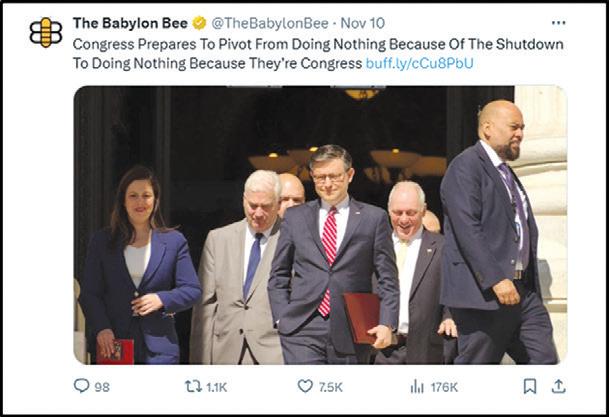



I think he made a mistake in going too far. He thought he could break the Republicans, and the Republicans broke him.
- President Trump talking about Sen. Minority Leader Chuck Schumer, after the government shutdown ended
I feel badly because I know Chuck Schumer. I’ve known him since he was a person who loved Israel, and now he’s a Palestinian. He’s become a Palestinian… I’ve never seen a politician change so much.
- ibid.

By Marc A. Thiessen
In a meeting with Senate Republicans last Wednesday, President Donald Trump called on them to get rid of the filibuster so they can reopen the government with a simple majority vote. “It’s time for Republicans to do what they have to do, and that’s terminate the filibuster,” he declared, adding, “If you don’t … you’ll be in bad shape.”
Trump is right much of the time, but he is dead wrong here. Terminating the filibuster would pave the way for Democrats to transform America into a Zohran Mamdani-inspired socialist dystopia.
Think I’m exaggerating? Consider what Democrats could do if they ever got unified control of government with a filibuster-free Senate, in which the Republican minority’s ability to delay or block legislation would be eliminated.
First, they could use their newfound power to cement their control – by packing the Senate, packing the House, packing the electoral college and packing the courts.
Democrats would certainly make the District of Columbia a state, creating two more safe Democratic Senate seats. They could also admit Puerto Rico, adding two more seats that probably would lean Democratic. Those seats would tilt the delicately balanced chamber decisively in the Democrats’ direction.
They could also pack the House by expanding the size of the lower chamber. Because House seats are apportioned by population, generally more populous blue states would gain the most seats. Since the

number of competitive House seats has steadily declined, this would allow Democrats to employ aggressive gerrymandering to create a virtually unbreakable House majority.
This would also allow them to shift the electoral college. Because the size of the electoral college is determined by the size of each state’s Senate and House delegations, they would be able to increase the number of blue-state electors as well. The electoral-college weight of Senate seats –equal among all states under our federal system – would be diminished, while the weight of House seats would rise. And if D.C. and Puerto Rico were added as states, the Democrats would add to their strength in the House (with new members from both places) and electoral college (six or seven new votes for Puerto Rico) even further. At the very moment Republicans are set to gain both congressional seats and electoral votes after the 2030 census, ending the filibuster would allow Democrats to thwart these changes, and make it harder for the GOP to win the White House again.
Then, to lock in their political control, Democrats would surely pass the sweeping federal takeover of U.S. elections they tried to enact under President Joe Biden – which was stopped only thanks to a GOP filibuster. With that obstacle eliminated by Republicans, Democrats would have the power to force all states to permit automatic and same-day voter registration; count mail-in votes that arrive up to 10
days after Election Day; allow third-party ballot harvesting; allow felons to vote; and count votes cast in the wrong precincts – all while making it harder for election officials to review and remove ineligible voters from the rolls.
Republicans might try to challenge these moves in court. Good luck with that. Democrats would almost certainly use a filibuster-free Senate to pack the Supreme Court – passing their legislation to add as many as six justices, installing an activist liberal majority to protect their constitutional overreach.
Once they have consolidated their lock on political power, they could then enact every piece of socialist legislation that GOP filibusters help to block. Green New Deal? Check. Medicare-for-all? Check. Tuition-free college? Check. Restrictions on second amendment rights? Check. Taxpayer-funded abortion up until birth? Check. Fracking ban? Decriminalizing border crossings? Free government-funded health care for illegal migrants? Check, check, check. Without the filibuster, they would have the ability to pass anything they wanted without compromise or concessions.
Trump says getting rid of the filibuster would allow Republicans to enact their agenda. With a filibuster-free Senate, Democrats could reverse virtually every Trump achievement and then take nationwide Mamdani’s radical agenda for New York.
And if Republicans ever did find a way around these obstacles to regain power, don’t assume they could easily reverse the
changes Democrats make. Statehood has never been revoked in U.S. history. No Supreme Court justice has ever been removed from office. And big government is a oneway ratchet. Once Democrats pass new entitlements, they will never be repealed. Why on earth would Republicans give Democrats the power to do all this? And for what? To pass a continuing resolution that keeps the government funded at Biden-era spending levels?
Trump is rightly frustrated that Democrats refuse to pass almost anything on a bipartisan basis. That is precisely the reason to keep the filibuster. Giving a party that has lurched so far to the left the power to enact its agenda, and lock Republicans out of power, would be suicidal for the GOP and the republic.
The filibuster is one of our democracy’s last and most important institutional guardrails – one that has kept our country centrist and stable. It protects us from tyranny of the majority that James Madison warned against by requiring some modicum of compromise and bipartisanship. Eliminating that guardrail would be a license for extremism. It would allow Democrats to radically transform our country on party-line votes - while making it difficult for Republicans to win control of Congress or the White House ever again. So, no, Republicans should not terminate the filibuster. If they do, America might never recover.

By Steven Erlanger

President Donald Trump insists that U.S. strikes “obliterated” Iran’s nuclear enrichment program this summer, but regional officials and analysts have become less convinced in the months since, and they warn another outbreak of war between Israel and Iran is only a matter of time.
The 2015 deal intended to limit Iran’s nuclear enrichment expired last month. Tough sanctions on Iran have been restored. Negotiations on its nuclear program appear to be dead, at least for now. And Iran’s stockpile of highly enriched uranium, enough to make 11 nuclear weapons, is either buried under rubble, as Iran claims, or has been spirited away to a safe place, as Israeli officials believe.
Iran also appears to be continuing to work on a new enrichment site known as Pickaxe Mountain. It has refused to give international inspectors access to that site or any other suspected nuclear sites other than those already declared.
The result is a dangerous stalemate — with no negotiations, no certainty over Iran’s stockpile, no independent
oversight. And many in the Persian Gulf region believe that makes another Israeli attack on Iran almost inevitable, given Israeli officials’ long-held view that Iran’s nuclear program is an existential threat.
Iran is likely to respond to any Israeli attack in a far less restrained way than it did in June, said Ali Vaez, the Iran project director at the International Crisis Group. Iranian officials have told him that missile factories are working 24 hours a day, he said, and if there is another war, “they hope to fire 2,000 at once to overwhelm Israeli defenses, not 500 over 12 days” as they did in June.
There is no evidence that a new attack is imminent. But “Israel feels the job is unfinished and sees no reason not to resume the conflict, so Iran is doubling down preparedness for the next round,” he said.
Iran is more isolated from the West than it has been in decades. Arab regional powers like Saudi Arabia, Egypt and the United Arab Emirates have enhanced their influence over Washington and Trump, partly through economic
ties and partly through their willingness to work with the United States to try to find a lasting settlement to the Israel-Hamas war. The new president of Syria is headed to the White House on Monday to seek American support.
Syria had been a strategic ally of Iran’s under the Assad government that collapsed last year.
At the same time, those regional powers are working to preserve their own relationships with Iran, said Sanam Vakil, the director of the Middle East and North Africa program at Chatham House. They do not want another regional war, and they respect Iran’s ability, however weakened, to create instability through its own military forces and through proxies in Lebanon, Iraq, Yemen, the Persian Gulf and elsewhere, she said.
“Iran is weaker than at any point since the U.S. invasion of Iraq, but not so weak as to be irrelevant,” said Suzanne Maloney, an Iran expert and the director of the foreign policy program at the Brookings Institution. “A weaker Iran is easier for the Gulf states to
engage and keep close because Iran, in its desperation, could become more dangerous.”
Israeli officials have warned since June that they are prepared to attack Iran again if it moves closer to producing a nuclear weapon, an intention Iran has always denied. The Israelis recognize that Iran’s nuclear program has been degraded but not destroyed, partly because Trump stopped the June war sooner than Israel wanted.
“Israel wants to ensure that Iran’s nuclear program is contained, and they won’t get it through negotiations, so I suspect the Israelis intend to strike again,” said H.A. Hellyer, a senior associate at the Center for American Progress in Washington and at London’s Royal United Services Institute. “The Iranians are rebuilding, but once they are past a certain line, Israel will attack again.”
The Arab states are also eager to work with Trump to ensure some restraints on Israel, which has ambitions to be a regional hegemon after devastating the Gaza Strip, Hamas and Hez-
bollah and damaging Iran. Arab officials are encouraging new nuclear talks between Iran and the United States, but with little optimism for now.
Iran’s supreme leader, Ayatollah Ali Khamenei, said Tuesday that American hostility to Iran is deep-seated.
“America’s arrogant nature accepts nothing but surrender,” he said in an address to mark the anniversary of the takeover of the U.S. Embassy in Tehran on Nov. 4, 1979.
His remarks seemed designed to block any new negotiations with the United States on Iran’s nuclear program.
Last week, Foreign Minister Abbas Araghchi of Iran said that Washington had offered “unacceptable and impossible conditions,” including direct talks and a complete, verifiable halt to Iran’s enrichment of uranium. He again rejected direct talks and an end to enrichment.
But he repeated that Iran remained open to indirect talks under certain conditions. They include a guarantee of no further military attacks or economic pressure and compensation for
war damage, demands Washington is unwilling to accept. Speaking to Al Jazeera, Araghchi also warned Israel of “dire consequences” for any future attack.
With the diplomatic deadlock, a debate is underway in Iran about how to move forward, with few good options, Vaez said. Some Iranian officials want to compromise and make a deal with
Trump, who pulled out of the 2015 nuclear deal and angered Iran yet again by bombing it to help Israel in the middle of another set of nuclear negotiations.
But both camps consider another round of confrontation with Israel inevitable, he said. “So the country is doubling down on preparedness for the next round, and they want it to produce a new equilibrium that will wipe out the
Iran is likely to respond to any Israeli attack in a far less restrained way than it did in June.
Trump. They argue that Iran cannot even keep the lights on, and that further resistance plays into Israel’s hands and could break the Iranian government given pressure from below.
Others favor confrontation, he said, believing it impossible to deal with

sense of Iranian weakness,” Vaez said.
Rafael Grossi, director of the International Atomic Energy Agency, told The Financial Times last week that the organization believes that the majority of Iran’s stockpile of highly enriched uranium survived the war, but that its
status is unclear without inspections. He estimated that Iran has roughly 400 kilograms of 60% enriched uranium, which is close to weapons grade.
Currently, the region’s Arab nations are focused on Gaza, Vaez said. While a nuclear Iran remains a concern, the Saudis are trying to enhance their security with a mutual defense treaty with Pakistan, signed in September, and hopes for U.S. security guarantees like Qatar got after Israel bombed Hamas leaders there, prompting Trump’s fury.
There are nuances in the regional positions, Vakil argued. The perception of Iranian weakness and retreat translates into an opportunity to get Tehran to step back from support for its proxies in a more formal way. The Gulf states are thinking of the longer term, she said.
“There is a window of opportunity for more compromises with Iran weaker and more isolated,” she said. “And there is worry that in another round of the Iran-Israel war, Iran would be less restrained.”
© The New York Times


Some of Tucker Carlson’s defenders and apologists have argued that the backlash against the former Fox News host-turned-podcaster isn’t really about antisemitism.
Given the cozy interviews he’s granted to neo-Nazi “groyper” Nick Fuentes and Holocaust-denier “historian” Daryl Cooper—and his willingness to invite anyone on his show that will promote blood libels against or otherwise smear Israel—that’s not an argument anyone should take seriously. There’s no doubt that Carlson, like so many on the left, are determined to move the Overton Window of acceptable discourse so as to make it acceptable to engage in a wide variety of antisemitic tropes aimed at stigmatizing Jews and anything to do with the Jewish state.
But it’s also true that there is an ongoing debate about foreign policy in which Carlson’s efforts to aid the cause of delegitimizing the Jewish state and its supporters is playing a significant role. As Carlson has made clear, the ultimate target of his attacks isn’t really Jews or even the state of Israel. He’s just as, if not more, interested in taking down Americans who support it, thereby altering American foreign policy in the Middle East.
If he is to be stopped, it won’t be because conservative supporters of the U.S.-Israel alliance like Sen. Ted Cruz (R-Texas) speak up in defense of Israel and its friends. Rather, it will be because Vice President JD Vance, who is not only Carlson’s avowed friend and ally, as well as a frontrunner for the Republican presidential nomination, does so.
The phrase Carlson uses is “Israel First,” which is an attempt to disparage anyone who backs the U.S.-Israel alliance as not merely unpatriotic but also somehow at odds with President Donald
By Jonathan S. Tobin

Trump’s “America First” foreign policy.
The expression is essentially an antisemitic trope about dual loyalty and is linked to other ones about Jews buying influence.
That’s why, rather than maintaining silence about Carlson’s most recent platforming and coddling of a neo-Nazi, the vice president needs to show that he is prepared to challenge allies to his right. If he fails to do so, it will not only hurt the country; it will also harm Vance’s own chances of following Trump into the Oval Office.
The “Israel First” smear delineates the distinction between the contemporary right-wing version of Jew-hatred from the even more potent one on the left.
Both are rooted in toxic myths.
Leftists are wrong to think of the Jewish state as either “white” or a manifestation of imperialism, since the Jews are the indigenous people of Israel. But left-wingers, like New York City Mayor-elect Zohran Mamdani, hate Israel because they see it through the lens of their mindset in which the world is divided between two groups:
people of color who are always victims no matter what they do, and “white” oppressors who are always in the wrong.
Progressives have successfully indoctrinated a generation of young Americans to believe in critical race theory, intersectionality and settler-colonialism. As a result, their mischaracterization of the genocidal Palestinian-Arab cause of destroying Israel as justified resistance to racism has become something close to orthodoxy for most liberals.
Unlike the left, the overwhelming majority of American conservatives do not hate Israel. Nor are they antisemitic.
But a growing and increasingly loud minority on the right who are hostile to Israel view it as being part of a conspiracy to undermine American sovereignty. They regurgitate Carlson’s canards about Israel’s supporters—both Jews and evangelical Christians— wrongly manipulating the United States into conflicts in which it has
no stake. Some of them also believe this is a threat to Christianity and white supremacy. Their support comes from a group of predominantly male youngsters who are influenced by the likes of Carlson, podcaster Candace Owens and the vile Fuentes.
Which faction poses the greater threat to what is left of what was once optimistically termed as a bipartisan pro-Israel consensus? And how do we reach and persuade either variety of Israel-haters—whether on the left or the right—that they’re wrong?
It’s easy to see the left as a greater problem simply because it now dominates the Democratic Party.
The intersectional left-wing base of the Democrats is in thrall to the ideologues who falsely analogize the Palestinian war on the Jewish state as a rerun of the American civil-rights movement. Faith in that distorted understanding is so deep that nothing Israel’s opponents do—including the atrocities of Oct. 7, 2023 and a century of rejection of every attempt at compromise, including offers of Palestinian statehood—can make them realize that they are backing a genocidal cause rooted in hatred of Jews. Nor do they seem to care that the side they’re on is reactionary Islamist one that opposes all of their other progressive beliefs about society, including [alternative lifestyles] and women’s rights.
Such people not only dominate party activism. They also virtually monopolize the ranks of liberal journalism, thus amplifying their ability to control the discussion in the mainstream media about the Middle East.
Pro-Israel Democrats, such as Sen. John Fetterman (D-Pa.), are an increasingly small minority out of step with the rest of their party. So are moderates, like Pennsylvania Gov. Josh Shapiro, who, while deeply critical of the Jewish state, are still supportive of the alliance. But, despite the hopes of Shapiro and other non-leftists
who will hop into the race in the next two years, it’s increasingly likely that the next Democratic president, whether in 2028 or some point in the future, will not merely be a half-hearted ally, as was the case with Joe Biden, or unfriendly in the manner of Barack Obama, but an open and unabashed foe of Israel in a way that is unprecedented.
As dire as that prospect is for Israel-supporters, there is a strong argument that the threat from right-wing Israel-haters is just as dangerous heading into the next presidential election cycle.
Given that Trump is the most pro-Israel president since the founding of the modern Jewish state, and that the base of the GOP is largely evangelical and devoted to the welfare of Israel, that doesn’t make sense. Unlike the case with the Democrats, the Republican GOP congressional caucuses in the House and Senate are both strongly supportive of Israel.
But it would be a mistake to underestimate the potential of those who cheer on Carlson and his even more extreme Israel-haters and antisemites to influence discourse on the right.
Indeed, as Vance’s response to a question from a student at a Turning Point USA event at the University of Mississippi indicated, signs of real trouble are on the horizon. The student asked why the United States supports Israel and gives it “hundreds of billions of dollars.” He also questioned both the value of the alliance and repeated slanders about “ethnic cleansing” in Gaza (falsely attributed to the late Charlie Kirk) and claimed that not only did Israelis practice a different religion but “openly support the prosecution of ours.”
Vance could have shot down the lies about “ethnic cleansing” and Israeli persecution of Christians, not to mention the exaggeration of the extent of the military aid it gets. But he didn’t. Instead, he did his best imitation of former Vice President Kamala Harris’s kowtowing to the libels of leftist Israel-haters during last year’s campaign. He expressed sympathy with the student and asserted that the Trump administration wasn’t getting bossed around by Jerusalem.
A “Post-Israel” America?
It’s that kind of answer from a politician who is fully capable and willing to challenge critics and questioners when they are in the wrong that encouraged the paleocon American Conservative magazine to ponder whether Vance will be the one to “lead a post-Israel America.”
That may be wishful thinking. After
all, Vance made a compelling case last year that the Jewish state was a model ally for an “America First” administration, since it is willing to do its own fighting and has shared interests with the United States. But right now, he seems more interested in maintaining his close friendship with Carlson and appealing to the audience who watches him and other far-right podcasts than in telling the truth about the antisemitic libels directed at Israel.
The populist national conservative wing of the GOP seems to be increasingly worried about its young voters being under the influence of antisemites.
That was on display in the last few weeks as the Heritage Foundation think tank failed to fully dissociate itself from
ciful to imagine Vance, who has an early but impressive lead in the race to succeed Trump in 2028, disabusing young conservatives of the myths that Carlson or Fuentes have been feeding them.
As someone who has opposed an unlimited U.S. commitment to the war in Ukraine and the need to prioritize the coming threat from China, he has the standing to take the opportunity to reiterate the arguments for the alliance with Israel at a time when many on the right look to him for leadership to defend the conservative movement from antisemites.
He could point out that, contrary to Carlson’s assertions, the United States benefits enormously from security cooperation, joint weapons and technology development
The longer Carlson and those on the right who share his obsessive hatred of Israel are allowed to expand their foothold in mainstream conservative discourse, the stronger they will grow.
Carlson. Others on the right, such as Megyn Kelly and Matt Walsh, who are more interested in bashing those who care about Israel and antisemitism than in criticizing even the craziest of Jew-haters like Owens, seem to agree that a neo-Nazi of Fuentes’s ilk speaks for the concerns of many, if not most, young conservative males. Support for engagement with Fuentes and his followers, rather than condemnation of them, is a disturbing abandonment of principles.
As conservative thinker Rod Dreher noted in his Substack, he’s now convinced that “between 30 and 40 percent” of the Zoomers who work in official Republican Washington are fans of Nick Fuentes.” If the actual number is anywhere close to that number, it isn’t merely shocking. It’s something that ought to be setting off alarms among those who have confidently assumed that the right was immune to antisemitism, especially when compared to the political left.
It’s hard to imagine anyone with a strong following on the left, like Rep. Alexandria Ocasio-Cortez (D-N.Y.) or others in the Congressional left-wing “Squad,” pushing back against the intersectional myths about Israel’s being a “white” oppressor or asserting that Jews aren’t the indigenous people of Israel. But it ought not to be fan-
18th in direct contributions to candidates and 21st in outside spending.
By contrast, Qatar is operating a vast influence operation in the United States that encompasses not just direct contributions, but also the Islamist propaganda broadcast on its Al Jazeera network. It also involves buying the loyalty of American businessmen such as Trump envoy Steve Witkoff and journalists like Carlson. It invests heavily to subvert American higher education, to which it is the largest foreign donor.
This invidious campaign aims not only to promote the emirate’s financial and political interests, such as supporting its terrorist clients like Hamas. It also seeks to spread Islamist beliefs among U.S. Muslims and secular college students that are antithetical to the values of Western civilization that conservatives believe in and wish to defend against the effort by woke progressives to tear down.
Anyone who worries about defending biblical values or putting American interests first ought to be sounding the alarm about Qatar. And this means all those who tap into the deep religious, ethical and political support for Israel as AIPAC does, especially conservative Christians.
and intelligence-sharing with Israel.
He could make it clear that almost all of the billions in military aid that Israel receives is spent in the United States and that assisting American arms manufacturers is just as crucial for the U.S. as it is for the Jewish state.
He could also argue that far from persecuting Christians—a lie that Carlson floated in an interview on his program with the Israel-hating sister of former Clinton administration staffer and ABC News host George Stephanopoulos—the Jewish state is the only country in the Middle East where Christians can live and worship freely. That’s something unimaginable in virtually every Muslim and Arab country, including Qatar, which Carlson falsely lauds as a true American ally.
He might also note that the smears against the pro-Israel AIPAC lobby that are frequently repeated by users of the term “Israel Firsters” are similarly mendacious. Contrary to its detractors and some of its supporters who have also exaggerated its influence, AIPAC is not only not the dominant force in Washington; its efforts are dwarfed by those of other special interest groups, ranking 191st in direct lobbying,
But the vice president seems to be making a political calculation that he can’t afford to alienate Carlson’s and Fuentes’s fans if he is to secure the support of the right in future races.
That’s unfortunate and not just because at a time of an unprecedented surge in American antisemitism, the country needs moral leadership. It’s potentially dangerous because the longer Carlson and those on the right who share his obsessive hatred of Israel are allowed to expand their foothold in mainstream conservative discourse, the stronger they will grow.
That will not only fuel the kind of Jew-hatred on the right that we now take for granted on the intersectional left. But it will lend legitimacy to the anti-Israel Democrats who have so much in common with Carlson and fumble a GOP opportunity to seize the political center from a party that treats extremists like AOC and Mamdani as rock stars and their future leaders.
Repudiating the far-right won’t deprive Vance of the votes he needs to obtain the 2028 GOP presidential nomination. But it could cost him the general election if he makes the same mistake as Harris did in 2024: allowing himself to be captured by extremist allies.
Many years ago, I attended a chess match at a local chess club. We were watching two grandmasters play for a big money prize. I, along with all the other observers, were mere chess buffs and were nowhere near the level of the players we were observing. Suddenly, in the middle of the match, one of the players made a surprising move that elicited groans and looks of bewilderment from the crowd. Even the analyst who was explaining the moves seemed to be at a loss. It was incomprehensible and seemed to be an egregious error that could cost him the match. However, to our surprise, a mere three moves later, his opponent abruptly stood up, shook his hand and left!
We were all dumbfounded! After studying the board for a few minutes, our analyst suddenly nodded knowingly and broke into a broad smile. He then explained the logic of the perplexing move which caused his opponent to suddenly resign. As he played out the rest of the game for us, we suddenly realized that what had seemed to be a foolish and incomprehensible move suddenly became a stroke of genius.

By Country Yossi
Toiv

“My ways are not your ways,” saith the L-rd!
Hashem’s plans and methods are inscrutable. The road to Moshiach has from antiquity been cloaked and hidden in mystery and intrigue. From Lot and his daughters to Yehudah and Tamar and on to Rus and Boaz, the royal lineage of Malchus Bais Dovid has defied easy comprehension.
coming weeks and months.
Hashem is the ultimate Grandmaster and as we watch His dramatic moves on the global chessboard we can only gaze in shock and awe as we struggle to comprehend the Master plan.
Yes, a proud, outspoken, antisemitic, anti-American Muslim socialist has just become the next mayor of the greatest city in the world, home of the greatest
We suddenly realized that what had seemed to be a foolish and incomprehensible move suddenly became a stroke of genius.
We cannot fathom all the unknowable twists and turns still to come in the incredible journey of the royal soul of King David as it wends its way through history to the End of Days scenario. As we have seen, no one can predict what the next moment holds, let alone the
assemblage of Jews besides Israel, and we stand shocked, bewildered and fearful at what this portends for the future. Who knows what evil machinations and dark days lie ahead?
But rest assured. Like our ancestors as they stood trapped with the mighty
sea before them and the fearsome Egyptian army behind them, they were suddenly saved by miraculous, divine intervention as the sea split. So too, today, as we stand surrounded by rising, virulent antisemitism, unchecked looting, shamelessness, lawlessness, in-your-face immorality and the imminent collapse of western society, we stand poised and ready for Hashem’s master stroke. It’ll be a move so dramatic and unforgettable that on that day the entire world will shout in unison...
“Hashem Hu Ha’Elokim!”
So while the match is still being played, it is futile to try to understand every move.
His ways are not our ways!
None of us are grandmasters of the divine plan. Only when the game is finally over will we be able to look back over our entire history and see the genius in every move.
So, sit back, relax and watch the match. We may not understand the significance of every move, but we already know the pre-ordained outcome. We know who’s going to win! Chazak, chazak, v’nizchazek.

By Avi Heiligman

The use of helicopters in warfare started in World War II after it had been invented in 1939 by Igor Sikorsky. Introduced to frontline units at the end of the war, its first mission was in January 1944 to deliver blood plasma to survivors of a ship’s explosion. The first successful rescue mission took place in Burma in April 1944. The helicopter landed in the mountains where it was difficult to send troops in to rescue a downed pilot and three British soldiers. Helicopters became more popular for combat missions during the Korean War, but it was during the Vietnam War that a particular helicopter changed the way operations were conducted on the battlefield. The Bell UH-1 Iroquois, also known as the Huey, became one of the most prolific helicopters in history and performed some of the most heroic missions of the Vietnam War.
The Huey’s first flight was in 1956 after the U.S. Army announced that Bell won the contract for a new helicopter. The army needed a multi-use general purpose helicopter that wasn’t too large, was easy to maintain, and could stand through the rigors of combat. It entered service in 1959, and the UH-1D, the Model 205, first flew
operationally in 1963. Over 16,000 were built and are still in use today. Typically, they have four crewmen, a top speed of 127 mph, and carries machine guns and rocket pods for offensive fire power.
Hueys were used for a wide array of missions including air assault, medical evacuation (Medevac), close air support
difficult terrain and provide fire support when called upon.
Pilots were needed in large numbers to fly the large amounts of helicopters coming off the production lines. Born in 1930 in Michigan, Charles Kettles answered the call to become a helicopter pilot. Previously serving in Korea and other
Undeterred by the damage and the enemy fire, he expertly maneuvered the over-weighted Huey out of the danger zone and brought all eight soldiers back to safety.
Aviation Battalion, Americal Division.
for ground troops, reconnaissance logistics and resupply. Inserting large numbers of troops into remote or hard-to-reach areas would be difficult as the roads were often primitive or non-existent in some cases.
The U.S. developed the idea of air cavalry using helicopters, mainly Hueys, to insert infantry, often called sky troopers, into
Far-East locations, Kettles came from an aviation background as his father was a World War I and World War II pilot. He first qualified to fly fixed wing aircraft before training to fly a Huey. Now a major, Kettles was sent to Vietnam as a flight commander with the 176th Aviation Company (Airmobile) (Light), 14th Combat
On May 15, 1967, Kettles volunteered to lead a flight of six Hueys to rescue personnel from the 1st Brigade, 101st Airborne Division. The Americans had been ambushed by a battalion-sized force of North Vietnamese in the Song Tra Cau Riverbed. Enemy forces were dug in well-fortified positions and were attacking with machine guns, automatic weapons and mortars. American casualties were mounting so Kettles’ helicopters were called into bring in reinforcements and medevac the wounded. Enemy fire raked the helicopters as they were landing and caused more casualties as the soldiers were exiting the choppers. Despite damage to his aircraft, Kettles stayed on the scene until the reinforcements dismounted and the wounded were loaded. The helicopters then flew to the staging area to pick up more reinforcements and went back to the battlefront to drop them off. This time, his gunner was hit, but he skillfully coaxed his fuel-leaking helicopter back to base.
The battle wasn’t going well for the Americans so the battalion commander called for immediate extraction. There were about forty soldiers on the ground


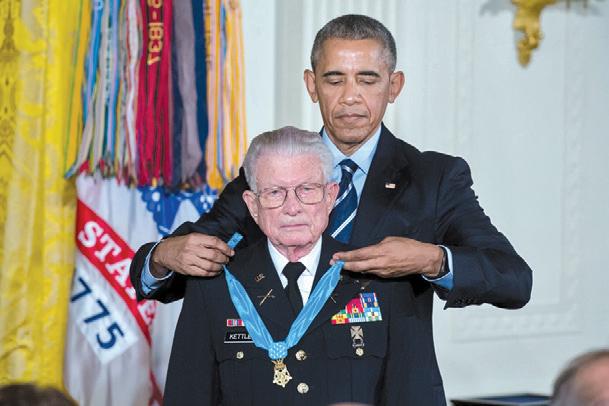
as well as four crewmen from Kettles’ unit whose helicopter had been shot down. For the third time that day, Kettles led a flight of Hueys to the battlefield the soldiers nicknamed Chump Valley. Since his Huey was the only one in his company that was still flyable, he was joined by five others from the 161st Aviation Company. They were supported by American gunships and the evacuation went according to plan – almost.
On the way back, Kettles was informed that eight troopers who had been pinned down by heavy enemy fire had been left
behind and were now stranded. Without hesitation, Kettles turned around his Huey while instructing the other helicopters to return to base. Enemy fire concentrated on Kettles’s lone Huey as he had no other air support. Bullets damaged several parts of the helicopter including the windshield rotor blades and the tail boom. Calm and collected, Kettles held steady until all eight remaining soldiers were on board. Undeterred by the damage and the enemy fire, he expertly maneuvered the over-weighted Huey out of the danger zone and brought all eight soldiers back to safety. The ground

crew counted forty holes in his Huey. His battlefield bravery saved the lives of the eight soldiers who would have otherwise been left on the battlefield.
Kettles wasn’t the only hero during the mission as the other helicopter crewmen were vital in the rescue of the soldiers. Kettles later said of the operation, “We got the 44 out. None of those names appear on the wall in Washington. There’s nothing more important than that.” Other crewmen were awarded medals including the Silver Star, and Kettles received the Distinguished Service Cross. In 2016, his award was up -
graded to the Medal of Honor. Helicopter pilots in Vietnam routinely flew missions directly into enemy territory. Their courage and bravery in face of extreme danger saved countless lives, and for that, these Forgotten Heroes deserve to be remembered.
Avi Heiligman is a weekly contributor to The Jewish Home. He welcomes your comments and suggestions for future columns and can be reached at aviheiligman@gmail.com.

DU N DURT
Power & Soft Washing
We clean siding, stucco, decks, driveways, concrete, pool patios, pavers & sidewalks. Say goodbye to grime, mold & allergens! Call/WhatsApp: 718-688-2964
Email: dundurtny01@gmail.com
VACUUM SALES AND REPAIR
All areas call Max Flam 718-444-4904
THE LEATHER SHOPPE
The spot for all your custom leather Judaica. Tallis/tefillin bags, lulav and esrog bags, havdallah sets, challah covers, shtenders, pesach sets, matzah/afikomen bags. WhatsApp: (732) 523-0007 or email: theleathershoppe732@gmail.com for a full catalog. We ship.
PEACEFUL PRESENCE STUDIO
Men’s private yoga, Licensed Massage & Holistic Health Guidance 436 Central Ave, Cedarhurst Info. & free video training www.peacefulpresence.com 516-371-3715
DIAL-A SUB-LEGENDARY & experienced teachers available for emergencies. Substitutes teaching all subjects.
$180 per day. Payment a must before entering a class. Please call (516) 265-4872
GERBER MOVING
Full Service Moving Packing Moving Supplies
Local Long Distance. Licensed Insured 1000’S Of Happy Customers Call Shalom 347-276-7422
HANDYMAN AVAILABLE
For big or small jobs, Sheetrock, carpentry, painting, electrical, plumbing, install & repair appliances Call Ephraim at 347-593-4691
MANAGEMENT STAFF WILL ASSIST
you with:
* Obtaining Medicaid and Pooled Income Trust
* In-home Assessments, Individual and Family Counseling
* Securing reliable home care assistance
* Case and Care Management services Dr. S. Sasson, DSW, LCSW (718) 544- 0870 or (646) 284-6242
Traveling EMT
For school trips & Shabbatons, hotels, all social events. last summer was sold out! Make reservations early! Please call (516) 265-4872
HAIR COURSE:
Learn how to wash & style hair & wigs. Hair and wig cutting, wedding styling Private lessons or in a group Call Chaya 718-715-9009
ZEVIZZ WOODTURNING JUDAICA
Challah knifes, batei mezuzah, besamim holder, kiddish cups, havdalah candle holders, yad for sefer torah, pens, stenders, bowls and more 952-356-2228
MY MOTTO IS DON’T WAIT TO buy real estate
Buy real estate and wait Your realtor for life 516-784-0856 Alexandra at Realty Connect USA
PRIVATE DRIVER AVAILABLE For all your needs. Reliable. Safe. Experienced and Trustworthy Call Yaakov 917-825-7057
REAL ESTATE MANAGEMENT Services – Do Not Manage Your Properties Alone! Contact Aliyah Suites for all your real estate management needs and affordable office space near you! (516) 366-1049 Management@aliyahsuites.com Marc Jeret (MJ) Team Leader & Licensed Real Estate Agent



















CEDARHURST
Prime Restaurant Location For Lease.
For more information: Call/Text/WhatsApp Owner: (516) 206-1100
Don’t Get Stuck With a Two Story House Ya Know, It’s One Story Before You Buy It But a Second Story After You Own It!
Call Dov Herman For An Accurate
Unbiased Home Inspection InfraredTermite Inspection
Full Report All Included NYC 718-INSPECT
Long Island 516-INSPECT www.nyinspect.com
ZAREINU
Is seeking a Co-Rebbe position for this year for a sixth and seventh grade boys class in a local Yeshiva. Great pay! Warm environment with administrative support! E-mail resume: info@zareinu.org or call 718-406-8343 ext 229
ZAREINU
Is seeking an assistant Rebbe position for this year for a sixth and seventh grade boys class in a local Yeshiva. Great pay! Warm environment with administrative support!
E-mail resume: info@zareinu.org or call 718-406-8343 ext 229
DELIVERY PERSON NEEDED to deliver this Newspaper every Thursday morning to locations in Brooklyn. Must have Mini van or SUVand availability to work Consistently every week. Good pay - Please email gabe@fivetownsjewishhome.com or call (917) 299-8082








REGENTS EXPERT
Tutoring regents in Algebra and Geometry A Darchei Torah instructor. Guaranteed results Text 347-491-8045
WhatsApp 347-767-1755
SEEKING ELEMENTARY TEACHERS and assistants for General Studies for the ‘25-’26 year. Assistants should have skills to take over for teachers if needed. Far Rockaway area boys’ school, M-Th, PM hours, strong support. Excellent salary. Send resume to teachersearch11@gmail.com.

YESHIVAT KOL YAAKOV
In Great Neck, NY, is seeking general studies teachers for both the elementary and middle schools, for the upcoming academic year. Mon-Thur afternoons. Competitive salary, warm and supportive environment. Send resume to m.kalati@kolyaakov.org
MDS REGIONAL NURSE
5 Towns area Nursing Home management office seeking a Regional/Corporate level MDS Nurse to work in our office. Must be an RN. Regional experience preferred. 2-3 years MDS experience with good computer skills required. Position is Full Time but Part Time can be considered. Great Shomer Shabbos environment with some remote options as well. Email: officejob2019@gmail.com
A multi-tasker needed for general office work. The ideal candidate is someone who is detail-oriented, responsible, and can take ownership. Looking for someone who is eager to learn, and expand his/her skill set while possessing the ability to work independently and as part of a team. Experience with Excel required. Five Towns location. In-office position only, not remote. Please send resume to 5tpart.timecareer@gmail.com
A Five Towns Real Estate Company is seeking a full-time Bookkeeper. The right candidate must be proficient with QuickBooks and Excel. They must also be self-motivated, organized, detail oriented, reliable, and able to work independently or as a team player. Warm, frum office environment with excellent salary & benefits. Please email resume to HR@capsprop.com

HASHAVAS AVEIDA
Apple airpods found on Wednesday morning on the way to the Woodmere dock. To claim, 516-351-8105.
Text 516-303-3868 with a time slot of your choice to be careful on lashon hara. Be a part of the 1,000 people for klal yisroel!
BEIS HAMEDRASH CONG.
Chasdei Uvois Oshpitzin
Talmidei chachomim are willing to learn mishnayos, say kaddish and be the shliach tzibbur to daven for the umid on the yartzeit yom hashanah of your parents or close relatives or loved ones To arrange please call
Rabbi Miller 917-445-6220

Are you all familiar with a Bikur Cholim room at a hospital?
I hope not.
Not because I don’t want to share the goodies they put out there with you when I’m there. Rather, I just don’t want you visiting loved ones at a hospital, of all places.
Of course, for a little bundle of joy, go for it.
But otherwise, I’d rather you’d be seeing people you care for at happy occasions, hangouts in the yard, barbecues – you know things like that.
But it’s still a very considerate convenience when a Bikur Cholim room exists, unfortunately, because often you wind up at the hospital without any plans to be there. Or you arrive fully overstocked, shlepping gifts, flowers, and supplies the patient requested – little do you have time or space to pick up a meal.
Not that we can’t survive a couple of minutes without a meal or a snack. But when it starts getting closer to 10 minutes or an hour, or two or three… I mean, we are only human!
And thus, the special gift of this well-stocked room becomes integral and amazing.
Literally, heaven sent. There are even
By Rivki D. Rosenwald Esq., LMFT, CLC, SDS

siddurim and learning books there to devour, in addition to the food and drink.
Now, here’s one of the challenges, though. Finding this sacred room is not that simple.
Somehow, every hospital has at least one endless corridor, followed by winding hallways that lead in circles or to some off-limits or deserted area. And when you are looking for this room, you inevitably tour all these hallways.
They are referring to the series of Hebrew letters creatively put there as a code so only Hebrew alphabet-aware people can get in and drain the donated supply.
And when you actually get there, you’ve got no idea of the order to input the letters anyway.
No easy feat.
The order is never quite clear. Press turn, press turn. Redistribute. Push together!
Some places might think a gezunta cholent and pastrami would be best, while others do salads and salmon.
Usually, you pass by it at least once, unknowingly, on your search.
At some point, hopefully, someone, seeing you pass in the hallway for the third time, will say to you, “Are you looking for that room with the funny letters on the door?”
That’s your signal to say, “YES! Thank you.”
Woof, finally you are in.
This haven is usually two-by-two.
But a lot is amazingly fit into it. There is a stocked fridge, a hot water urn with coffees and teas, a microwave, plates, utensils, and loaded shelves. There are all sorts of food and snacks and drinks to partake of.
Of course, not all Bikur Cholim rooms
are created equal!
I would surmise that depending on who’s supplying the food, the mains can probably be quite different. Some places might think a gezunta cholent and pastrami would be best, while others do salads and salmon.
The bottom line is that you feel cared for.
It may not always have just what you want – or be simple to locate – or to break into…
But the bottom line is that you know a fellow Jew is making sure in your time of need we’ve got you.
Sometimes, there’s even a chair or two or a table or little couch somehow miraculously fit in.
The main thing is that in a place where you feel a little alone, others are thinking of your needs and trying to ease the experience for you.
Rivki Rosenwald is a Licensed Marriage & Family Therapist working with both couples and individuals and is a certified relationship counselor. Rivki is a co-founder and creator of an effective Parent Management of Adolescent Years Program. She can be contacted at 917705-2004 or at rivkirosenwald@gmail.com.

